SIGÜENZA, arte por los cuatro costados
JOSÉ LUIS ALONSO DE SANTOS, Festival de Mérida
CAMINITO DEL REY, naturaleza en estado vertical



SIGÜENZA, arte por los cuatro costados
JOSÉ LUIS ALONSO DE SANTOS, Festival de Mérida
CAMINITO DEL REY, naturaleza en estado vertical


El verano es tiempo para detenerse, reconectar con lo esencial y disfrutar sin prisas de los placeres sencillos. Sus días largos, sus atardeceres dorados y sus noches serenas nos invitan a vivir experiencias únicas. En Paradores, queremos acompañarte en ese viaje porque tú, que valoras lo auténtico, el descanso con sentido y la belleza de lo cercano, eres parte esencial de esta historia que compartimos cada verano.
Antes de avanzaros algunos de los planes y contenidos de este número de nuestra revista, me gustaría daros una vez más las gracias a todos y todas vosotras, clientes y amigos que habéis vuelto a acompañarnos en esta primera mitad del año, donde nuestras cifras de ocupación han sido excelentes gracias a vuestra confianza.
Para seguir correspondiendo a esa confianza, continuamos invirtiendo en mejorar nuestra red. En este número te contamos el resultado de las reaperturas de algunos de nuestros Paradores más emblemáticos, como Sigüenza y Cardona, que vuelven a abrir sus puertas tras importantes inversiones destinadas a preservar su esencia y modernizar sus instalaciones. En Sigüenza hemos invertido 10 millones de euros en una profunda remodelación. El Parador de Cardona, situado en una magnífica fortaleza medieval, ha recibido una inversión cercana a los 3 millones de euros para asegurar una estancia aún más acogedora y accesible. En ambos casos, además, a estas actuaciones se han sumado las intervenciones a cargo de Turespaña, financiadas con Fondos Europeos del Plan de Recuperación, para la restauración patrimonial de ambos edificios.
Volviendo al verano, en estas páginas también te abrimos las puertas a experiencias para saborear cada instante. Desde las impresionantes vistas que ofrece el Caminito del Rey hasta el cielo infinito sobre nuestros Paradores Starlight, pasando por rutas a caballo, conciertos a la luz de las velas, travesías en canoa o viajes al interior de la tierra. Lugares que no solo se ven, sino que se escuchan, se sienten, se saborean.

Summer is a time to pause, reconnect with what is essential, and enjoy the simple pleasures without rushing. Long days, golden sunsets, and calm nights invite us to embrace unique experiences. At Paradores, we want to join you on that journey because you, who value authenticity, meaningful rest, and the beauty of what’s nearby, are an essential part of this story we share every summer.
Before introducing some of the plans and features in this issue of our magazine, I’d like to once again thank all of you, our clients and friends, for joining us during the first half of the year. Thanks to your trust, we’ve seen excellent occupancy figures.
To continue earning that trust, we remain committed to improving our network. In this issue, we share the results of the reopening of some of our most iconic Paradores, such as those of Sigüenza and Cardona, which welcome guests again after significant investments to preserve their essence while modernizing their facilities. In Sigüenza, we’ve invested 10 million euros in a full renovation. The Parador of Cardona, housed in a stunning medieval fortress, received nearly 3 million euros to ensure an even more welcoming and accessible stay. In both cases, these efforts were complemented by restoration work led by Turespaña and funded through European Recovery Plan grants, aimed at the heritage restoration of both buildings.
Recorremos con orgullo la herencia cultural que conmemoran las catedrales de Toledo y Segovia, y nos sumamos al Festival Internacional de Teatro Clásico de Mérida con una propuesta escénica y gastronómica que te transportará a otro tiempo.
También reforzamos nuestro compromiso con el medio ambiente a través de nuestra nueva línea de amenities y con la colaboración en la campaña
«El mar empieza aquí», impulsada junto a la Fundación Oceanogràfic. Además, te proponemos dejarte sorprender por la cocina de nuestros Espacios Gastronómicos –más fresca, más libre, más local– y descubrir lo bien que lo hemos pasado con proyectos como el Photowalk en Sos del Rey Católico, con la fotógrafa Lucía Herrero.
Este verano, queremos que cada momento en Paradores se convierta en una emoción, que sientas la historia bajo tus pies, el sabor de la tierra en tu plato, la infinidad del universo ante tus ojos, los sonidos del entorno en tus oídos y el aroma del bosque en tu piel; queremos que redescubras España con nosotros.
Te invitamos a comenzar ese viaje en las páginas de esta revista.
Returning to summer, these pages open the door to experiences designed to savour every moment. From the breathtaking views of the Caminito del Rey to the infinite skies above our Starlight Paradores, from horseback routes to candlelit concerts, canoeing adventures or journeys into the earth. Places not only to see, but to hear, to feel, to taste.
We proudly revisit the cultural legacy celebrated by the cathedrals of Toledo and Segovia, and we join the Mérida International Classical Theatre Festival with a stage and culinary proposal that will transport you to another time.
We also strengthen our commitment to the environment through our new line of amenities and our collaboration in the “The sea starts here” campaign, launched in partnership with the Oceanogràfic Foundation. What’s more, we invite you to be surprised by the cuisine of our Gastronomic Spaces –fresher, freer, more local– and to discover how much fun we had with projects like the Photowalk in Sos del Rey Católico, led by photographer Lucía Herrero.
This summer, we want every moment at Paradores to become an emotion. We want you to feel history under your feet, the taste of the land on your plate, the infinity of the universe before your eyes, the sounds of nature in your ears and the scent of the forest on your skin.
We want you to rediscover Spain with us.
RAQUEL SÁNCHEZ
PRESIDENTA DE PARADORES
En este número te contamos el resultado de las reaperturas de algunos de nuestros
Paradores más emblemáticos, como Sigüenza y Cardona, que vuelven a abrir sus puertas tras importantes inversiones destinadas a preservar su esencia y modernizar sus instalaciones
And we invite you to begin that journey in the pages of this magazine.
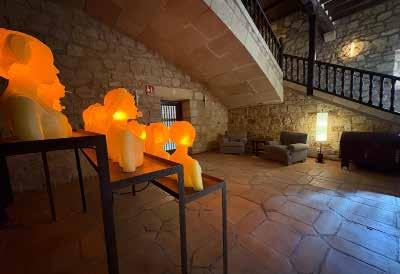
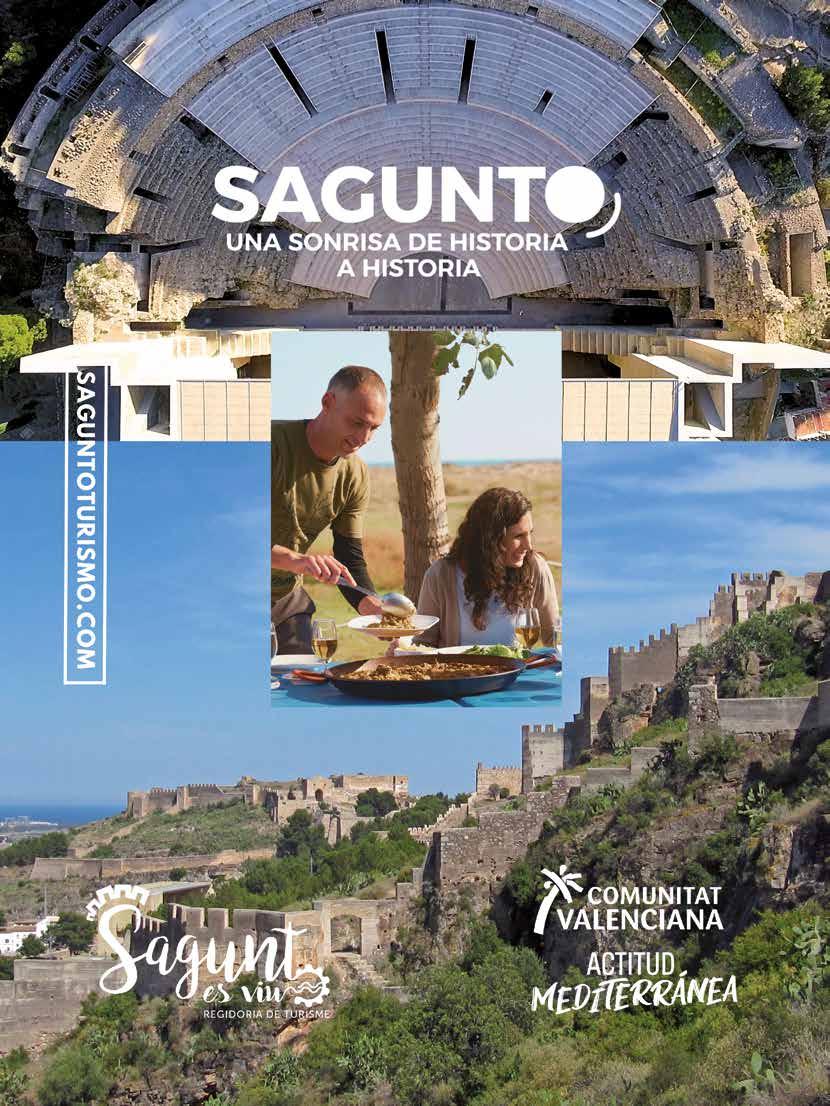
CARTA DE LA PRESIDENTA
Un verano para redescubrir España A Summer to rediscover Spain
NOVEDADES DE PARADORES 10
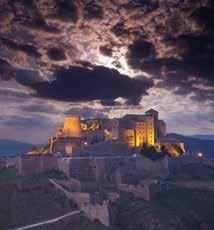
Un castillo en el que soñar despierto A Castle to Dream Awake
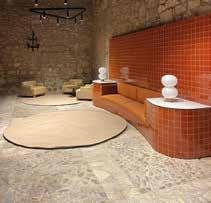


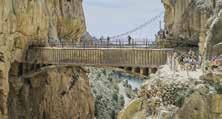
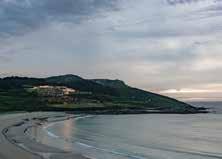
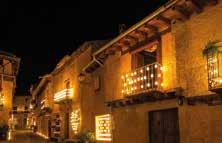
Entre mar, montañas y muralla: pistas para avivar el gusto
Between the Sea, Mountains, and Walls: Tips to Awaken the Senses
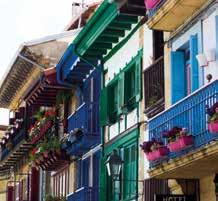

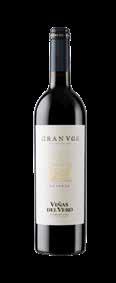
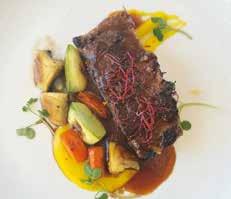
TEMPLOS EMBLE MÁT I COS
Catedrales de piedra y tiempo Cathedral of stone and time



ESCRITORA

Hospitalidad renovada. Renewed Hospitality
PHOTOW A LK 2025
Vecinos, cámara y acción. Neighbours, Camera, and Action AMENI T IES DE
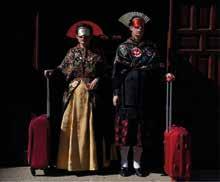


PRESIDEN TA
CO NSEJERADE LEG ADA Raquel Sánchez Jiménez
SECRETARIO GENE RAL Ricardo Mar Ruipérez
DIRECTOR A DE COMUNICACIÓN, RRII Y M A RC A Silvia Zancajo García
COORDINADOR A DE COMUNICACIÓN, RRII Y MARC A Alba Zafra Espejo
CO NSEJO EDI TOR IA L Conchi Antón Ana Martínez R EDA CC IÓN Y TRAD UCC IÓN Editorial MIC
DIAGRAMACIÓN Y DISEÑO Editorial MIC
Recomendaciones de Paradores Paradores recommendations
AMIGOS DE PARADORES98
Andrea Garralón Sacedón
En Paradores, siempre encontramos lo que buscamos: comodidad, gastronomía y lugares con encanto
In Paradores we always find what we’re looking for: comfort, gastronomy, and staying in charming places

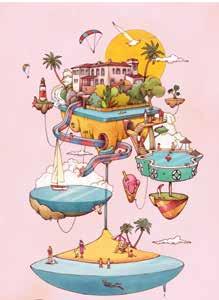
¿Cuánto sabes de Paradores? Paradores, how much do you know?
FOTOGR A FÍ A Archivo Paradores
Editorial MIC
PUBLICIDAD
Editorial MIC 902 271 902 987 27 27 27
Madrid: Jesús Pérez
Barcelona: Belén Matè Àngel Ferrándiz
León: Esther García · Benita Espadas
Valladolid: Virginia de la Bastida
Valencia: Esther G. Pablo
PRO D UCC IÓNEDI TOR IA L
Editorial MIC
Tel. 902 271 902 • Fax: 902 371 902
E-mail: mic@editorialmic.com www.editorialmic.com
D. L.: LE-1041-2013
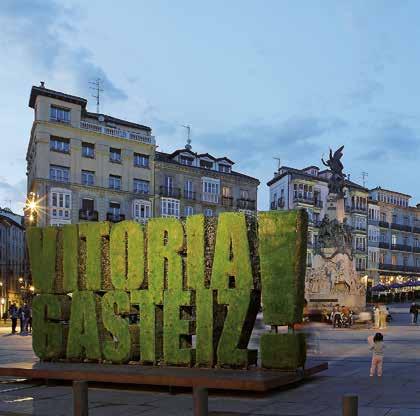
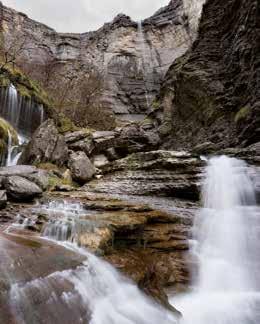
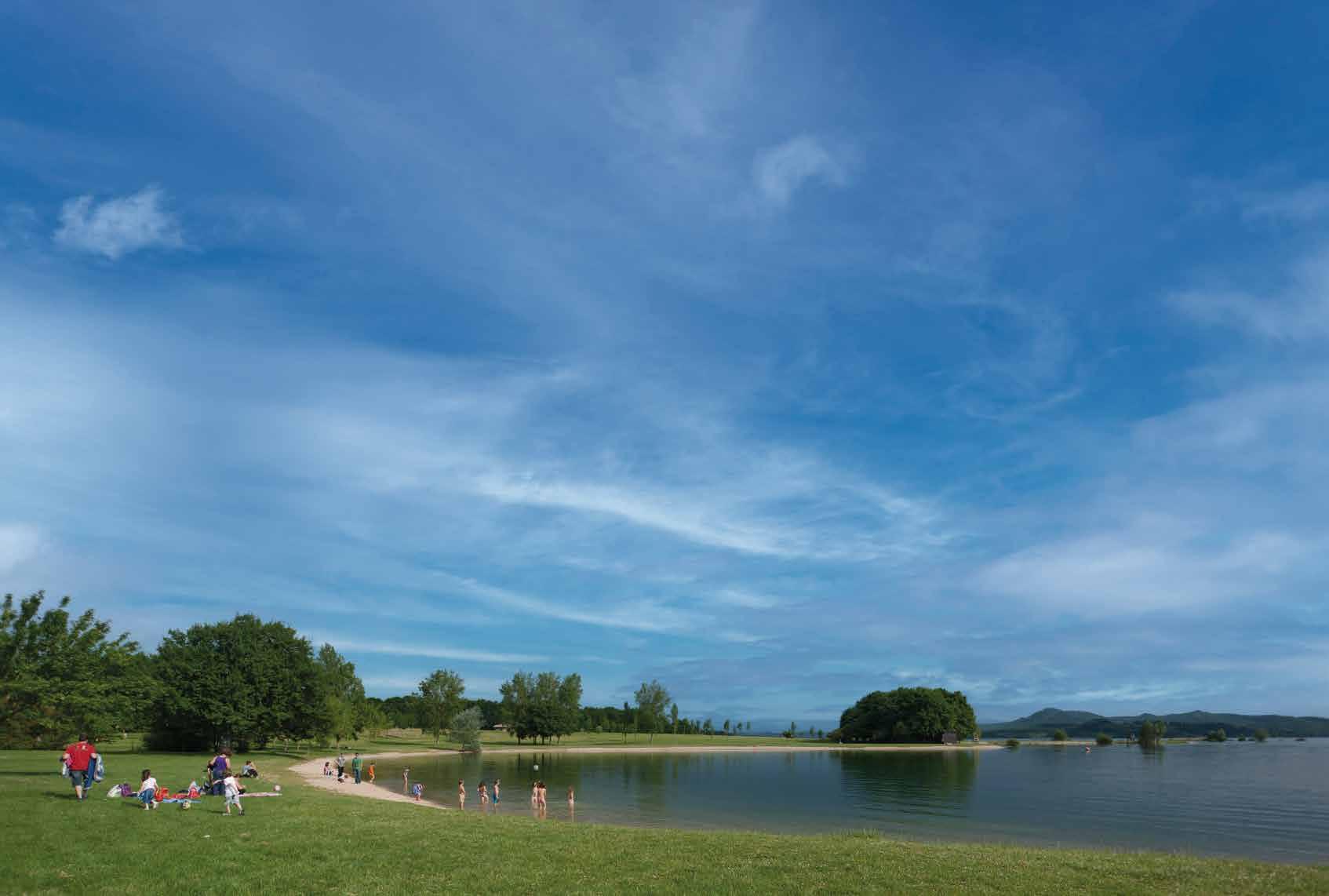

NATURALEZA, PATRIMONIO ÚNICO, GASTRONOMÍA, EL MEJOR VINO Y EXPERIENCIAS INOLVIDABLES TE ESPERAN
1. Vitoria-Gasteiz. Tres propuestas para conocer la esencia de la ciudad: conocer el origen de la ciudad en la original visita guiada a la Catedral de Santa María; rutas temáticas por la Almendra Medieval basada en leyendas o el bestseller ‘El silencio de la ciudad blanca’, y paseo por el Anillo Verde para avistar aves y ciervos entre humedales. Todo ello de la mano de guías locales.
. Acercarse a conocer el salto del Nervión, el salto de agua más alto de España con más de 200 metros de caída al vacío, y visitar el original Taller Museo Santxotena en Artziniega. ¿Te apetece conocer la obra de este discípulo de Jorge de Oteiza de la mano del propio autor? Una experiencia única y diferente. Otros imprescindibles: empaparse de cultura popular en el Museo Etnográfico de Artziniega, acercarse a la historia en el Conjunto Monumental de Quejana y degustar el txakoli de la comarca.
3. Llanada. Dos pequeños pueblos de la comarca, Alaitza y Gazeo, esconden otras tantas iglesias cuyo interior está decorado con pinturas medievales cuyo origen y objeto son todo un misterio. Una amena visita guiada permite conocer los secretos de ambos templos. Dos ideas más para completar el plan: aprender cómo se elabora el queso Idiazábal en las queserías de la zona y visitar la villa medieval de Salvatierra.
4. Montaña. Álava es naturaleza y te proponemos dos planes para adentrarte en su naturaleza e historia: Mina Lucía, una de las pocas minas de asfalto natural abierta al público, y la vía verde del ferrocarril Vasco-Navarro (centro de interpretación en la villa medieval de Antoñana).
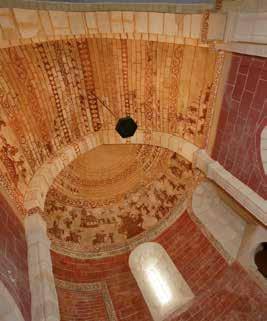
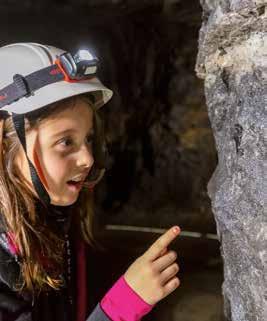
5. Añana. Recorrer, conocer y saborear el Valle Salado de Añana, salinas milenarias que configuran uno de los conjuntos arquitectónicos, paisajísticos, arqueológicos, geológicos e históricos más singulares del mundo.
La Torre de los Varona y la Ruta del Agua (Berganzo) para los amantes del senderismo también encajan en el plan a la perfección.
6. Rioja Alavesa. Sumérgete en la cultura del vino en las bodegas y viñedos de Rioja Alavesa. Una visita guiada para conocer la arquitectura del vino, con las obras de arquitectos como Frank Ghery o Santiago Calatrava; disfrutar de un almuerzo entre viñedos; y asistir a una cata maridada son sólo algunas opciones.


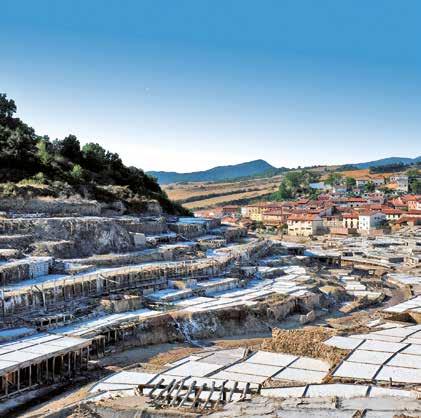
7. Gorbeialdea. ¡Aquí sí hay playa! Álava cuenta con varias playas de interior reconocidas con bandera azul por la UE por la limpieza de sus aguas y la calidad de sus servicios. Como la playa de Landa… Aquí puedes tomar el sol, disfrutar de un baño refrescante, practicar deportes acuáticos o, simplemente, relajarte.
Quienes buscan retos no pueden dejar de subir el monte Gorbea, cumbre emblemática de Álava, y disfrutar de inigualables vistas.
*Ayala, Llanada Alavesa, Montaña Alavesa, Añana, Gorbeialdea y Rioja Alavesa son comarcas de la provincia de Álava.
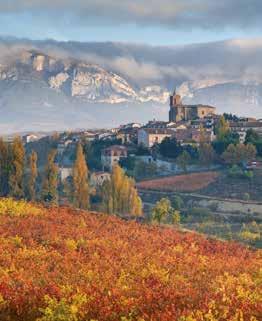
Todos estos planes y mucho más en www.alavaturismo.eus

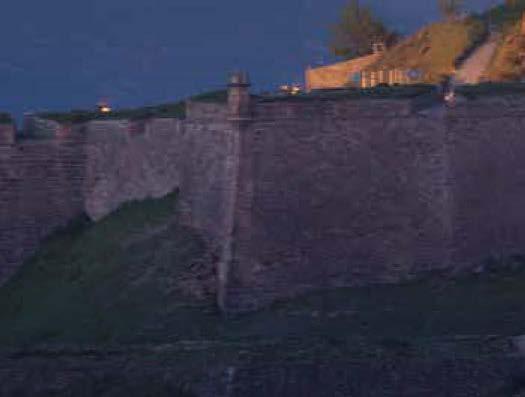
Cardona no es solo una postal medieval: es un viaje en el tiempo. Entre muros de piedra y panorámicas que quitan el aliento, el recién renovado Parador constituye uno de los destinos patrimoniales más singulares de España.
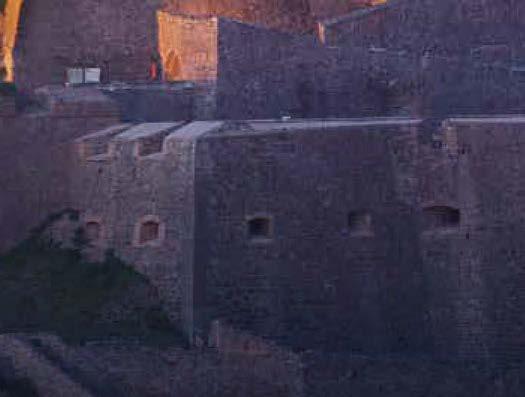


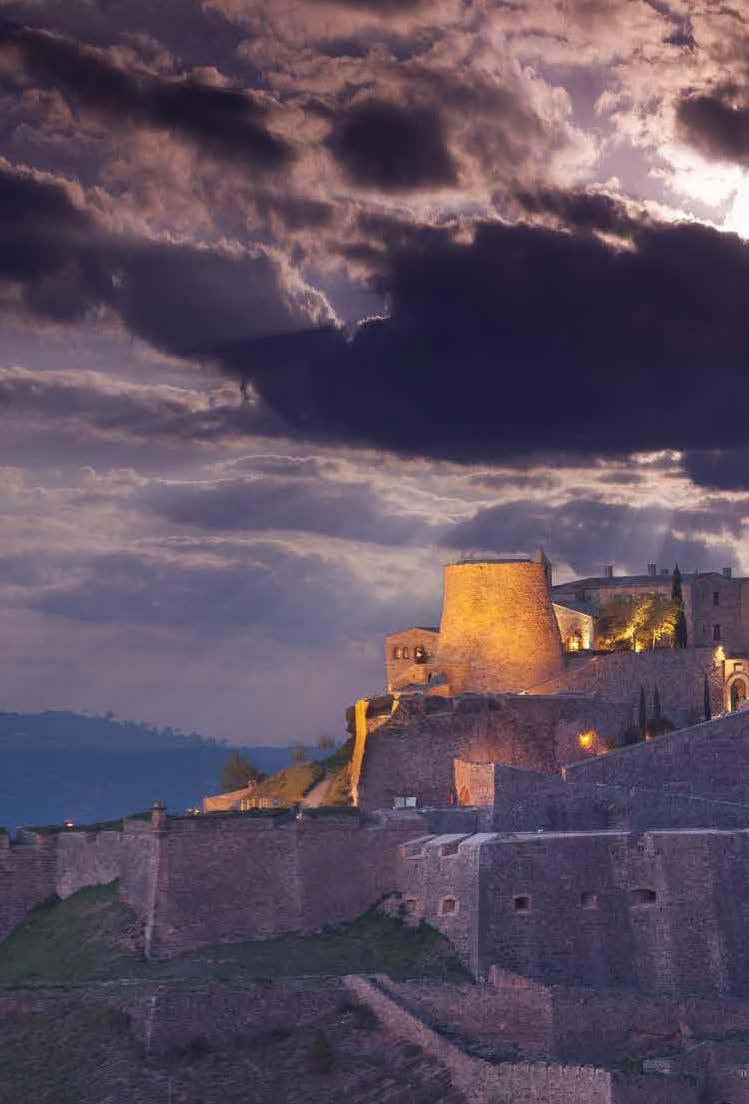
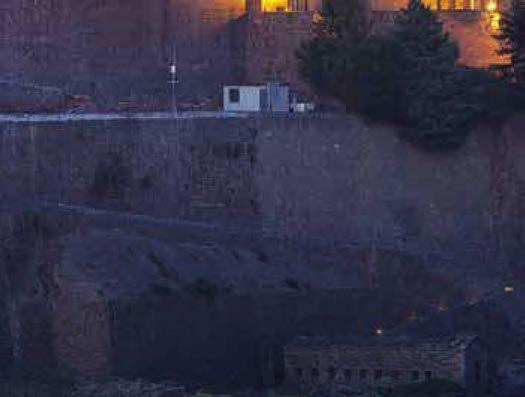
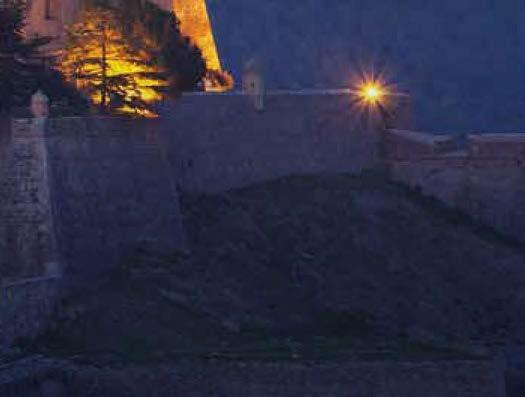
Cardona is not just a medieval postcard: it’s a journey through time. Amidst stone walls and breathtaking panoramic views, the newly renovated Parador stands as one of Spain’s most unique heritage destinations.


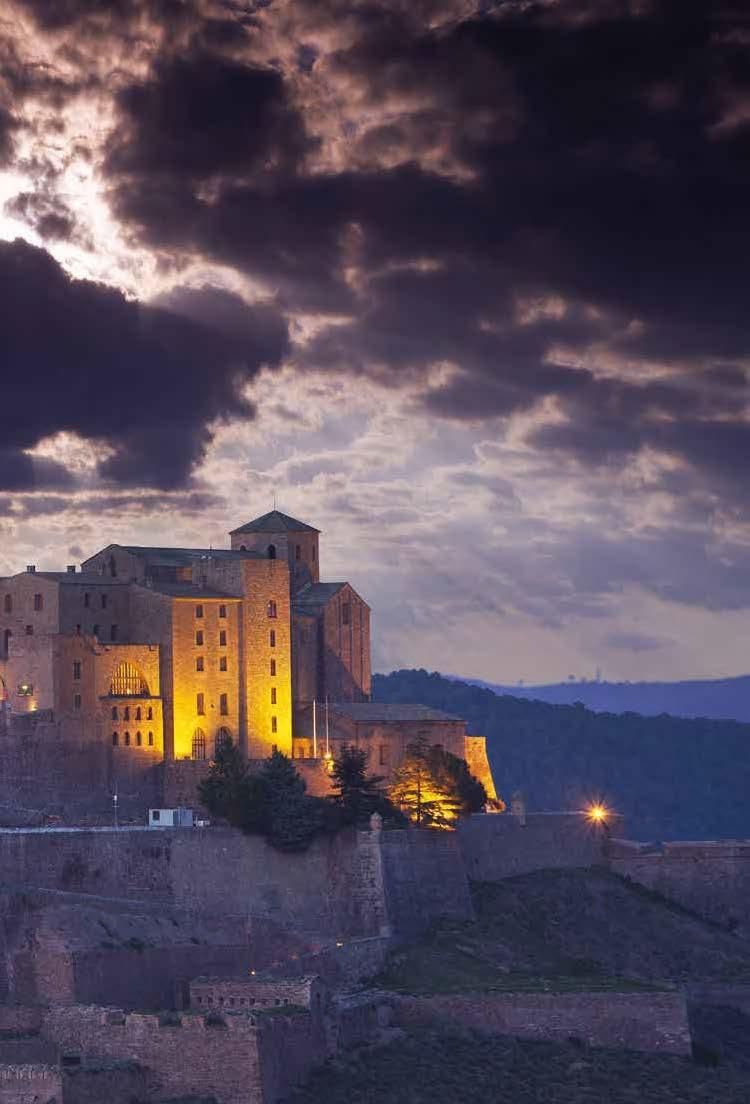
Atravesar el portal del Graells es internarse en un laberinto de calles con gusto medieval que ascienden con pausa hasta el emblema de la localidad: el castillo de Cardona, uno de los Paradores más impresionantes. Recién abierto tras una inversión de casi tres millones de euros, el Parador de Cardona conserva la esencia románica de la que fue residencia de una de las familias más poderosas de la Corona de Aragón. Recorrer sus estancias, deambular por los pasillos o disfrutar de las vistas que ofrecen sus habitaciones son experiencias inolvidables, más recomendables, si cabe, tras un proyecto de renovación que afecta a la decoración, las cubiertas y la carpintería exterior, y mejora la conservación del edificio, el aislamiento térmico y la reducción del gasto de energía.
Las actuaciones se suman a las llevadas a cabo por Turespaña con fondos europeos, centradas en la restauración, limpieza y rehabilitación de diferentes elementos del castillo, así como en la iluminación monumental de esta joya defensiva catalana.
El Parador de Cardona conserva la esencia románica de la que fue residencia de una de las familias más poderosas de la Corona de Aragón
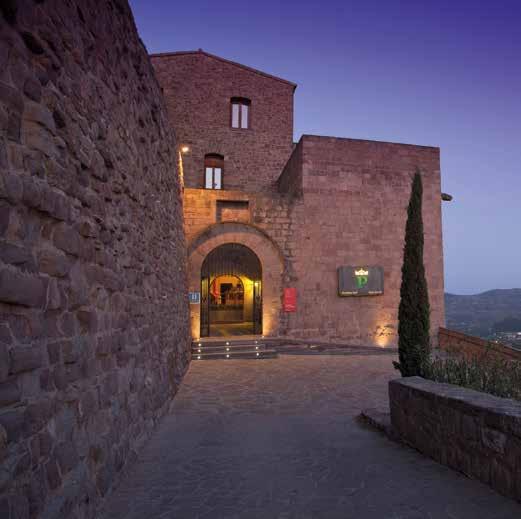
A su lado, la Colegiata de San Vicente, precedida por un atrio porticado que conserva pinturas murales de hace mil años es una de las obras maestras del primer románico catalán. Defendida por los baluartes de Sant Pere y Sant Nicolau, domina el paisaje y su cimborrio compite en altura con la Torre Minyona, a pesar de que esta fue desmochada en 1812, en plena guerra de la Independencia, cuando Cataluña era, de facto, parte del imperio francés. Atalaya privilegiada, desde allí se divisa otro de los puntos más destacados de la localidad, la montaña de sal, un depósito salino explotado desde el Neolítico y motor económico de la localidad a lo largo de la historia. Galerías a más de ochenta metros de profundidad, estalactitas que parecen carámbanos y herramientas cubiertas de sal de cuando la mina estaba activa fascinan a cuantos curiosos se atrevan a adentrarse en sus entrañas. Para completar la visita, a los pies del castillo se encuentra el Museo de la Sal, imprescindible para comprender la importancia que el mineral ha tenido en Cardona a lo largo del tiempo.

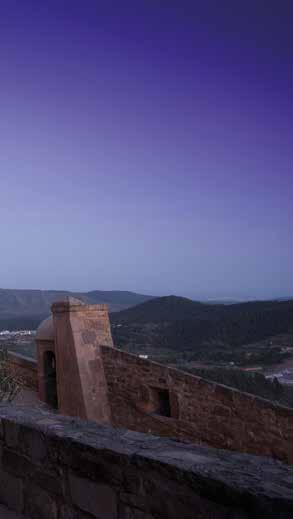
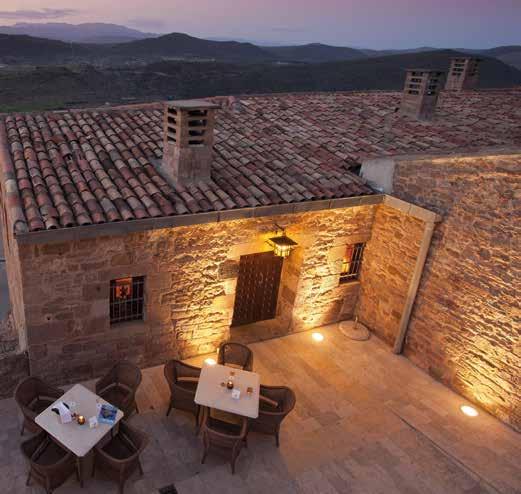
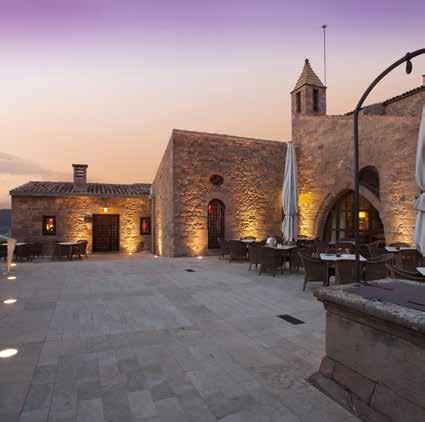
Crossing the Graells gate is stepping into a labyrinth of medieval streets that rise slowly towards the town’s emblem: Cardona Castle, one of the most impressive Paradores.
Recently reopened after an investment of nearly three million euros, the Parador of Cardona retains the Romanesque essence of what was once the residence of one of the most powerful families in the Crown of Aragon. Exploring its spaces, wandering through its corridors, or enjoying the views from its rooms are unforgettable experiences, even more so after a renovation project that has enhanced the decoration, roofing, and exterior woodwork, while improving the building’s preservation, thermal insulation, and energy efficiency.
These works add to those carried out by Turespaña with European funding, focused on the restoration, cleaning, and rehabilitation of various elements of the castle, as well as the monumental lighting of this Catalan defensive jewel.
Next to it stands the Collegiate Church of San Vicente. Preceded by a porticoed atrium that still preserves mural paintings a thousand years old, it is one of the masterpieces of early Catalan Romanesque architecture. Defended by the bastions of Sant Pere and Sant Nicolau, it dominates the landscape. Its lantern tower competes in height with the Minyona Tower, despite the fact that the latter was reduced in height in 1812, during the Peninsular War, when Catalonia was, de facto, part of the French Empire.
A privileged watchtower, from here one can view another of the town’s most significant landmarks: the salt mountain, a saline deposit that has
En 1965, la quietud serena de la Colegiata de San Vicente se vio interrumpida por la llegada de uno de los grandes cineastas estadounidenses: Orson Welles. Como un tornado, el prolífico director revolucionó la vida de una localidad donde no había whiskey hasta su llegada y la convirtió en el escenario de Campanadas a medianoche. Estrenada en el festival de Cannes, se alzó con el premio técnico. La historia transcurre entre los arcos del claustro gótico, el castillo y las naves románicas de la colegiata, lo que propició que esta última, en 2016, fuera reconocida como Tesoro de la Cultura Cinematográfica Europea por la Academia de Cine Europeo.
/
In 1965, the serene stillness of the Collegiate Church of San Vicente was interrupted by the arrival of one of the greatest American filmmakers: Orson Welles. Like a hurricane, the prolific director revolutionised the life of a town where there had been no whiskey until his arrival, turning it into the setting for Chimes at Midnight. Premiered at the Cannes Film Festival, the film won the technical prize. The story unfolds between the arches of the Gothic cloister, the castle, and the Romanesque aisles of the collegiate church, which led to it being recognised in 2016 as a Treasures of European Film Culture by the European Film Academy.
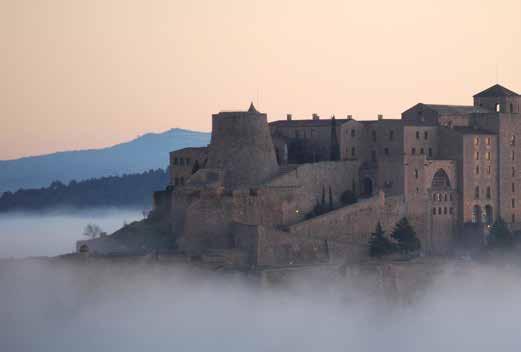
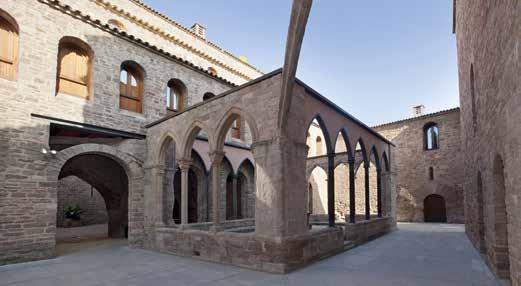
La cocina tradicional catalana, en especial la gastronomía de la comarca barcelonesa del Bagés, es la base de la oferta de restauración del Parador de Cardona. Una cocina elaborada con productos de temporada y de proximidad como setas, embutidos, tomate, berenjena, bacalao, caracoles, carne de cordero y de cerdo o el pato y sus derivados. En su impresionante comedor medieval se pueden degustar texturas variadas de bacalao con brandada, escudella, surtidos de embutidos típicos catalanes con pan de coca de vidre y tomate de «penjar», verduras escalivadas, suquet de mariscos con bogavante, merluza, rape, langostinos y almejas.
The Parador of Cardona retains the Romanesque essence of what was once the residence of one of the most powerful families in the Crown of Aragon
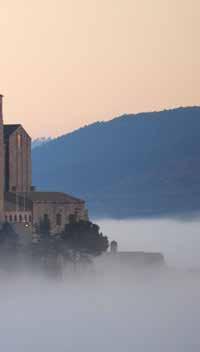
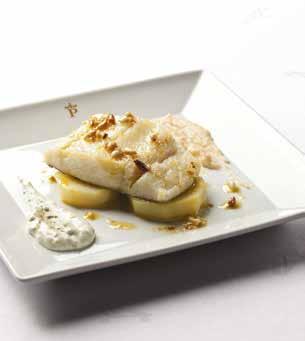
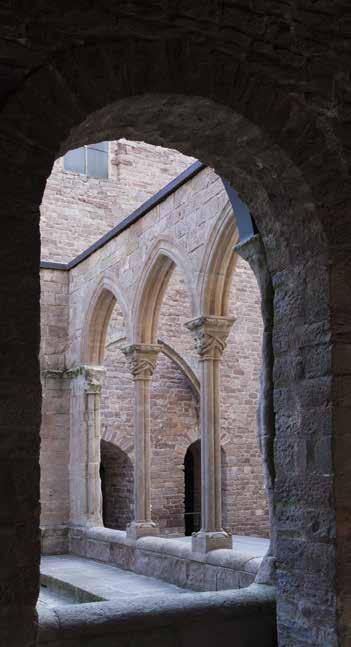
Cuenta la leyenda que en el castillo de Cardona vivía el duque de la localidad con su hija Adalés. Cansado de guerras y al encuentro de una alianza segura, invitó a la fortaleza al príncipe musulmán Abdalá que, paseando por los jardines, se encontró con Adalés. A aquel primer encuentro siguieron otros. Convertidos ya en amantes, se juraron amor eterno. Cuando el duque se enteró, declaró la guerra a los musulmanes y encerró a Adalés en lo alto de la torre. Abdalá intentó liberarla, pero solo encontró la muerte a manos de los soldados del duque. Ella, rota de pena, acabó muriendo en la torre, conocida desde entonces como de la «minyona» o doncella en catalán.
been exploited since the Neolithic and has served as the economic engine of the town throughout history. Gallery tunnels over eighty metres deep, stalactites resembling icicles, and tools encrusted with salt from when the mine was operational, captivate any visitor who dares to venture into its depths. To complete the visit, at the foot of the castle stands the Salt Museum, essential for understanding this mineral’s importance in Cardona over time.
Traditional Catalan cuisine, particularly the gastronomy of the Bagés region in Barcelona, forms the foundation of the Parador of Cardona’s offering. A cuisine prepared with seasonal and locally sourced products such as mushrooms, cold meats, tomatoes, aubergines, cod, snails, lamb and pork, or duck and its derivatives. In its impressive medieval dining room, guests can enjoy various textures of cod with brandade, escudella, typical Catalan cold meats with coca de vidre bread and “penjar” tomatoes, grilled vegetables, seafood stew with lobster, hake, monkfish, prawns, and clams.
Legend has it that the duke of Cardona lived in the castle with his daughter, Adalés. Tired of war and seeking a secure alliance, he invited the Muslim prince Abdalá to the fortress. While strolling through the gardens, Abdalá met Adalés. That first meeting was followed by many more. They became lovers and swore eternal love to each other. When the duke discovered their relationship, he declared war on the Muslims and imprisoned Adalés at the top of the tower. Abdalá tried to free her but only found death at the hands of the duke’s soldiers. Heartbroken, she died in the tower, which has been known ever since as the “Minyona”, or “maiden” in Catalan.
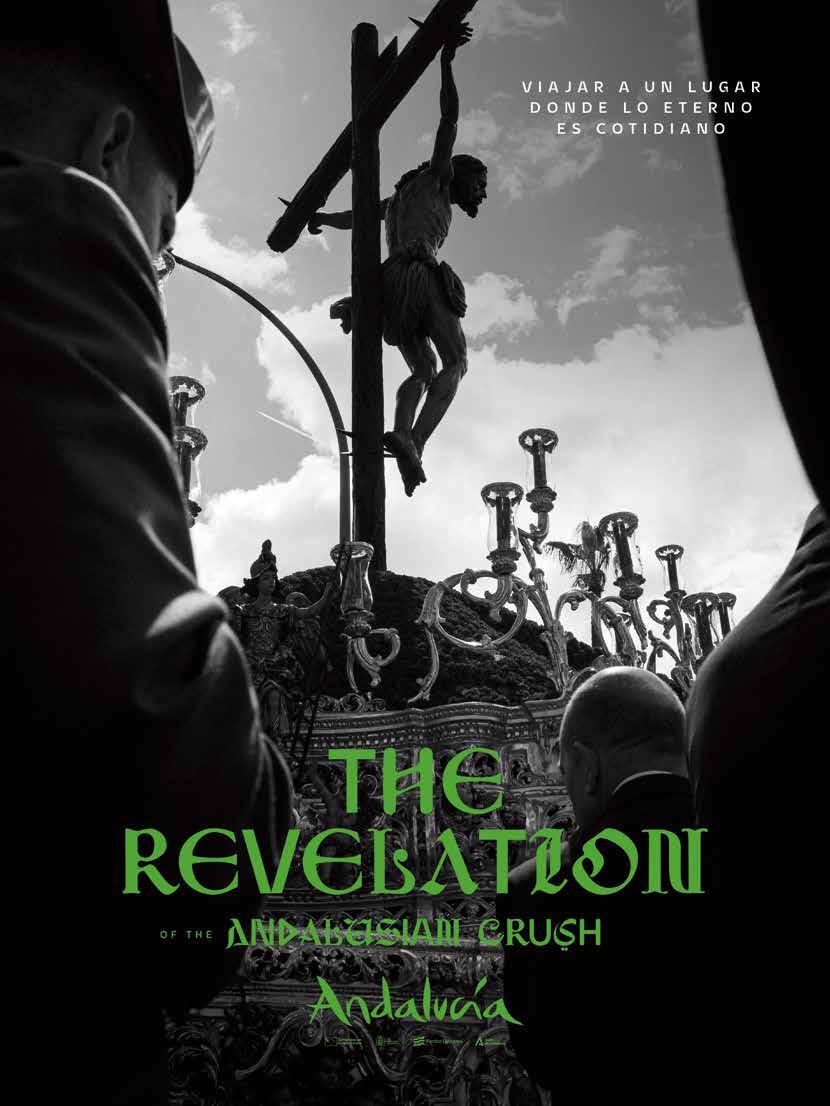
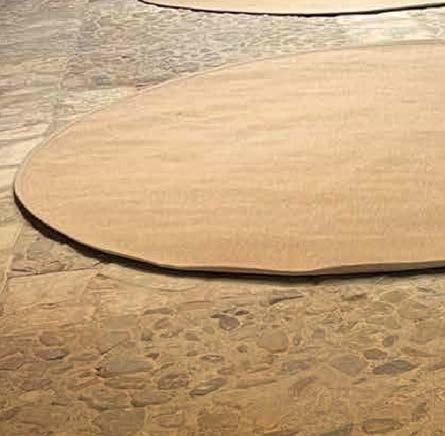
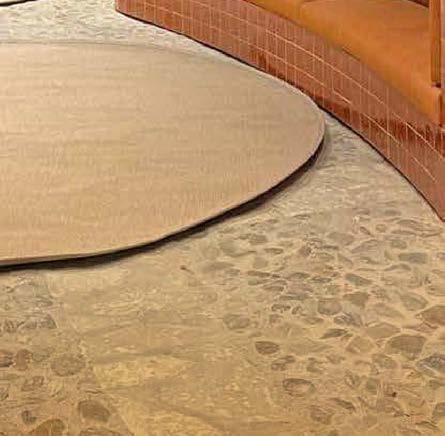

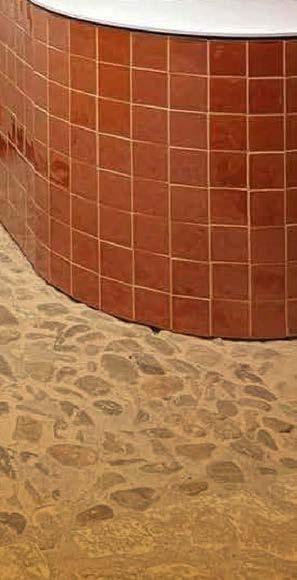
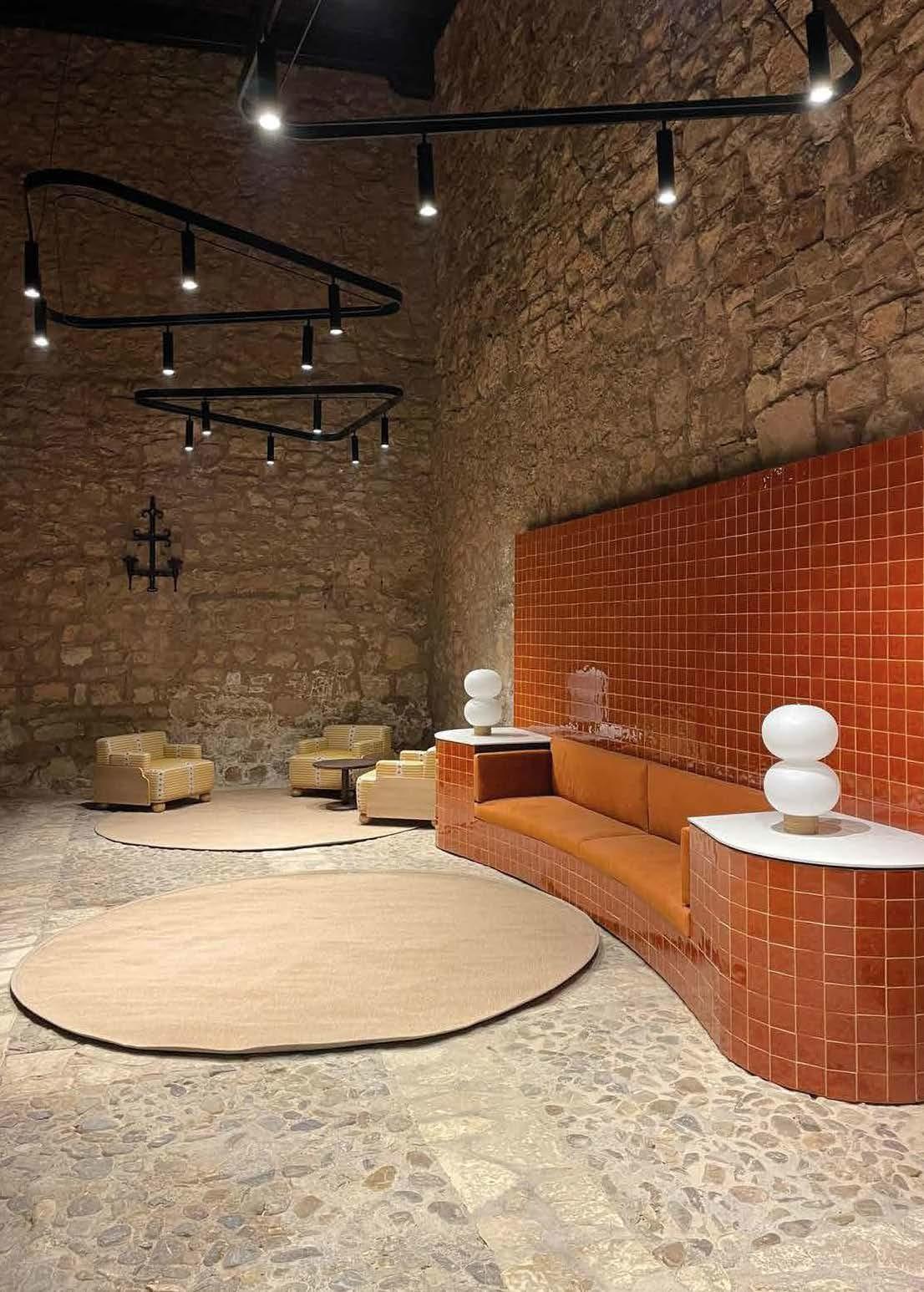
Recorrer Sigüenza es sumergirse en los siglos de historia que engalanan sus calles bajo la mirada de uno de los símbolos de la localidad: su castillo. Tras una cuidada transformación, el Parador vuelve a mirar al futuro sin renunciar a su leyenda.
Año 1355. Blanca de Castilla, esposa de Pedro I –llamado el Cruel–, es encerrada en el castillo de Sigüenza en mitad de la guerra que enfrenta al monarca con su hermanastro, futuro rey Enrique II de Trastámara. Durante cuatro largos años, la fortaleza se convertirá en su prisión y será testigo de uno de los periodos más convulsos de la Edad Media peninsular.
Sin embargo, no fue ella el único huésped célebre que cobijaron sus muros. Castillo episcopal desde que Bernardo de Agén reconquistara la localidad y se convirtiera en su primer obispo, por sus estancias han pasado personajes tan destacados como el cardenal Mendoza, que dio a la fortaleza las dependencias palaciegas donde hoy se asienta el Parador, o Fernando VII, que lo visitó en 1827.
Inaugurado en 1976, ha sido sometido a una profunda remodelación para celebrar sus cincuenta años en la Red. Gracias a una inversión de más de diez millones de euros, se han reformado los baños de acceso público y los baños de varias habitaciones para mejorar su accesibilidad, cambiando bañeras por platos de ducha. En cumplimiento de los objetivos de sostenibilidad y eficiencia energética se han cambiado las calderas de gasóleo para su transformación a gas natural, lo que reducirá en más de un 25 % el
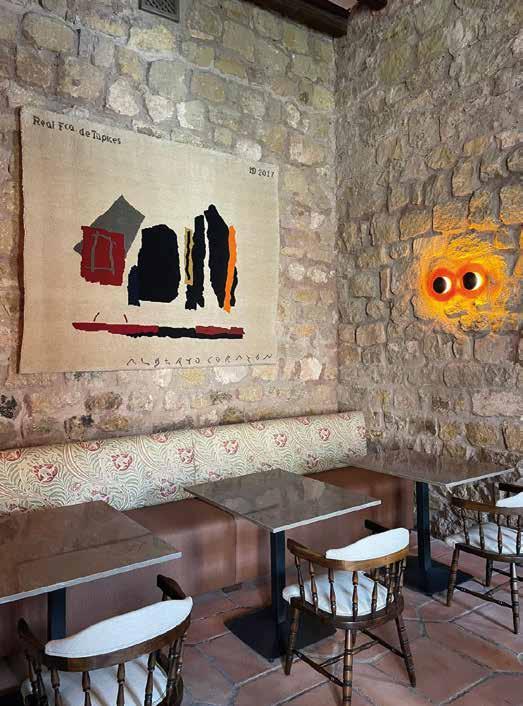
consumo energético de calefacción del Parador, recortará más de un 60 % la factura por este concepto y rebajará un 52 % las emisiones de CO2, lo que supone 200 toneladas menos de dióxido de carbono, el equivalente a plantar unos 350 árboles.
Estas obras también permiten la mejora de la climatización del imponente inmueble gracias a la automatización y el aislamiento para mayor comodidad de los huéspedes.
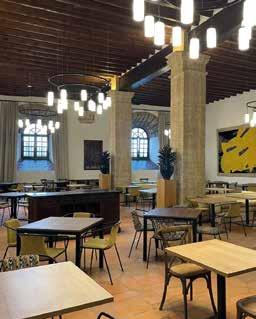
La intervención ha incluido también obras de remodelación en la zona del aljibe y en las instalaciones existentes, así como la adecuación de los sistemas contra incendios. Además, se ha lleva do a cabo un proyecto integral de redecoración que ha actualizado la imagen del hotel gracias a la mejora de la iluminación en las zonas comunes, pasillos y habitaciones, la optimización de la distribución de salones y restaurante y la sustitución de textiles y muebles obsoletos y deteriorados por el uso y el paso del tiempo.

To walk through Sigüenza is to immerse oneself in the centuries of history that adorn its streets under the watchful gaze of one of the town’s symbols: its castle. After a careful transformation, the Parador now looks to the future without renouncing its legend.
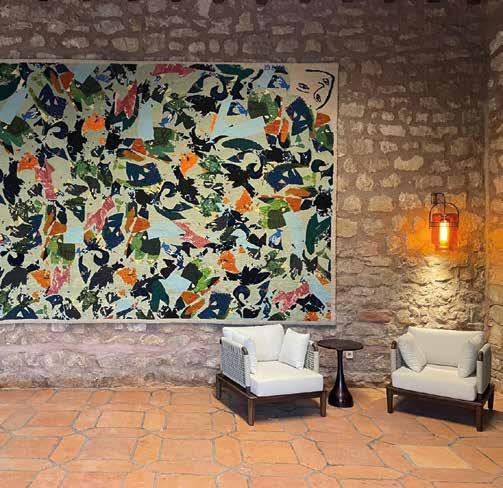
Year 1355. Blanca of Castile, wife of Peter I –known as the Cruel– is locked in the castle of Sigüenza amid the war between the king and his half-brother, the future King Henry II of Trastámara. For four long years, the fortress will become her prison and witness one of the most turbulent periods of the Iberian Middle Ages.
However, she was not the only famous guest sheltered within its walls. A bishop’s castle since Bernardo of Agén reconquered the town and became its first bishop, the fortress has hosted notable figures such as Cardinal Mendoza, who gave the castle its palatial rooms where the Parador now stands, or Ferdinand VII, who visited it in 1827.
Inaugurated in 1976, it has undergone a thorough renovation to celebrate its fifty years in the network. Thanks to an investment of over ten million euros, the rooms’ bathrooms have been remodelled to improve accessibility, replacing bathtubs with shower trays and renovating the public-access bathrooms. In line with sustainability and energy efficiency goals, the oil boilers have been replaced with natural gas systems, which will reduce the Parador’s heating energy consumption by over 25%. It will also cut associated costs by more than 60%, and reduce CO2 emissions by 52%, equivalent to 200 tonnes of carbon dioxide, which is roughly the same as planting 350 trees.
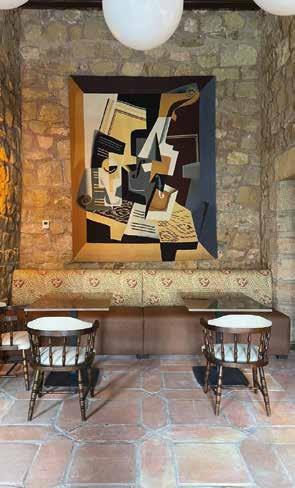
These works also enable improvements to the air conditioning of the imposing building thanks to automation and insulation, ensuring greater comfort for the guests.
The intervention has also included renovations in the cistern area and in the existing facilities, as well as adjustments to the fire safety systems. Additionally, an integral redecorating project has been carried out, updating the hotel’s image through improved lighting in common areas, corridors, and rooms, optimizing the layout of the lounges and restaurant, and replacing obsolete and worn textiles and furniture due to use and time.
Dada la condición de Bien de Interés Cultural del inmueble, con categoría de monumento, Turespaña ha restaurado la barbacana –cuyo adarve se puede recorrer– y, entre otras actuaciones, ha habilitado la azotea de la torre noroeste como un nuevo punto Startligh t para observación astronómica. Todo ello con fondos del Plan de Recuperación, Transformación y Resiliencia.
Las obras de Sigüenza se enmarcan en el ambicioso plan de transformación que está desarrollando Paradores con vistas a su centenario en 2028, un plan que va a suponer la reforma de más de la mitad de sus edificios y una inversión superior a 250 millones de euros para mejorar la experiencia de los clientes desde todos los puntos de vista: accesibilidad, sostenibilidad, interiorismo y conservación de los edificios más emblemáticos, impulsando un modelo de turismo que protege y enriquece el entorno.
El recuerdo de Blanca de Castilla y su época sigue vivo en el Parador, como lo demuestra la estructura Ciris, del artista catalán Gerard Mas. Catorce bustos de cera, hierro y luz recuerdan a las mujeres que, como Blanca, fueron cautivas en torres y castillos. A modo de cirios encendidos, en estas figuras la memoria histórica se entrelaza con el arte contemporáneo.
No es la única propuesta que conecta el pasado desde el presente. Encargados a la Real Fábrica de Tapices, una selección de textiles adorna los vetustos muros del Parador. Siguiendo modelos originales de artistas como Guillermo Pérez Villalta, Keiko Mataki, Manolo Valdés o Alberto Corazón, los tapices aportan color a un edificio que, ya de por sí, es una obra de arte.
El guiño a la naturaleza lo aporta José Quintanilla con El Espejo de Claude, obra que evoca la salida del sol en las mañanas de verano y envuelve a los que la contemplan en un horizonte de árboles y ramas, de naturaleza cotidiana que guarda la capacidad de sorprender de aquello que se ve por primera vez.
La muestra artística del Parador se completa con piezas conectadas a la tierra donde se alza, nacidas del barro que revientan la alfarería tradicional, como las de la seguntina Aniana Heras, que fusionan pasado y futuro en un despliegue de geometría y creatividad.
El Parador ha sido sometido a una profunda remodelación para celebrar sus cincuenta años en la Red
Visitar la catedral de Sigüenza es sumergirse en la historia de su tumba más célebre, la del doncel. Martín Vázquez de Arce, conocido como el doncel de Sigüenza, falleció joven, aunque no tanto como para ser todavía «doncel», y ocupa un puesto de honor entre los enterrados en la catedral, a pesar de que murió en combate en Granada, en 1486. No fueron sus hazañas militares las que le granjearon fama, sino el magnífico sepulcro encargado por su hermano, una de las mejores obras escultóricas del gótico español, en el que el difunto parece leer, recostado, el libro que sujeta entre las manos.

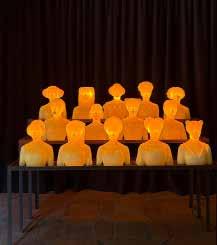
A medio camino entre la catedral y el castillo, tras dejar atrás la iglesia de Santiago y el Centro de Interpretación del Románico que alberga para internarse en las callejuelas del centro histórico, se alza la casa del doncel, un laberinto de estancias con decoraciones mudéjares perteneciente a la Universidad de Alcalá que funciona, entre otras cosas, como museo.
Junto al gótico que sorprende deambulando entre murallas medievales e iglesias centenarias, se abren paso fachadas barrocas, como la del Monasterio de las Ursulinas, o añadidos renacentistas, como la sacristía de las cabezas, con más de trescientos bustos tallados en la bóveda que la cubre.
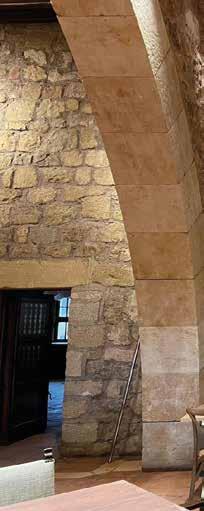
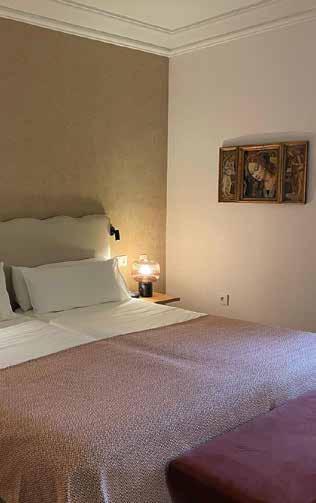

Given the building’s status as a Site of Cultural Interest, with monument status, Turespaña has restored the barbican –whose walkway is now open to the public– and, among other works, has turned the northwest tower rooftop into a new Startlight point for astronomical observation. All of this is funded by the Recovery, Transformation, and Resilience Plan.
The works in Sigüenza are part of the ambitious transformation plan that Paradores is developing in anticipation of its centenary in 2028, a plan that will involve the renovation of over half of its buildings and an investment of more than 250 million euros to enhance the guest experience from every angle: accessibility, sustainability, interior design, and the preservation of the most iconic buildings, promoting a tourism model that protects and enriches the environment.
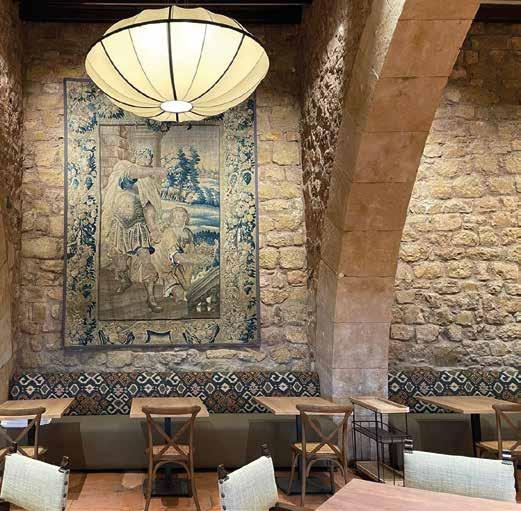
The memory of Blanca of Castile and her era is still alive in the Parador, as demonstrated by the Ciris structure by Catalan artist Gerard Mas. Fourteen busts made of wax, iron, and light commemorate the women who, like Blanca, were captives in towers and castles. Like lit candles, these figures intertwine historical memory with contemporary art.
It is not the only proposal that connects the past with the present. Commissioned by the Royal Tapestry Factory, a selection of textiles adorns the ancient walls of the Parador. Following original designs by artists such as Guillermo Pérez Villalta, Keiko Mataki, Manolo Valdés, and Alberto Corazón, the tapestries add colour to a building that is, in itself, a work of art.
The Parador has undergone a thorough renovation to celebrate its fifty years in the network
The touch of nature is provided by José Quintanilla with Claude’s Mirror, a piece that evokes the sunrise on summer mornings and envelops those who gaze upon it in a horizon of trees and branches, the everyday nature that still holds the ability to surprise in what is seen for the first time.
The Parador’s artistic exhibition is completed with pieces connected to the land where it stands, born from clay that breaks traditional pottery, such as those by Sigüenza artist Aniana Heras, which merge the past and the future in a display of geometry and creativity.
Visiting the Sigüenza Cathedral is to immerse oneself in the history of its most famous tomb, that of the doncel Martín Vázquez de Arce, known as the “doncel de Sigüenza”, died young, though not so young as to still be considered a “squire,” and occupies an honoured place among those buried in the cathedral, despite dying in battle in Granada in 1486. It was not his military feats that earned him fame, but the magnificent tomb commissioned by his brother, one of the finest sculptural works of Spanish Gothic, in which the
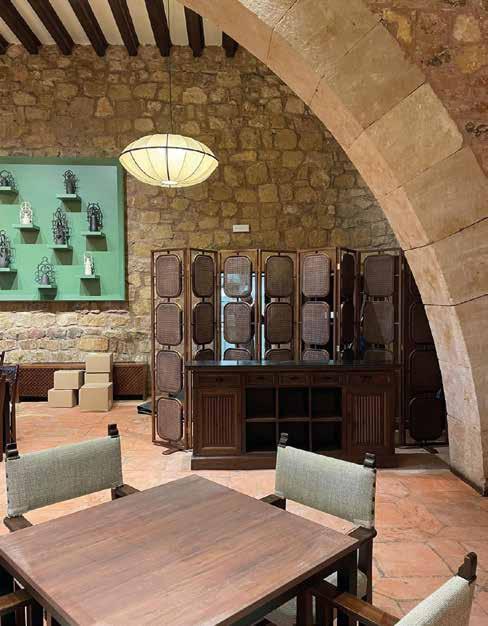
Dos son los ríos que entornan las tierras de Sigüenza: el Dulce, al mediodía, y el Salado, en el septentrión. Ambos crean contrastes naturales perfectos para dejarse llevar por el sonido del agua y olvidar la rutina.
El río Dulce, célebre por los documentales de Félix Rodríguez de la Fuente –al que se recuerda con un monumento en un mirador sobre la hoz–, serpentea por un cañón de paredes verticales donde anidan buitres leonados y el aire huele a tomillo y espliego. El Barranco del Río Dulce, hoy parque natural, es un regalo para senderistas y fotógrafos: entre álamos, arces y encinas, el camino se abre paso bordeando cortados, cascadas y antiguos
deceased appears to be reading, reclining, the book he holds in his hands.
Halfway between the cathedral and the castle, after passing the Church of Santiago and the Romanesque Interpretation Centre it houses, and venturing into the alleys of the historic centre, stands the Casa del Doncel, a labyrinth of rooms with Mudejar decorations belonging to the University of Alcalá, which functions, among other things, as a museum.
Alongside the Gothic architecture that surprises while wandering through medieval walls and centuries-old churches, Baroque facades, such as that of the Ursuline Monastery, or Renaissance additions, like the sacristy of heads, with more than three hundred busts carved into the vault above, appear.
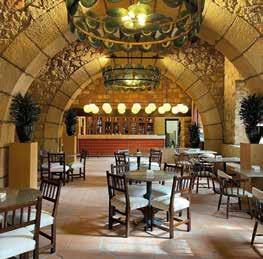
molinos de agua en las inmediaciones de Pelegrina. Si la suerte sonríe, entre las matas de vegetación que bordean el río se pueden avistar corzos, águilas levantando el vuelo o nutrias chapoteando en busca de las truchas que pueblan el río.
Al norte, el Salado siembra de antiguas salinas el paisaje. Lo que un día constituyó una fuente de riqueza para los pueblos que dormían en su ribera, hoy permanece casi olvidado a lo largo de su cauce. Entre salicornias, las antiguas explotaciones de sal salpican el paisaje, como las de Imón, construidas en el siglo X y una de las salinas más importantes de España hasta 1996, cuando cesó su producción, aunque la sal aún se forma en las eras en las cálidas tardes de verano.
There are two rivers that shape the lands of Sigüenza: the Dulce (Sweet) River to the south, and the Salado (Salty) River to the north. Both create perfect natural contrasts, allowing one to be carried away by the sound of the water and forget the daily routine.
The Dulce River, famous for the documentaries of Félix Rodríguez de la Fuente –who is remembered with a monument in a viewpoint over the gorge– meanders through a canyon with vertical walls, where griffon vultures nest and the air smells of thyme and lavender. The Barranco del Río Dulce, now a natural park, is a gift for hikers and photographers: among poplars, maples, and holm oaks, the path winds along cliffs, waterfalls, and old watermills near Pelegrina. If luck smiles, one might spot roe deer, eagles taking flight, or otters splashing around in search of some of the trout that inhabit the river.
To the north, the Salado River is dotted with ancient salt pans. What once was a source of wealth for the towns that rested on its banks is now nearly forgotten along its course. Among the samphire, the old salt pans pepper the landscape, such as those in Imón, built in the 10th century and one of Spain’s most important saltworks until 1996, when production ceased, although salt still forms on the terraces during warm summer afternoons.
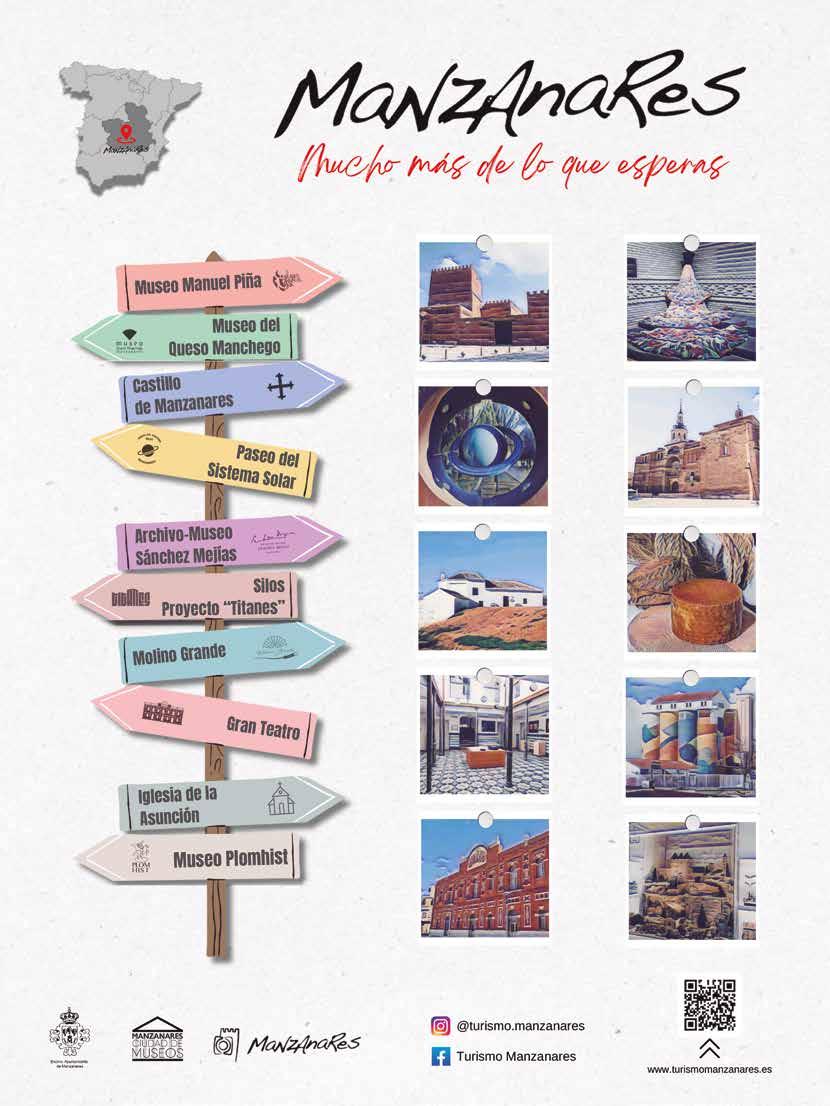
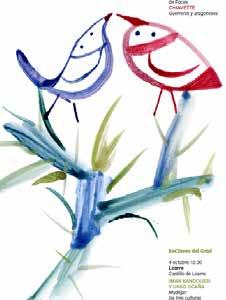
ENCLAVES
Fecha: del 4 al 26 de julio
Lugar: diversas localidades de la Hoya de Huesca

CELSIUS 232
Fecha: del 15 al 19 de julio
Lugar: centro histórico de Avilés, Asturias
Horarios y entradas: Entrada libre hasta completar aforo.
Información: celsius232.es
Horarios y entradas: hoyadehuesca.es
La edición 2025 ofrece doce conciertos en nueve localidades, fusionando música clásica, antigua y medieval en espacios patrimoniales como iglesias y monasterios. Destacan la integración del Festival AnAbArcA en Casbas de Huesca y la nueva sección «EnClaves del Grial», que llevará música medieval a Loarre, Bolea y Loreto en octubre. Participan artistas de renombre nacional e internacional, como Qvinta Essençia y Mefitis Quartet, con una significativa presencia de la voz como protagonista.
ENCLAVES
Date: From 4 to 26 July
Place: Various towns in the Hoya de Huesca
Opening hours and tickets: hoyadehuesca.es
The 2025 edition offers twelve concerts in nine towns, blending classical, ancient, and medieval music in heritage spaces such as churches and monasteries. Noteworthy are the integration of the AnAbArcA Festival in Casbas de Huesca and the new section “EnClaves del Grial,” which will bring medieval music to Loarre, Bolea, and Loreto in October. Renowned national and international artists participate, such as Qvinta Essençia and Mefitis Quartet, with a significant focus on vocal performances.
Se trata del principal festival dedicado a la fantasía, la ciencia ficción y el terror en España. Durante cinco días, Avilés se convierte en punto de encuentro para lectores, autores y creadores de todo el mundo. La edición de 2025 contará con la presencia de figuras como Brandon Sanderson, Lisa Tuttle, Joe Abercrombie y Adrian Tchaikovsky. La programación incluye presentaciones de libros, firmas, talleres, cine al aire libre, esgrima antigua y actividades infantiles. Además, se entregarán los premios Kelvin 505 y Lorna, que reconocen lo mejor de la literatura y el cómic de género.
Celsius 232
Date: From 15 to 19 July
Place: Historic centre of Avilés, Asturias
Opening hours and tickets: Free entry until capacity is reached.
Information: celsius232.es
This is the leading festival dedicated to fantasy, science fiction, and horror in Spain. For five days, Avilés becomes a meeting point for readers, authors, and creators from all over the world. The 2025 edition will feature figures such as Brandon Sanderson, Lisa Tuttle, Joe Abercrombie, and Adrian Tchaikovsky. The program includes book presentations, signings, workshops, outdoor cinema, historical fencing, and children’s activities. Additionally, the Kelvin 505 and Lorna awards will be presented, recognizing the best in genre literature and comics.
CHUNGO, LUIS ZAHERA
Fecha: del 12 al 14 de septiembre
Lugar: Capitol Gran Vía, Madrid
Horarios y entradas: taquilla.com
El actor Luis Zahera, conocido por dar vida a los personajes más duros, intensos y «chungos» del cine y la televisión española, se sube a las tablas con un giro inesperado. Chungo, su primer monólogo teatral, es un viaje hilarante y confesional por los entresijos de su vida y su carrera, donde el drama deja paso, finalmente, al humor. A lo largo del espectáculo, Zahera desgrana anécdotas personales y profesionales con su particular retranca gallega, desde una infancia entrañable hasta los castings más surrealistas de su trayectoria. Un desfile de historias e histerias, un cara a cara con ese tipo duro que siempre interpreta... y con el tipo real que hay detrás.
CHUNGO, LUIS
Date: From 12 to 14 September
Place: Capitol gran Vía, Madrid Opening hours and tickets: taquilla.com
Actor Luis Zahera, known for portraying the toughest, most intense, and “tough” characters in Spanish cinema and television, takes the stage with an unexpected twist. Chungo, his first theatrical monologue, is a hilarious and confessional journey through the ins and outs of his life and career, where drama finally gives way to humour. Throughout the performance, Zahera unfolds personal and professional anecdotes with his unique Galician humour, from a heartwarming childhood to the most surreal castings of his career. A parade of stories and hysterics, a face-to-face encounter with the tough guy he always plays... and with the real person behind the character.

Fecha: 18 al 21 de julio
Lugar: Cullera, Valencia
Horarios y entradas: zevrafestival.com
Zevra Festival se consolida como uno de los referentes de la música urbana en España. En su edición de 2025, el cartel incluye a Duki, The Tyets, Estopa, La Fúmiga, Dei V y Omar Montes, entre otros. El festival combina música, arte y experiencias inmersivas en un entorno costero único, atrayendo a miles de asistentes cada año.
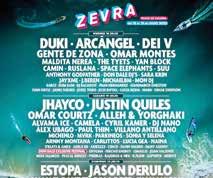
ZEVRA FESTIVAL
Date: From 18 to 21 July
Place: Cullera, Valencia
Opening hours and tickets: zevrafestival.com
Zevra Festival has become one of the leading urban music events in Spain. In its 2025 edition, the lineup includes Duki, The Tyets, Estopa, La Fúmiga, Dei V, and Omar Montes, among others. The festival combines music, art, and immersive experiences in a unique coastal setting, attracting thousands of people every year.
TRAIL 2 HEAVEN

Fecha: 12 y 13 de septiembre Lugar: Cortijo del Conde, Granada Horarios y entradas: granadasound.com
La 13ª edición de Granada Sound reúne a destacados artistas de la escena indie nacional e internacional. El cartel incluye a Mikel Izal, Zahara, XoelLópez, Miss Caffeina y Viva Suecia, entre otros. Una cita imprescindible para los amantes de la música independiente, con dos días de conciertos en un entorno emblemático.
Fecha: 19 y 20 de septiembre Lugar: Xardín do Pazo de Feiras e Congresos, Lugo Horarios y entradas: caudalfest.es
En su séptima edición concentra una destacada alineación de artistas como Melendi, Love of Lesbian, Dani Fernández y Carolina Durante. El festival se desarrolla en el entorno del río Miño, ofreciendo una experiencia única que combina música en vivo con la promoción de la cultura y tradiciones gallegas.
Fecha: 6 de septiembre Lugar: salida Los Llanos del Hospital y meta en la Villa de Benasque
Horarios y entradas: trail2heaven.com
Cada septiembre, Benasque acoge una de las pruebas de montaña más impresionantes del calendario nacional. Situado en pleno corazón del Pirineo aragonés, el recorrido atraviesa paisajes de una belleza sobrecogedora: valles glaciares, ríos de aguas cristalinas, bosques de altura y crestas que rozan el cielo. La carrera ofrece varias distancias adaptadas a distintos niveles, lo que permite que tanto corredores expertos como amantes del senderismo encuentren su propio desafío. Una experiencia única, donde se mezclan la pasión por el deporte y la conexión con el entorno.
Date: 12 and 13 September
Place: Cortijo del Conde, Granada
Opening hours and tickets: granadasound.com
The 13th edition of Granada Sound brings together prominent artists from the national and international indie scene. The lineup includes Mikel Izal, Zahara, Xoel López, Miss Caffeina, and Viva Suecia, among others. An unmissable event for independent music lovers, with two days of concerts in an iconic setting.

Date: 19 and 20 September
Place: Xardín do Pazo de Feiras e Congresos, Lugo
Opening hours and tickets: caudalfest.es
In its seventh edition, the festival features a standout lineup of artists such as Melendi, Love of Lesbian, Dani Fernández, and Carolina Durante. The festival takes place in the surroundings of the Miño River, offering a unique experience that combines live music with the promotion of Galician culture and traditions.
TRAIL 2 HEAVEN
Date: 6 September
Place: Start at Los Llanos del Hospital and finish in the town of Benasque
Opening hours and tickets: trail2heaven.com
Every September, Benasque hosts one of the most impressive mountain races on the national calendar. Located in the heart of the Aragonese Pyrenees, the route passes through breathtaking landscapes: glacier valleys, crystal-clear rivers, high-altitude forests, and ridges that touch the sky. The race offers various distances suited to different levels, allowing both expert runners and hiking enthusiasts to find their own challenge. A unique experience where passion for sport blends with a deep connection to the environment.
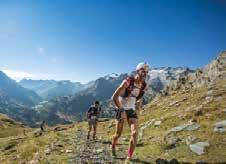
MARUJA MALLO: MÁSCARA Y COMPÁS
Fecha: hasta el 14 de septiembre
Lugar: Centro Botín, Santander
Horarios y entradas: centrobotin.org
Esta retrospectiva presenta alrededor de un centenar de pinturas y dibujos de Maruja Mallo, figura clave de la vanguardia española. La muestra recorre su trayectoria desde 1924 hasta 1982, incluyendo obras de su exilio en América y colaboraciones teatrales. La exposición destaca la evolución de su estilo, desde el realismo mágico hasta configuraciones geométricas y fantásticas, y su relevancia actual desde una visión renovada.
MARUJA MALLO:
MASK AND COMPASS
Date: Until 14 September
Place: Botín Centre, Santander
Opening hours and tickets: centrobotin.org
This retrospective presents around a hundred paintings and drawings by Maruja Mallo, a key figure of Spanish avant-garde art. The exhibition traces her career from 1924 to 1982, including works from her exile in the Americas and her theatrical collaborations. The exhibition highlights the evolution of her style, from magical realism to geometric and fantastical configurations, and its current relevance from a renewed perspective.

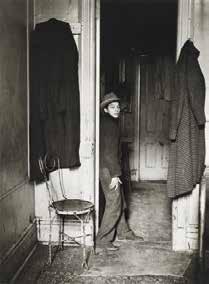

Fecha: hasta el 25 de agosto
Lugar: Museo Reina Sofía, Madrid
Horarios y entradas: museoreinasofia.es
Primera gran retrospectiva europea de Huguette Caland, artista libanesa cuya obra abarca décadas, continentes y medios, desafiando las convenciones estéticas y sociales de su tiempo. La exposición reúne aproximadamente 300 obras, incluyendo dibujos, pinturas, esculturas y trabajos en otros medios, ofreciendo un recorrido cronológico por su trayectoria artística.
HUGUETTE CALAND: A LIFE IN A FEW
Date: Until 25 August
Place: Museo Reina Sofía, Madrid
Opening hours and tickets: museoreinasofia.es
The first major European retrospective of Huguette Caland, a Lebanese artist whose work spans decades, continents, and mediums, challenging the aesthetic and social conventions of her time. The exhibition brings together approximately 300 works, including drawings, paintings, sculptures, and works in other media, offering a chronological journey through her artistic career.
Fecha: a partir del 23 de septiembre Lugar: KBr Fundación MAPFRE, Barcelona
Horarios y entradas: kbr.fundacionmapfre.org
La muestra presenta la obra de la fotógrafa estadounidense Helen Levitt, centrada en la vida cotidiana de Nueva York. A través de sus imágenes, Levitt captura momentos espontáneos y escenas urbanas. Su visión única de la ciudad y sus habitantes la ha consolidado como una de las grandes figuras de la fotografía del siglo XX.
Date: From 23 September
Place: KBr Fundación MAPFRE, Barcelona
Opening hours and tickets: kbr.fundacionmapfre.org
The exhibition presents the work of American photographer Helen Levitt, focusing on the everyday life of New York. Through her images, Levitt captures spontaneous moments and urban scenes. Her unique vision of the city and its inhabitants has established her as one of the great figures in 20th-century photography.
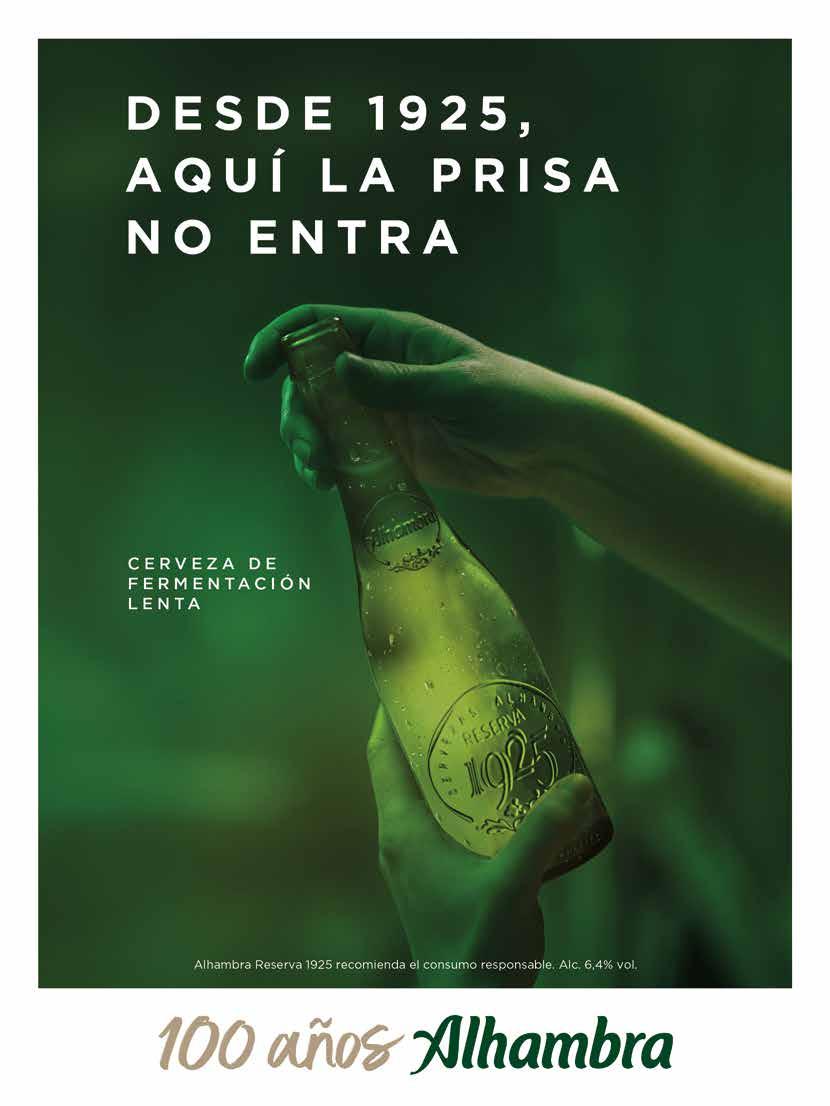
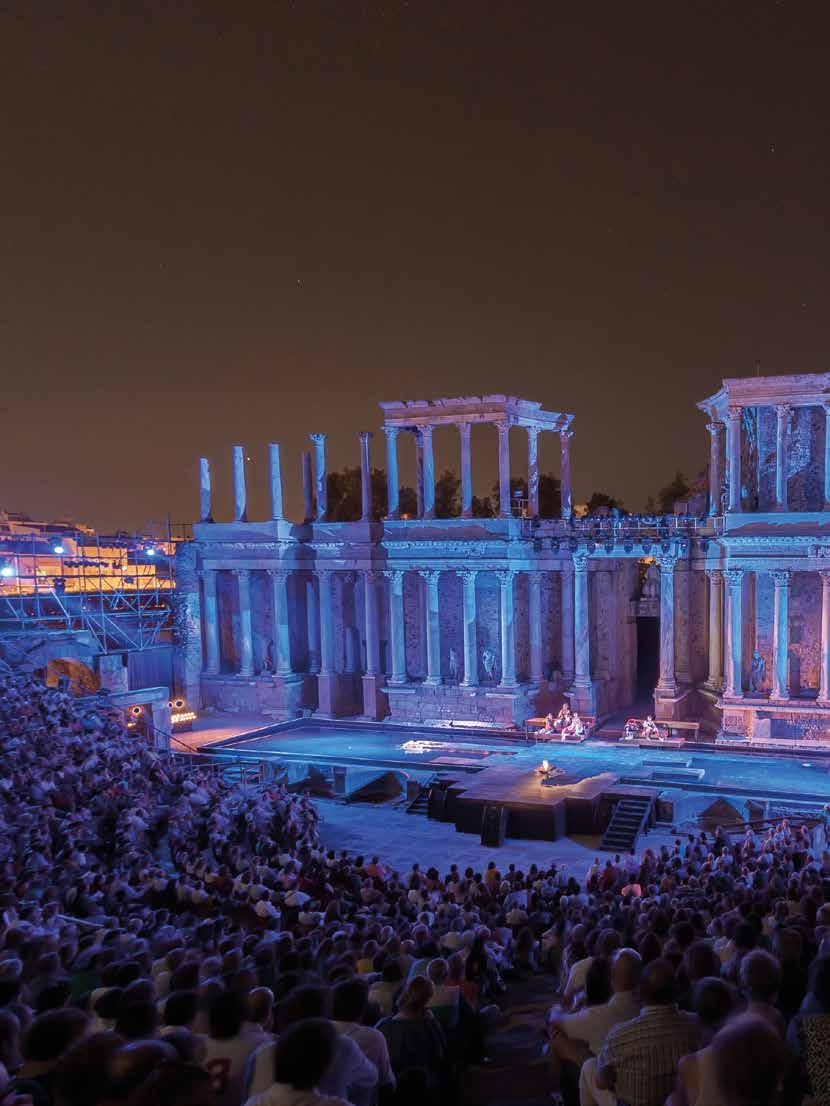
ROCA DE ETERNIDAD
STONE OF ETERNITY
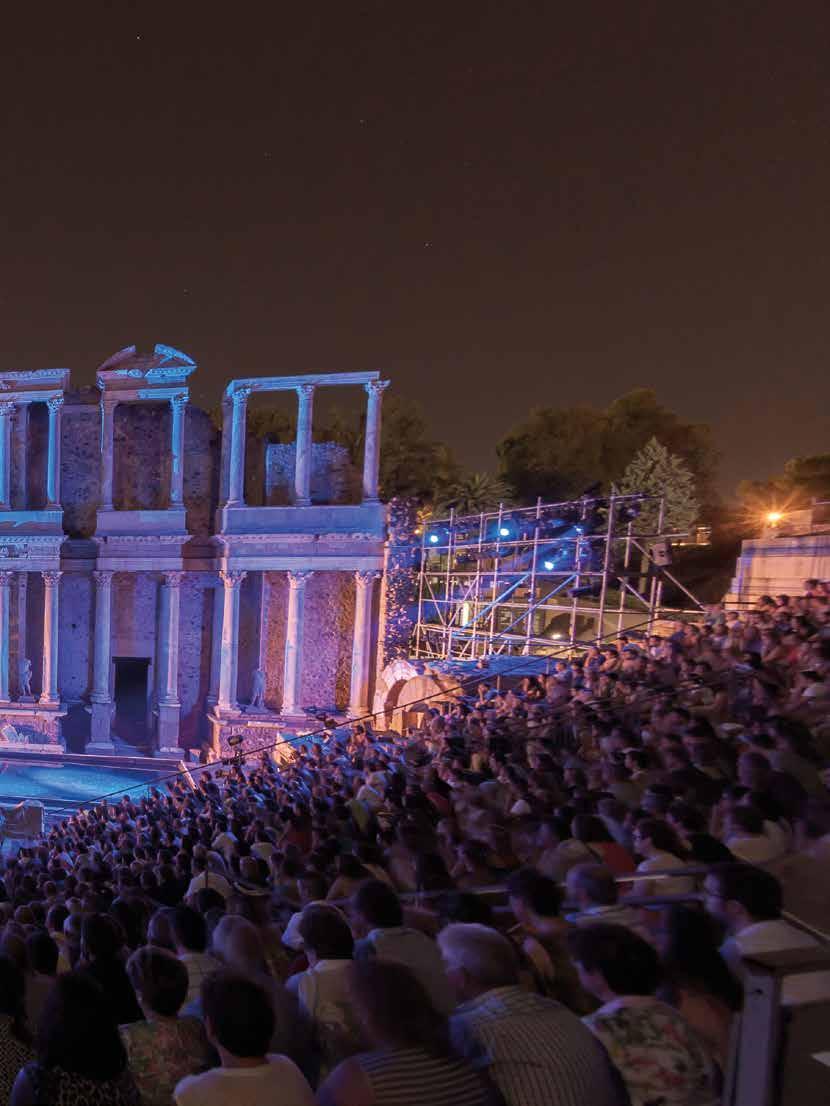
La 71.ª edición del Festival Internacional de Teatro Clásico desplegará su programa entre el 4 de julio y el 31 de agosto, con representaciones que volverán a dar vida al imponente Teatro Romano de Mérida. Las funciones se extenderán también a otros escenarios con solera: Madrid, Medellín, Regina y distintos espacios de la propia ciudad, incluido el recién recuperado Teatro María Luisa.
Mérida obra nuevamente el milagro de atraer a las mejores compañías, actores y actrices, con un repertorio eterno que bebe de los clásicos grecolatinos. Lo mejor es que el público acompaña fielmente esta bendita locura que planta una pica en Flandes en tiempos de efímero entretenimiento digital. Para muestra, un botón: la pasada edición congregó a 179 000 espectadores.
Entre el altísimo nivel de los espectáculos programados brillan dos títulos: Numancia, adaptada y dirigida por José Luis Alonso de Santos, y Las troyanas, que cuenta en su elenco con Mina El Hammani, en una versión poco conocida para el gran público. Ambos comparten en sendas entrevistas sus impresiones sobre el teatro y la vida.
/
The 71st edition of the International Classical Theater Festival will unfold its program from July 4 to August 31, with performances that will once again bring the imposing Roman Theatre of Mérida to life. The performances will also extend to other prestigious venues: Madrid, Medellín, Regina, and various spaces within the city itself, including the newly restored María Luisa Theatre.
Mérida works its miracle once again by attracting the best companies, actors, and actresses, with an eternal repertoire that draws from Greco-Roman classics. The best part is that the audience faithfully supports this blessed madness, which achieves a signal success in the times of fleeting digital entertainment. For proof, a simple example: the previous edition gathered 179,000 spectators.
Among the high level of the scheduled shows, two titles stand out: Numantia, adapted and directed by José Luis Alonso de Santos, and The Trojan Women, which features Mina El Hammani in a little-known version for the general public. Both share their impressions on theatre and life in separate interviews.

DRAMATURGO, DIRECTOR ESCÉNICO, GUIONISTA Y ACTOR ESPAÑOL


Numancia, de Cervantes, abrirá este año el Festival de Mérida bajo la dirección de José Luis Alonso de Santos. El veterano dramaturgo asume el reto de adaptar un texto complejo y poderoso, con ecos de actualidad, para vestirlo con la grandeza ritual que exige el teatro romano.



Ha adaptado y dirige un texto tan enérgico como Numancia. ¿Qué le atrajo de este texto cervantino para llevarlo a escena?
Es uno de los grandes textos clásicos españoles y, además, de Cervantes. Más allá de su calidad, hay que destacar su dificultad, porque es una obra muy compleja. Cuando se estrenó, el teatro de Lope aún no estaba asentado y se intentaba inventar una especie de tragedia nueva. Es complicado de llevar a escena, pero es gran teatro. Yo ya tengo mucho camino recorrido, y a estas alturas no la habría elegido si no fuera un reto.
A la hora de tocar el texto original, ¿qué tuvo en cuenta para enfrentarlo al público contemporáneo?
Quise conectarlo con el espectador actual. Igual que hay términos que hoy serían incomprensibles y conviene actualizar, hay temas que son eternos: la libertad, el honor o la dignidad humana. En la adaptación me he inclinado más hacia la cuestión histórica, la que plantea Cervantes, y he tendido un puente con la actualidad. Se trata de rescatar lo que pueda interesar hoy. Hay cosas en Numancia que parecen sacadas de los periódicos de esta mañana.
¿Cómo se ha movido entre la fidelidad al texto original y el ejercicio de la libertad creativa?
He hablado con Cervantes en mis noches de insomnio, a través del móvil de la imaginación, y le he preguntado qué cambiaría él. Me respondió que debía cambiar lo mismo que cambiaría él si estuviera vivo. Yo soy su representante y me he puesto en su piel. No he hecho nada en esta adaptación que al propio Cervantes no le gustara.
La lucha por la dignidad en el asedio a Numancia es un mensaje que hoy se tiene que escuchar, por infrecuente.
La palabra asedio se puede interpretar de muchas formas. Te asedian quienes te rodean y maltratan, tanto a nivel individual como colectivo. Quien es atacado tiene derecho a defenderse. Hay gente heroica que se sacrifica y escribe páginas para la historia. Aquí está la obra de Cervantes, pero también los hechos sucedidos en Numancia. Unos tíos en un pueblo de Soria le plantaron cara a Roma. Esa hazaña valerosa, esa lucha por ideales y por la defensa de una tierra, es también una defensa de España.
¿Qué pasa hoy con la libertad, corre el riesgo de perder su significado tras tanto manoseo?
Cuando se producen estos riesgos de deformación del relato, conviene ser sencillo e ir al diccionario. Para cualquier chico de colegio, o para alguien que está en la cárcel, la palabra libertad tiene un sentido muy claro: que no te opriman o que no te tengan preso. Luego, cada uno le puede meter su rollo. Las palabras pueden servir para defender o para aplastar valores. Estoy de acuerdo con el significado sagrado que le daba Cervantes. Tenga en cuenta que escribió esta obra al salir de prisión en Argel. ¡Cómo lo pasaría de mal!
La obra llega a Mérida después de su estreno en Alcalá. ¿Es una ventaja?
Por un lado, sí, porque llega más rodada. Pero, por otro, no. He tenido que hacer dos montajes diferentes porque la escenografía de un sitio no valía para el otro. Los espacios, en teatro, son muy importantes. Hemos procurado que en Alcalá tuviera la cercanía de lo íntimo y, en Mérida, la grandiosidad de lo que tiene detrás: el teatro romano. ¿Cómo influye este espacio en la concepción escénica?
El teatro te da una relación especial con el público, no solo porque tenga muchos más metros. Es un lugar monumental, con una tradición que el espectador percibe como un gran acontecimiento cultural y ciudadano. Así eran los espectáculos que allí se representaban.
You have adapted and are directing a text as energetic as Numantia. What attracted you to this Cervantes text?
It’s one of the great Spanish classical texts, and moreover, it’s by Cervantes. Beyond its quality, we must highlight its difficulty, because it’s a very complex work. When it premiered, Lope’s theatre was not yet well established, and they were trying to create a kind of new tragedy. It’s difficult to bring it to the stage, but it’s great theatre. I’ve already years of experience under my belt, and at this point, I wouldn’t have chosen it if it weren’t a challenge.
When adapting the original text, what did you take into account to make it relevant to a contemporary audience?
I wanted to connect it with the modern viewer. Just as there are terms today that would be incomprehensible and need updating, there are themes that are timeless: freedom, honour, and human dignity. In the adaptation, I leaned more towards the historical issue raised by Cervantes, and I built a bridge to the present. It’s about rescuing what might interest today. There are things in Numantia that could have been taken from this morning’s newspapers.
“THE THEATRE IN MÉRIDA TAKES ON THE GRANDEUR OF RITUAL, OF THE COLLECTIVE ACT”

Hablando del Festival, cada vez que usted viene sí que es un acontecimiento.
He hecho siete u ocho espectáculos, cada uno en una etapa diferente y con actores distintos. Siempre ha sido algo gratificante. El teatro en Mérida adquiere la grandeza del ritual, del acto colectivo. Quien no ha ido nunca no sabe lo que se ha perdido.
Como aficionado a la historia, y a las buenas historias, seguro que tendrá algún Parador favorito.
Los Paradores de algunos sitios están muy relacionados con el teatro, por ejemplo, el de Almagro o el de Mérida. En época de festivales es frecuente que me aloje en ellos y que conviva con los espectadores. Recuerdo que, en Almagro, como director de la Compañía Nacional de Teatro Clásico, el Parador estaba lleno de gente de l teatro o de personas que habían reservado con meses de antelación para asistir al Festival. Los Paradores siempre tienen que ver con los movimientos culturales. La gente viaja para ir a la playa, pero también para ir al teatro.
How have you navigated between staying faithful to the original text and exercising creative freedom?
I’ve spoken with Cervantes in my sleepless nights, through the mobile of imagination, and I asked him what he would change. He replied that I should change the same things he would change if he were alive. I am his representative, and I’ve put myself in his shoes. I haven’t done anything in this adaptation that Cervantes himself wouldn’t like.
The battle for dignity in the siege of Numantia is a message that must be heard today, for its rarity.
The word “siege” can be interpreted in many ways. You are besieged by those who surround and mistreat you, both on an individual and collective level. Those who are attacked have the right to defend themselves. There are heroic people who sacrifice themselves and write pages for history. Here is Cervantes’ work, but also the events that took place in Numantia. Some guys in a village in Soria stood up to Rome. That brave feat, that struggle for ideals and the defence of land, is also a defence of Spain. What about today’s freedom? Does it risk losing its meaning after so much misuse?
When there are risks of distorting the narrative, it’s best to be simple and refer to the dictionary. For any school kid or for someone in prison, the word “freedom” has a very clear meaning: not to be oppressed or imprisoned. Then, each person can add their own spin on it. Words can be used to defend or to crush values. I agree with the sacred meaning Cervantes gave it. Keep in mind that he wrote this work after coming out of prison in Algiers. How bad must it have been for him!
The play arrives in Mérida after its premiere in Alcalá. Is that an advantage?
On one hand, yes, because it’s more polished. But on the other hand, no. I’ve had to make two different setups because the set design for one place didn’t work for the other. The spaces in theatre are very important. We’ve tried to make it more intimate in Alcalá, and to capture the grandeur of what lies behind in Mérida: the Roman theatre.
How does this space influence the scenic conception?
The Roman theatre gives you a special relationship with the audience, not just because it’s much larger. It’s a monumental place, with a tradition that the audience perceives as a great cultural and civic event. That’s how the performances there used to be.
Talking about the Festival, every time you come, it truly is an event.
I’ve done seven or eight productions, each in a different phase and with different actors. It’s always been rewarding. The theatre in Mérida takes on the grandeur of ritual, of the collective act. Those who have never been there don’t know what they’ve missed.
As a history enthusiast, and a fan of good stories, you must surely have a favourite Parador.
Some Paradores are closely linked to theatre, such as those in Almagro or Mérida. During festival seasons, it’s common for me to stay in them and mingle with the audience. I remember that, in Almagro, as the director of the National Classical Theatre Company, the Parador was filled with theatre people or individuals who had booked months in advance to attend the festival. Paradores are always connected to cultural movements. People travel to go to the beach, but also to go to the theatre.
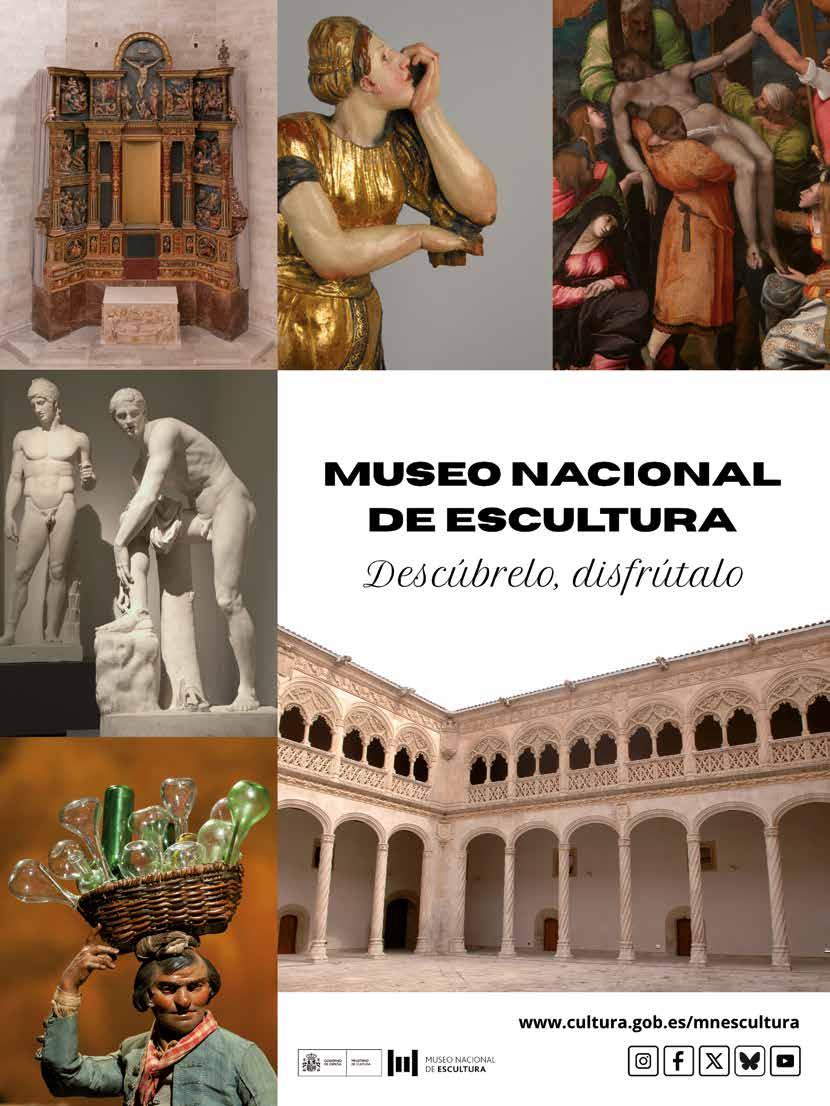

Si bien las series han servido para poner ante el espectador la magnética presencia de Mina El Hammani, solo son un exiguo muestrario de su potencial. Mina es mucho más. Así lo comprobarán de primera mano quienes se acerquen al Teatro Romano emeritense para pasmarse ante Las troyanas , el clásico de Eurípides adaptado por Carlota Ferrer e Isabel Ordaz. Una oportuna reflexión sobre los desastres de la guerra y sus víctimas más recurrentes: las mujeres.
While TV series have allowed audiences to experience the magnetic presence of Mina El Hammani, they only represent a small sample of her potential. Mina is much more. This will be proven first-hand by those who approach the Roman Theatre in Mérida to marvel at The Trojan Women, the classic by Euripides adapted by Carlota Ferrer and Isabel Ordaz. A timely reflection on the disasters of war and its most frequent victims: women.
No es su primera vez en el Festival de Mérida. Ya interpretó a la reina Yocasta en Edipo. ¿Qué recuerda de aquella primera experiencia?
Ese proyecto llegó en un momento muy delicado para mí... Estaba viviendo cosas personales bastante intensas, y subirme al escenario en Mérida fue... increíble. Es un sitio con tanta fuerza, tanta historia, que te envuelve. Interpretar a Yocasta, con todo lo que carga ese personaje, fue casi terapéutico. Recuerdo que, a pesar de lo que estaba viviendo, me sentí muy arropada, muy conectada con el público, con el equipo... Fue una experiencia que no voy a olvidar nunca.
En esta ocasión, forma parte del plantel de un clásico tan poderoso como Las troyanas. ¿Qué le llamó la atención de esta historia?
Es una obra que tiene una fuerza brutal. Habla del dolor, de la pérdida, pero también de la dignidad y la resistencia de las mujeres en medio del desastre. Cuando me llegó la propuesta, me removió muchísimo. Además, tenía muchas ganas de trabajar con Carlota Ferrer. Admiro mucho su mirada, cómo construye desde lo simbólico, desde lo corporal, desde lo emocional... Sabía que con ella esta historia iba a contarse desde un lugar muy especial. Es un regalo estar en este proyecto.
«Como mujer, como hija de migrantes, como actriz, he sentido muchas veces la necesidad de demostrar
This is not your first time at the Mérida Festival. You already played Queen Jocasta in Oedipus. What do you remember about that first experience?
That project came at a very delicate moment for me... I was going through some very intense personal things, and stepping onto the stage in Mérida was... incredible. It’s such a powerful place, with so much history, it just envelops you. Playing Jocasta, with all that character carries, was almost therapeutic. I remember that, despite what I was going through, I felt very supported, very connected with the audience, with the team... It was an experience I’ll never forget.
This time, you are part of the cast in such a powerful classic as The Trojan Women. What drew you to this story?
It’s a play with a brutal strength. It talks about pain, loss, but also about the dignity and resistance of women amidst disaster. When the proposal came to me, it really moved me. Also, I was eager to work with Carlota Ferrer. I admire her vision a lot, how she constructs from the symbolic, from the physical, from the emotional... I knew that with her, this story would be told from a very special place. It’s a gift to be part of this project.
Despite your youth, you are a well-established and respected actress. Does a stage like the Roman Theatre in Mérida intimidate you?
It really does. I had the luck of being in Mérida performing as Jocasta in Oedipus, but I have to say that the nerves you feel there are unique, I had never experienced
A pesar de su juventud, es una actriz consolidada y valorada. ¿Le impone respeto un escenario como el Teatro Romano de Mérida?
Muchísimo. Tuve la suerte de estar en Mérida interpretando a Yocasta en Edipo, pero tengo que decir que los nervios que se sienten allí son únicos, nunca antes había experimentado algo así. Cada función es diferente y especial. Estoy muy emocionada, sí, y muy agradecida de poder compartir escenario con todos mis compañeros y, en esta ocasión, de la mano de Carlota Ferrer.
Las troyanas es un grito contra la guerra y la violencia sobre los cuerpos de las mujeres. Desde Eurípides, la cosa no ha cambiado tanto…
Sigue siendo un reflejo brutal y necesario de cómo la guerra y la violencia impactan especialmente a las mujeres. Desde Eurípides hasta hoy, la tragedia persiste, y la obra nos recuerda esa realidad que no ha cambiado tanto. Por eso me parece importante llevarla al escenario ahora, para que el público pueda reflexionar sobre esas heridas que siguen abiertas y no se silencien. Es un grito que sigue vigente y que estamos viendo todos los días, en Gaza mismamente.
Su personaje es, a la vez, un reto interpretativo y una oportunidad de crecimiento actoral. ¿Lo ve así?
Totalmente. Siento que este personaje va a marcar un antes y un después en mi camino, no solo como actriz, sino también como persona. Es un personaje muy complejo, en una obra muy potente, y sé que va a ser un proceso intenso, pero también un crecimiento enorme.
¿Se reconoce en el espíritu de resistencia de estas mujeres?
Sí, me reconozco mucho en el espíritu de resistencia de Las troyanas. Creo que todas, en mayor o menor medida, hemos tenido que resistir, por nuestro lugar, nuestra identidad o, simplemente, poder ser nosotras mismas sin tener que justificarnos todo el tiempo. En mi caso, como mujer, hija de migrantes y actriz, he sentido muchas veces la necesidad de demostrar el doble, de romper estereotipos, de hacerme un hueco en espacios donde no siempre ha sido fácil.
Una de las mejores experiencias de Mérida es pasar por su Parador. ¿Conoce la red de Paradores? ¿Tiene alguno favorito?
Este año quiero ir sí o sí y disfrutarlo.

anything like it before. Each performance is different and special. I’m very excited, yes, and very grateful to be able to share the stage with all my colleagues and, this time, with Carlota Ferrer.
The Trojan Women is a cry against war and violence on the bodies of women. Since Euripides, things haven’t changed much...
It still serves as a brutal and necessary reflection of how war and violence especially affect women. From Euripides to today, tragedy persists, and the play reminds us of this reality that hasn’t changed much. That’s why I think it’s important to bring it to the stage now, so the audience can reflect on those wounds that are still open and should not be silenced. It’s a cry that remains as timely as ever, and we see it every day, for example in Gaza.
Your character is both an interpretative challenge and an opportunity for acting growth...
Absolutely. I feel that this character is going to mark a before and after in my journey, not just as an actress, but also as a person. It’s a very complex character in a very powerful play, and I know it will be an intense process, but also a tremendous growth experience.
Do you recognize yourself in the spirit of resistance of these women?
Yes, I recognize myself a lot in the spirit of resistance in The Trojan Women. I believe that all of us, to a greater or lesser degree, have had to resist, for our place, our identity, or simply to be ourselves without having to justify ourselves all the time. In my case, as a woman, daughter of immigrants, and an actress, I have often felt the need to prove twice as much, to break stereotypes, and to carve out a space in areas where it hasn’t always been easy.
One of the best experiences in Merida is staying at the Parador. Are you familiar with the Paradores Network? Do you have a favourite?
This year, I definitely want to go and enjoy it.
“AS A WOMAN, DAUGHTER OF IMMIGRANTS, AND AN ACTRESS, I HAVE OFTEN FELT THE NEED TO PROVE TWICE AS MUCH”
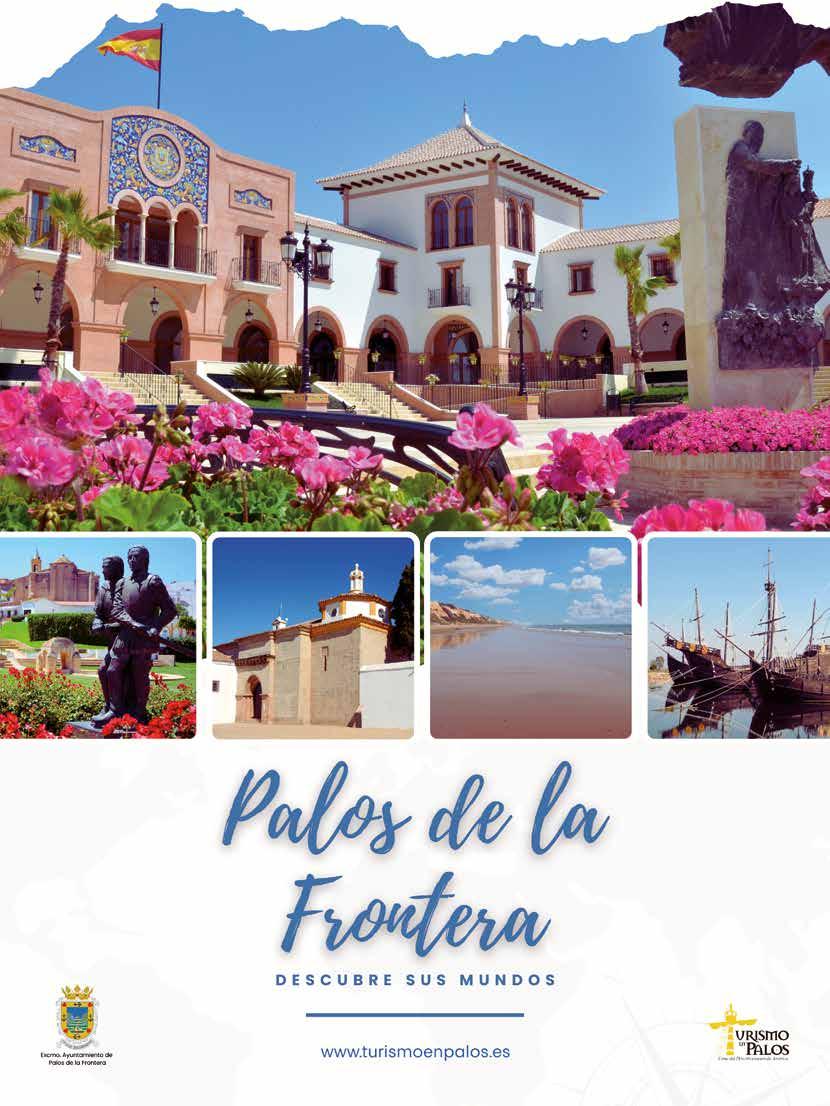
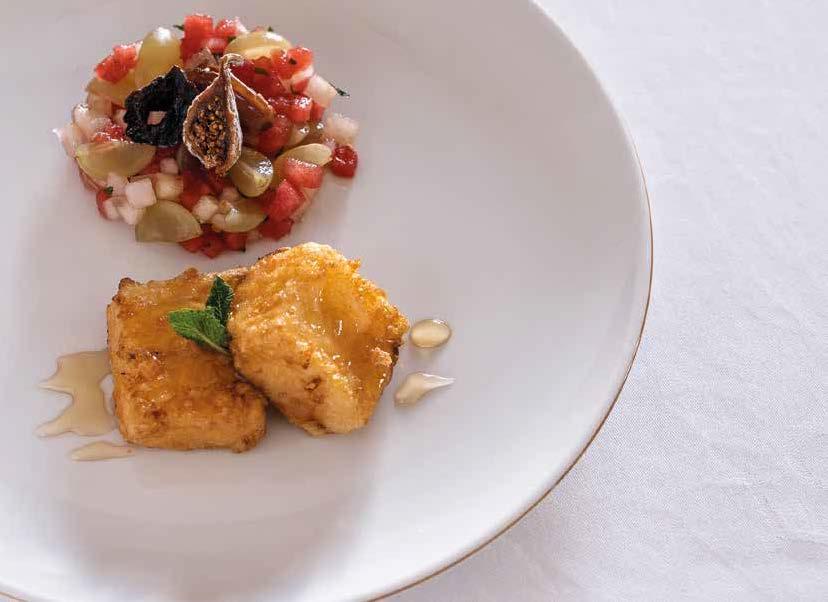
During the days of the International Classical Theater Festival, the Parador of Mérida becomes an unofficial headquarters for the event. In its halls and corridors, actors and directors cross paths and coexist with the respectful audience who has chosen this establishment as the best place to rest. As the saying goes: primum vivere, deinde philosophari. Not for nothing will the kitchens of the Parador produce –only during these days– a menu capable of nourishing both the body and the spirit.
The “Odysseus Menu” embraces the gastronomic identity of the Parador with that of the festival itself, drawing inspiration from Mario Vargas Llosa’s work Odysseus and Penelope. For the chronicles of the city, it remains noted that the Peruvian Nobel laureate performed his own text at the Roman Theatre, alongside Aitana SánchezGijón and directed by Joan Ollé.
The proposal, naturally, has Roman flavours. Thus, in the gustatio –the appetizers– diners will be able to taste perdix salsamenta acetaria (pickled partridge salad), cynare coctae cum aurantiis, melle et oleo (artichokes with citrus, honey, and olive oil), and patina de asparagis (asparagus pie).
Moving on to more substantial fare, the prima mensa offers two main dishes: labrax, brassica et garum escombrarum (sea bass, cabbage, and Escombreras garum, the popular sauce of the time) and another meat option: agnum assum cum napis et curcubita Alexandrina (roast lamb with spices, celeriac cream, and sautéed pumpkin). The secunda mensa is a delight for those with a sweet tooth: fried milk and a fruit salad (figs, melon, watermelon, grapes, prunes, and dates). The pairing is completed with spiced wines (white and red), water from the Alange spa, and a tisane of magical herbs.

Durante los días del Festival Internacional de Teatro Clásico, el Parador de Mérida se convierte en una sede oficiosa de la muestra. En sus salones y pasillos se cruzan –y conviven– actores y directores con el respetable público que ha elegido este establecimiento como el mejor lugar de descanso. Dice la cita: primum vivere, deinde philosophari. No en vano, de las cocinas del Parador saldrá –solo durante estos días– un menú capaz de alimentar el cuerpo y el espíritu.
El «Menú Odiseo» abraza la identidad gastronómica del Parador con la del propio Festival, tomando como inspiración la obra Odiseo y Penélope , escrita por Mario Vargas Llosa. Para las crónicas de la ciudad queda que el nobel peruano interpretó su propio texto en el Teatro Romano, junto a Aitana Sánchez-Gijón y bajo la dirección de Joan Ollé.
La propuesta, naturalmente, tiene aires romanos. Así, en la gustatio –entremeses– los comensales podrán degustar perdix salsamenta acetaria (ensalada de perdiz en escabeche), cynare coctae cum aurantiis, melle et oleo (alcachofas con cítrico, miel y aove) y patina de asparagis (pastel de espárragos).
Entrando en palabras mayores, la prima mensa cuenta con dos platos principales: labrax, brassica et garum escombrarum (lubina, col y garum de Escombreras, la popular salsa de la época) y otra opción cárnica: agnum assum cum napis et curcubita Alexandrina (cordero asado con especias, crema de apio nabo y calabaza salteada). La secunda mensa es una perdición para los golosos: leche frita y macedonia de frutas (higos, melón, sandía, uvas, ciruelas pasas y dátiles). El maridaje se completa con vinos especiados (blanco y tinto), agua del balneario de Alange y una tisana de hierbas mágicas.
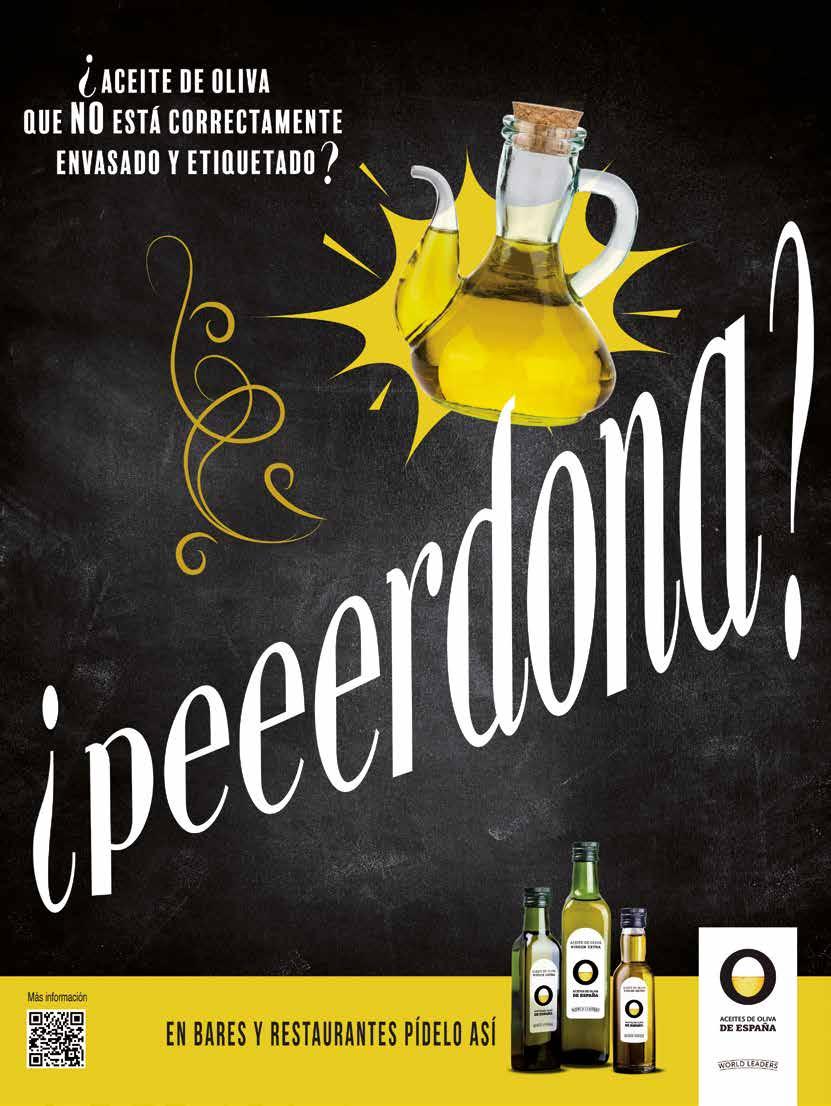
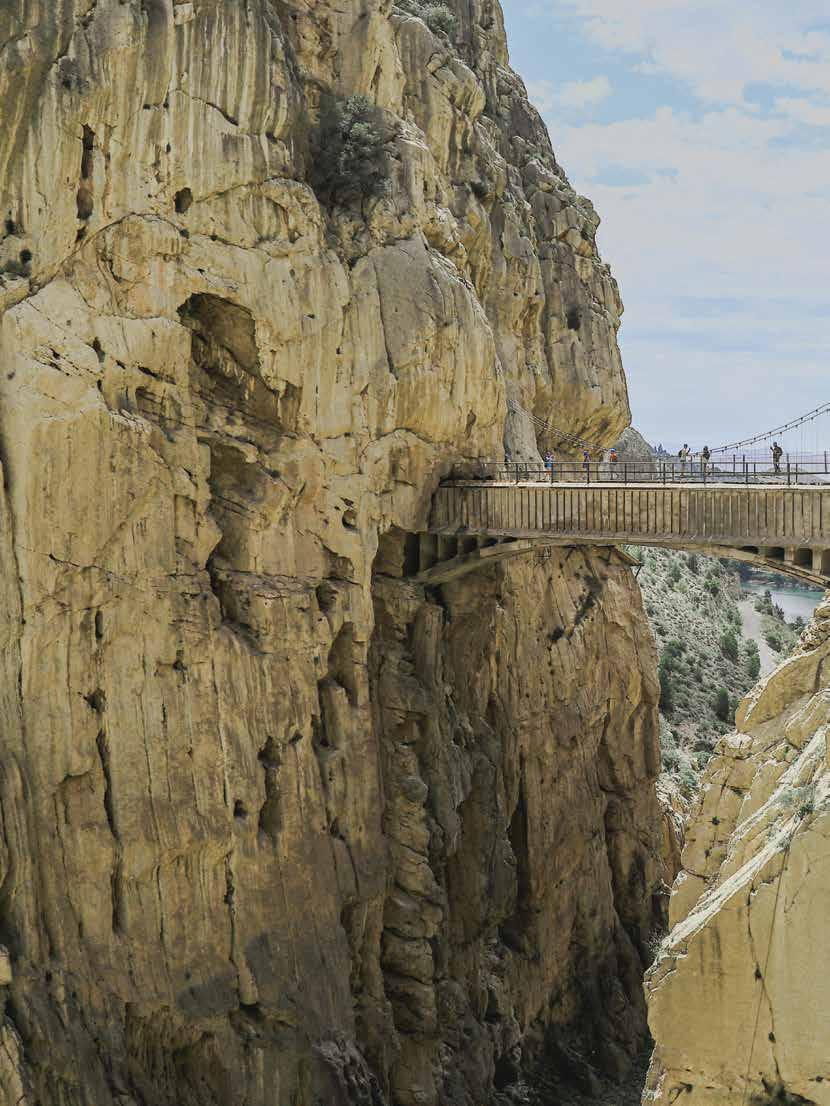
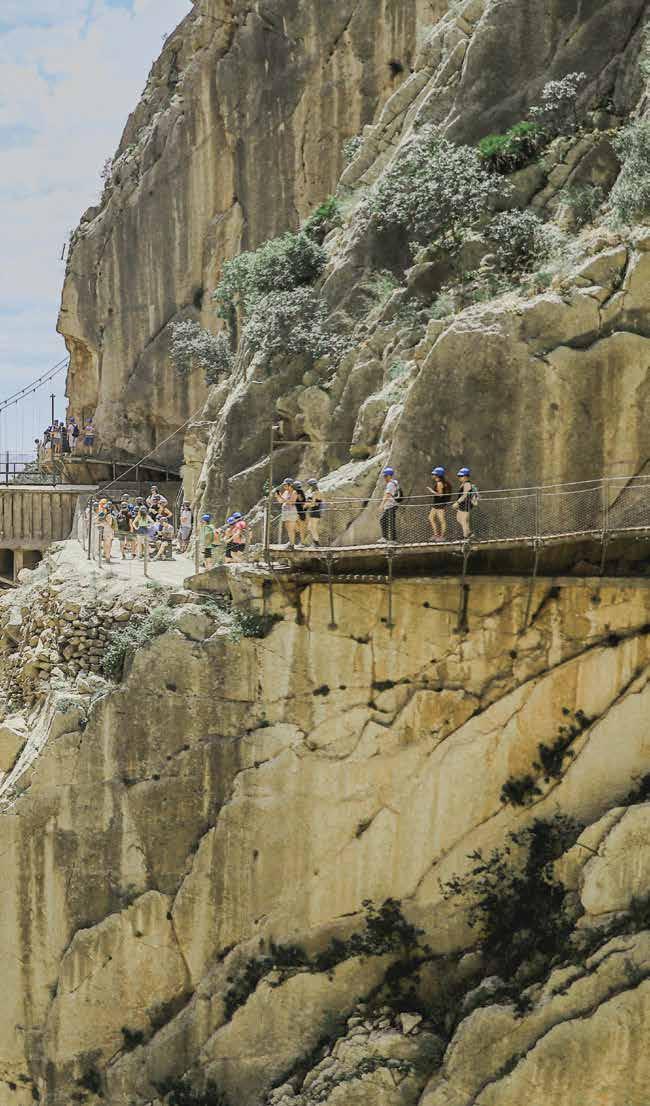
Suspendido entre paredes de vértigo y paisajes que cortan la respiración, el Caminito del Rey es una experiencia única que une historia, ingeniería y naturaleza. /
Suspended between vertigo-inducing walls and breathtaking landscapes, the Caminito del Rey is a unique experience that combines history, engineering, and nature.
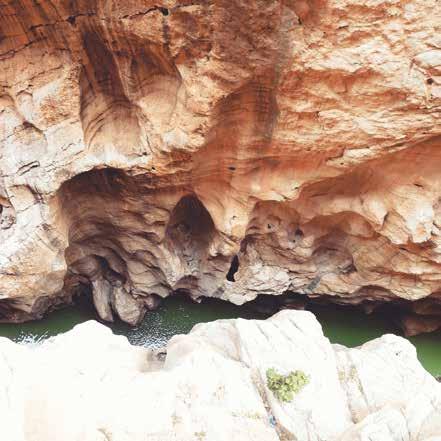
Debe su nombre al rey Alfonso XIII, que lo recorrió en 1921 para inaugurar la presa del Conde del Guadalhorce. Originalmente, fue construido entre 1901 y 1905 como sencilla pasarela de mantenimiento para operarios de las centrales hidroeléctricas de El Chorro y Gaitanejo. Conocido como «sendero más peligroso del mundo», sufrió décadas de abandono, hasta su reinauguración en 2015. Gracias a modernos sistemas de protección, accesos acondicionados y un impecable control de visitas, se ha convertido en un modelo ejemplar de turismo sostenible.
El trazado tiene una longitud total de 7,7 km y casi tres transcurren sobre serpenteantes pasarelas ancladas a más de cien metros de altura sobre el cañón del río Guadalhorce. El resto combina senderos naturales y caminos de acceso que atraviesan verdes pinares, frescos túneles excavados en la roca e impresionantes miradores naturales.
Todo el trayecto regala vistas a un espectacular entorno natural. Desde cualquiera de los dos accesos, la ruta comienza a través de un túnel, cerca del embalse del Conde de Guadalhorce, donde el murmullo del agua y los primeros carteles anticipan lo que está por venir.
El primer cañón, Desfiladero de Gaitanejo, marca el verdadero inicio del camino, donde el sendero se estrecha y la pasarela se adhiere a la pared de roca. Desde ahí se accede al segundo cañón, Tajo de las Palomas, que destaca por su biodiversidad y formación geológica. En sus riscos anidan aves rapaces, como el buitre leonado, que sobrevuela el paisaje. Seguido, un tramo sereno atraviesa el Valle del Hoyo por tierra firme, un buen lugar para recuperar fuerzas antes de afrontar sustos mayores.
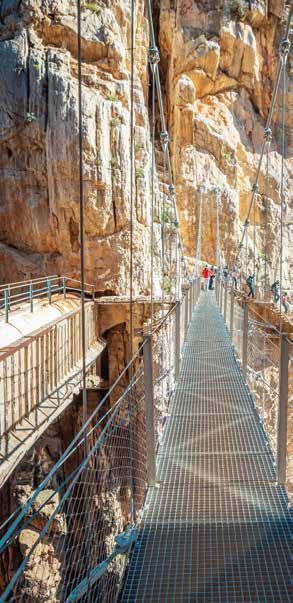
El punto culminante es el Desfiladero de los Gaitanes, estrecho paso de paredes casi verticales donde la grandiosidad del paisaje proporcio na imágenes inolvidables. A mitad de camino, la pasarela de cristal sobre el río añade dosis extra de adrenalina y vistas inigualables. El final del camino está marcado por un puente colgante de treinta y cinco metros que une las dos paredes del cañón: un broche de oro para los más atrevidos.

El Caminito del Rey es, sobre todo, una lección de convivencia entre el hombre y la montaña, una aventura que empieza con un paso y termina con una ovación silenciosa al paisaje. Propone un recorrido para mirar hacia abajo con respeto, hacia arriba con asombro y hacia dentro con calma. Pocas rutas permiten, en apenas unas horas, atravesar siglos de historia, kilómetros de roca viva e incesantes emociones para no olvidar jamás.

It owes its name to King Alfonso XIII, who walked it in 1921 to inaugurate the Conde del Guadalhorce Dam.
Originally, it was built between 1901 and 1905 as a simple maintenance walkway for workers at the El Chorro and Gaitanejo hydroelectric plants. Known as the “most dangerous path in the world,” it suffered decades of neglect until its reopening in 2015. Thanks to modern protection systems, improved access, and impeccable visitor control, it has become an exemplary model of sustainable tourism.
The trail has a total length of 7.7km, nearly three of which run along winding walkways anchored more than one hundred meters above the Guadalhorce River canyon. The rest combines natural trails and access paths that pass through lush pine forests, cool tunnels carved into the rock, and stunning natural viewpoints.
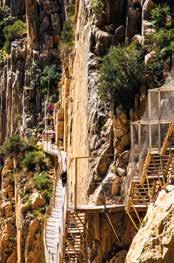
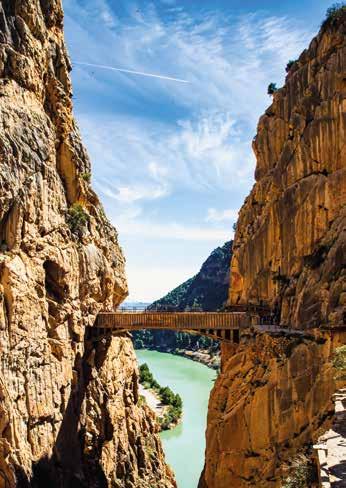
The entire journey offers breathtaking views of a spectacular natural environment. From either of the two access points, the route begins through a tunnel near the Conde de Guadalhorce reservoir, where the murmur of the water and the first signs anticipate what lies ahead.
The first gorge, Desfiladero de Gaitanejo, marks the true start of the path, where the trail narrows and the walkway clings to the rock wall. From there you can reach the second gorge, Tajo de las Palomas, known for its biodiversity and geological formation. Its cliffs are home to birds of prey, such as the griffon vulture, which soars over the landscape. Next, a serene stretch crosses the Valle del Hoyo along solid ground, a good place to regain strength before facing greater thrills.
The climax of the trail is the Desfiladero de los Gaitanes, a narrow passage with almost vertical walls where the grandeur of the landscape provides unforgettable images. Halfway through, the glass walkway over the river adds an extra dose of adrenaline and unparalleled views. The end of the path is marked by a 35-meter hanging bridge that connects the two canyon walls: a golden finishing touch for the most daring.
The Caminito del Rey is, above all, a lesson in coexistence between man and the mountain, an adventure that begins with a step and ends with a silent ovation to the landscape. It offers a route to look down with respect, up with wonder, and inward with calm. Few routes allow, in just a few hours, to cross centuries of history, miles of bare rock, and endless emotions that will never be forgotten.
This is not a demanding route, as it lacks significant slope, but it is advisable to be well-prepared. The route, which lasts a little over three hours, requires comfortable footwear and clothing compatible with the safety gear provided by the organization. The route is linear and runs from north to south, but there is a shuttle bus service that connects the different access points.
The walkway section does not have designated spaces for eating, so it is necessary to plan a meal either before or after –to avoid crowds–and, of course, bring sun protection and plenty of water. The opening hours are from 09:00 to 17:00, but it is recommended to avoid the central hours of the day and check the weather forecast to avoid the hottest days of the summer
Since its reopening in 2015, it receives 300,000 visitors annually.
Guided tours are available. It is necessary to book in advance through the official website.
Children under eight years old are not allowed on the trail, and those under eighteen must be accompanied by an adult.
It can be reached by car from Ronda, Antequera, or Málaga (just under an hour), by train from Málaga station (to the El Chorro, Caminito del Rey station), or by bus (including private services and shuttle buses organized by tourism companies in the city).
No se trata de una ruta exigente, ya que carece de marcado desnivel, pero es recomendable ir preparado. El recorrido, de poco más de tres horas, precisa calzado y ropa cómoda compatible con el equipo de seguridad que proporciona la organización. La ruta es lineal y en dirección norte a sur, pero existe servicio de bus lanzadera que conecta los diferentes puntos de acceso.
El tramo de pasarelas no cuenta con espacios habilitados para comer, por lo que es necesario planear un almuerzo antes o después –para evitar aglomeraciones– y, por supuesto, protección solar y agua en abundancia. El horario de apertura es de 09:00 a 17:00 horas, pero se recomienda evitar las horas centrales del día y consultar la meteorología para evitar las jornadas más calurosas del verano.
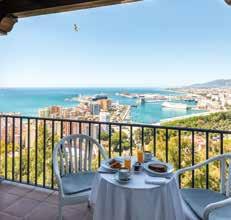
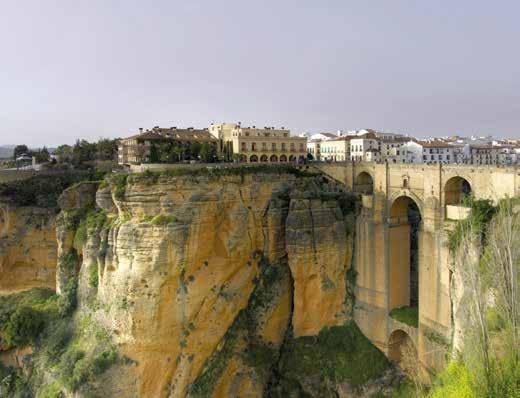
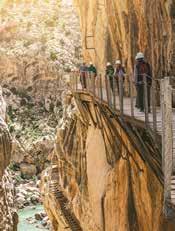
Desde su reapertura, en 2015, recibe 300 000 visitantes al año.
Hay visitas guiadas. Es necesario reservar con suficiente antelación desde la web oficial.
Los menores de ocho años no pueden acceder al trazado y hasta los dieciocho, deben ir acompañados por un adulto.
Se puede llegar en coche desde Ronda, Antequera o Málaga (algo menos de una hora), en tren desde la estación de Málaga (hasta la estación de El Chorro, Caminito del Rey) o en autobús (incluyendo servicios privados y lanzaderas organizadas por empresas de turismo en la ciudad).
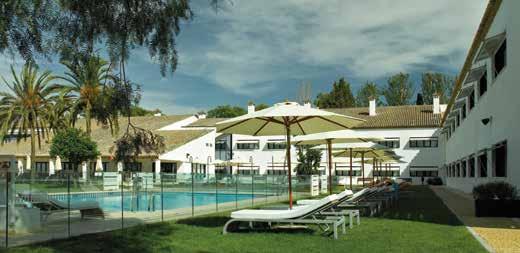
La provincia de Málaga cuenta con una variada selección de Paradores para planificar la aventura. El histórico Parador de Ronda ofrece descanso con vistas panorámicas excepcionales, un mirador que asoma al paisaje único del Tajo. El Parador de Antequera rompe la tendencia de edificio histórico con un entorno de lujo y modernidad en el corazón de Andalucía para una desconexión total. En Málaga capital, el Parador de Gibralfaro brinda un espectacular balcón con vistas Mediterráneo, perfecto para cualquier ocasión. Y Parador de Málaga Golf, con un campo de dieciocho hoyos, piscina, tenis y una larga playa de arena blanca, no necesita más presentación.
The province of Málaga offers a diverse selection of Paradores to plan your adventure. The historic Parador de Ronda provides rest with exceptional panoramic views, a lookout overlooking the unique landscape of the Tajo gorge. The Parador of Antequera breaks the trend of historic buildings with a luxury and modern setting in the heart of Andalusia for a complete disconnection. In Málaga city, the Parador of Gibralfaro offers a spectacular balcony with Mediterranean views, perfect for any occasion. And the Parador of Málaga Golf, with an 18-hole golf course, a pool, tennis, and a long stretch of white sand beach, needs no further introduction.
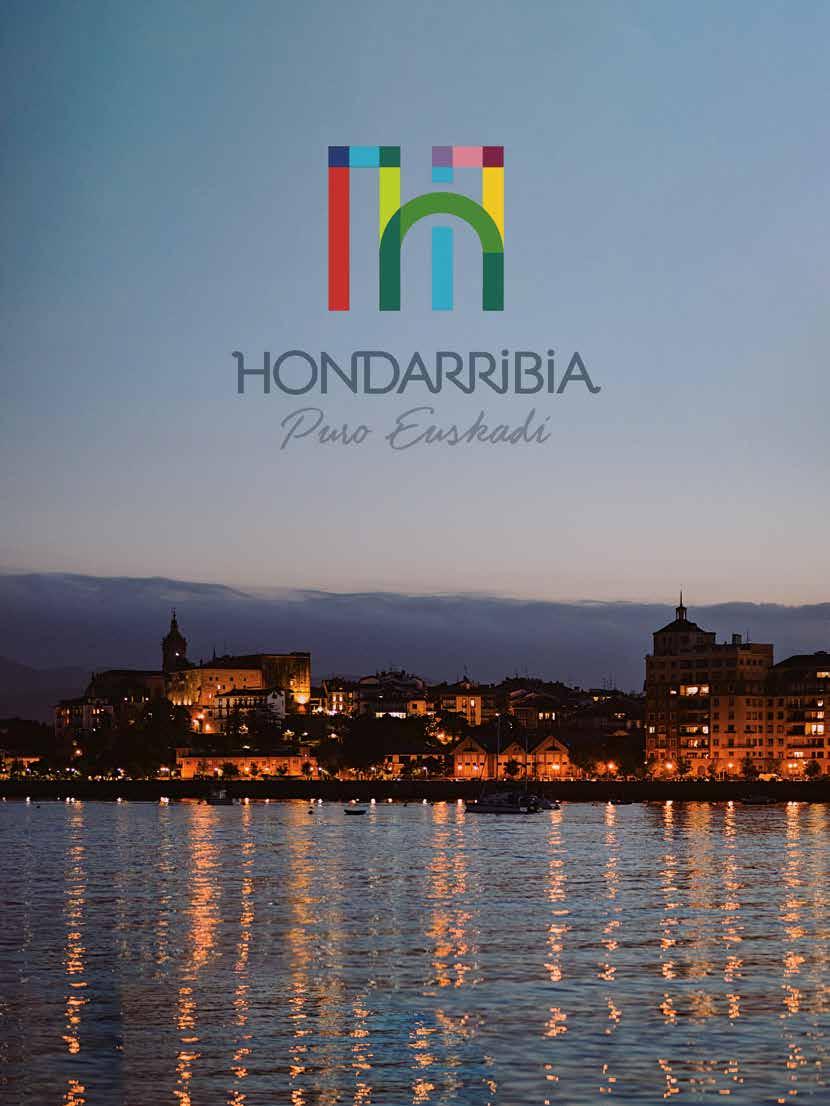
VIVIR EL PAISAJE CON ALMA
Paradores abre las puertas a lugares extraordinarios y, a la vez, despierta los sentidos a la naturaleza que los envuelve. Bajo el programa «Naturaleza para los Sentidos», se proponen experiencias auténticas que conectan con el entorno a través de aromas, sonidos, sabores y paisajes, guiadas por quienes mejor conocen cada territorio. Escuchar el murmullo de un río desde una canoa, oler el pinar atlántico al caer la tarde, sentir el trote de un caballo entre montañas de leyenda o mirar las estrellas desde la cima del mundo. Un viaje emocional que invita a redescubrir lo esencial.
LIVING THE LANDSCAPE WITH SOUL
Paradores opens the doors to extraordinary places, while also awakening the senses to the nature that surrounds them. Under the program “Nature for the Senses,” authentic experiences are offered that connect with the environment through aromas, sounds, flavours, and landscapes, guided by those who best know each territory. Listen to the murmur of a river from a canoe, smell the Atlantic pine forest at dusk, feel the trot of a horse among legendary mountains, or gaze at the stars from the top of the world. An emotional journey that invites you to rediscover what is essential.
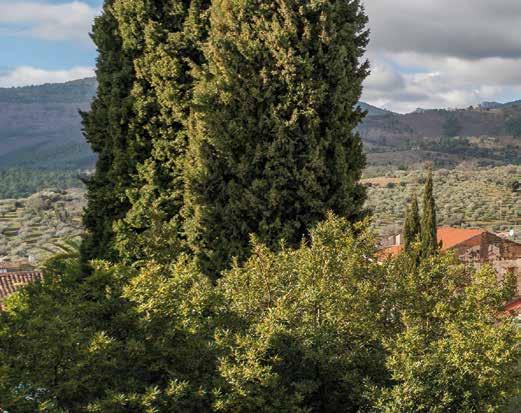
CIELO DESDE LAS CUMBRES
Ruta en 4x4 por el Geoparque Villuercas Ibores Jara para explorar su origen geológico, fósiles y paisajes modelados por la historia natural y cultural.
THE SKY FROM THE SUMMIT
4x4 route through the Villuercas Ibores Jara Geopark to explore its geological origin, fossils, and landscapes shaped by natural and cultural history.
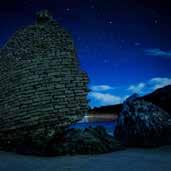
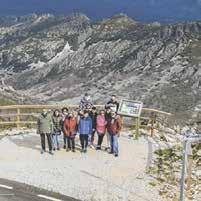
Descubre nuestras actividades/ Discover our activities

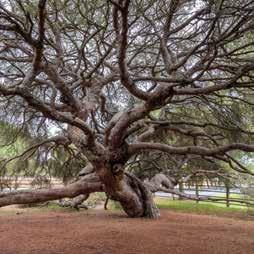
Recorrido nocturno para descubrir la fauna, la flora y la historia reciente del entorno, con relatos sobre los poblados forestales y la luna como guía y protagonista.
NIGHT OF MOON AND STARS
Night tour to discover the fauna, flora, and recent history of the surroundings, with tales about forest villages and the moon as the guide and protagonist.
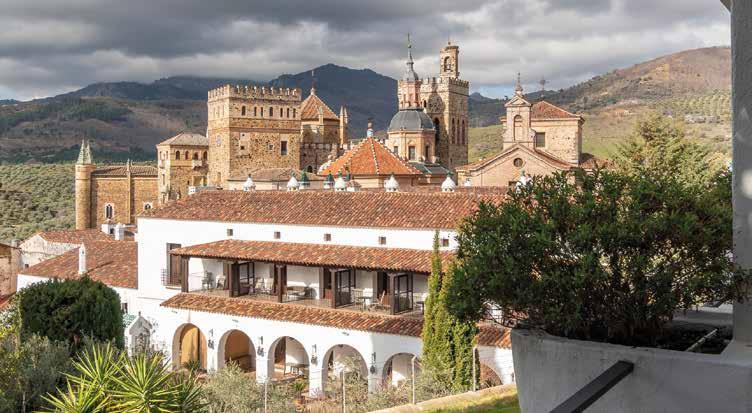
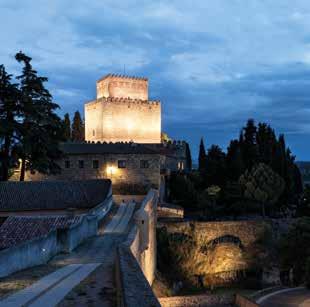
LAS ESTRELLAS
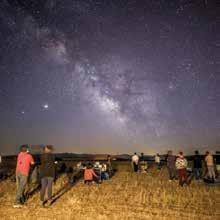
Observación astronómica con telescopios inteligentes para identificar astros y cielo profundo, acompañada de relatos mitológicos y libres de contaminación lumínica.
THE STARS
Astronomical observation with smart telescopes to identify stars and deep sky objects, accompanied by mythological stories and free from light pollution.
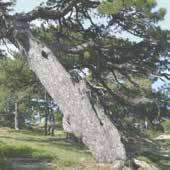
Ruta interpretativa por la Sierra de Cazorla para descubrir la historia, usos y simbolismo de pinos centenarios, tejos milenarios y especies vegetales únicas de la zona.
AMONG PINES AND YEWS
Interpretive route through the Sierra de Cazorla to discover the history, uses, and symbolism of ancient pines, millenarian yews, and unique plant species of the area.
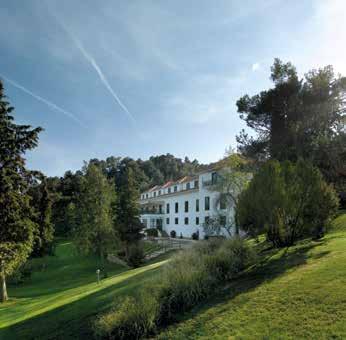
INMERSIÓN
Exploración del pinar para conocer sus usos históricos, su papel actual y futuro, su resiliencia al fuego y, opcionalmente, disfrutar de una meditación con vistas desde la Ventana del Nublo.
Exploration of the pine forest to learn about its historical uses, its current and future role, its resilience to fire, and, optionally, enjoy a meditation with views from the Ventana del Nublo rock.
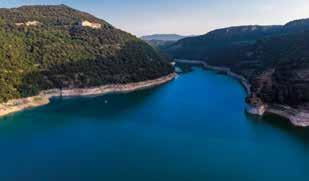
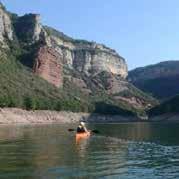
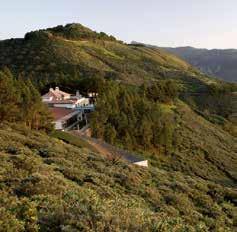
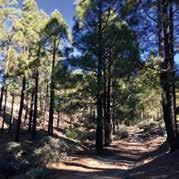
PARADOR DE SORIA
VIDA EN EL DUERO
Visita a una explotación acuícola familiar para conocer el ciclo de vida de la trucha, la importancia del agua y practicar pesca con opción de devolución o degustación.
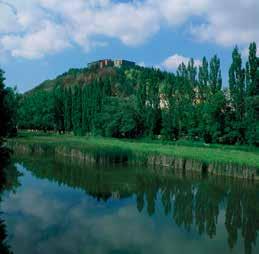

A visit to a family-owned fish farm to learn about the life cycle of trout, the importance of water, and to practice fishing with the option for catch and release or tasting.
Actividad de kayak guiado por la Riera Mayor, con paradas en la iglesia de San Román de Sau y el mirador del Morro de la Abeja. Incluye aprendizaje básico de navegación y descubrimiento del entorno natural e histórico.
A guided kayaking activity along the Riera Mayor, with stops at the San Román de Sau church and the Morro de la Abeja viewpoint. It includes basic navigation learning and the exploration of the natural and historical surroundings.
PARADOR DE GREDOS
PALABRAS CON HISTORIA
Visita al Parador de Gredos para recorrer sus estancias históricas, escenario de hechos clave del país, y descubrir su entorno natural, antiguas caballerizas y orígenes turísticos.
WORDS WITH HISTORY
Visit to the Parador of Gredos to explore its historic rooms, which have been the backdrop for key events in the country, and discover its natural surroundings, ancient stables, and tourism origins.
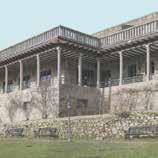
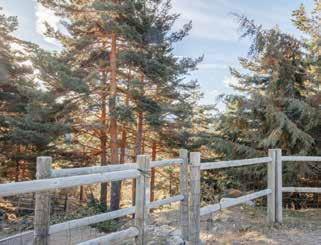
Ruta en 4x4 por Cangas del Narcea para descubrir la fauna, flora, patrimonio cultural y tradiciones locales, con observación del oso pardo, visita al Santuario del Acebo, picnic sostenible en la braña de Los Cadavales y taller de alfarería negra.
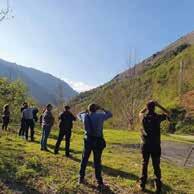
4x4 route through Cangas del Narcea to discover the fauna, flora, cultural heritage, and local traditions, with brown bear observation, a visit to the Santuario del Acebo, a sustainable picnic in the Los Cadavales pasture, and a black pottery workshop.
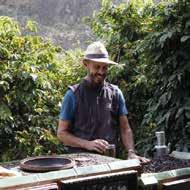
PARADOR DE CRUZ DE TEJEDA
EL CAFÉ DE EUROPA NACE AQUÍ
Visita a una plantación de café en el Valle de Agaete para conocer su cultivo y tueste, y finalizar con una degustación del café producido en la propia finca.
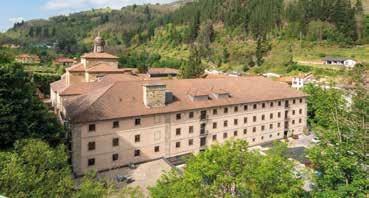
LA ABEJA REINA
Visita a los campos de cultivo del Bierzo para conocer el papel fundamental de las abejas en la naturaleza, la agricultura y la tradición local, con recorrido por una colmena apadrinada por el Parador de Villafranca y explicación del proceso de producción de miel.

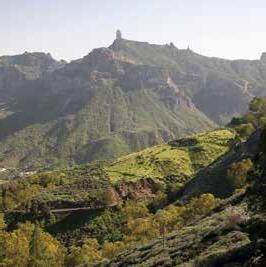
THE COFFEE OF EUROPE IS BORN HERE
A visit to a coffee plantation in the Agaete Valley to learn about its cultivation and roasting, which ends with a tasting of the coffee produced on the farm.
THE QUEEN BEE
A visit to the Bierzo farmland to learn about the crucial role of bees in nature, agriculture, and local tradition, with a tour of a beehive sponsored by the Parador of Villafranca and an explanation of the honey production process.
SABORES DE LA TIERRINA
Una selección de los quesos más emblemáticos de Asturias, guiada por el experto Lluis Nel, maridada con sidras locales. Gastronomía y tradición en un recorrido por las raíces del Principado.

FLAVOURS OF ASTURIAS
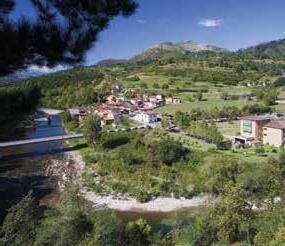
A selection of the most iconic cheeses from Asturias, guided by the expert Lluis Nel, and paired with local ciders. Gastronomy and tradition on a journey through the roots of this region.
LAS MÉDULAS A CABALLO
Ruta a caballo por Las Médulas para recorrer senderos históricos y descubrir el impacto humano en este paisaje Patrimonio de la Humanidad, con vistas únicas a las antiguas minas romanas y una conexión profunda con la naturaleza.
LAS MÉDULAS ON HORSEBACK
Horseback route through Las Médulas to explore historical trails and discover the human impact on this UNESCO World Heritage landscape, with unique views of the ancient Roman mines and a deep connection with nature.
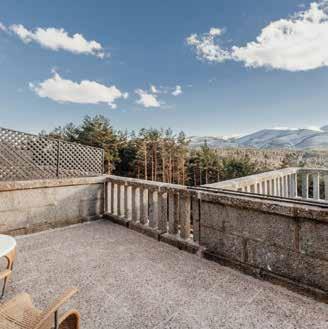
CANOAS EN LA RÍA
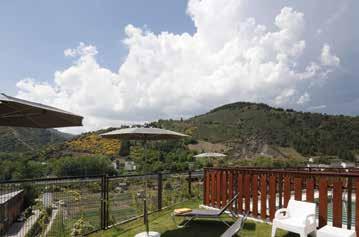
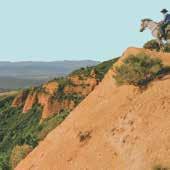
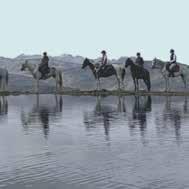
Ruta a caballo a través un entorno natural de pinares, praderas y ríos, en una experiencia cargada de historia, sensaciones y paisaje.
HORSESHOES AT A TROT
Horseback route through a natural environment of pine forests, meadows, and rivers, in an experience filled with history, sensations, and landscapes.

Paseo en canoa por la ría de Limpias para descubrir sus canales, el molino de mareas, el carrizo y la biodiversidad de aves del parque natural desde una perspectiva tranquila y cercana.
MONTE BUCIERO DESDE AGUA
Navegación por el entorno del monte Buciero para descubrir su riqueza cultural, geológica y natural dentro del Parque Natural.
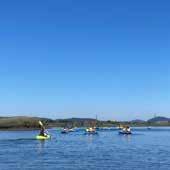
A canoe ride through the Limpias estuary to discover its channels, tidal mill, reeds, and bird biodiversity in the natural park from a peaceful and close perspective.
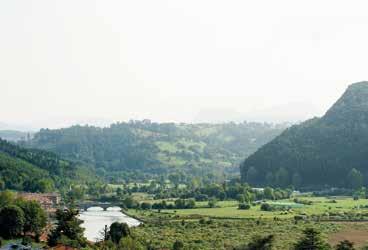
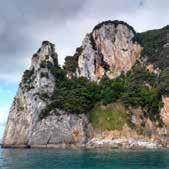
MONTE BUCIERO FROM THE WATER
Navigation in the surroundings of Monte Buciero to discover its cultural, geological, and natural richness within the Natural Park.
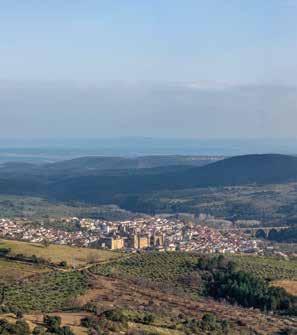

VIAJE AL CENTRO DEL GEOPARQUE
Visita a las minas Costanaza para explorar rocas de más de 600 millones de años, conocer el filón de fosforita utilizado en fertilizantes europeos y recorrer sus galerías y museo.
JOURNEY TO THE CENTRE OF THE GEOPARK
Visit to the Costanaza mines to explore rocks over 600 million years old, learn about the phosphorite vein used in European fertilizers, and tour its galleries and museum.
PARADOR DE FUENTE DÉ
EXPERIENCIA LANERA
Encuentro con una pastora del valle de Pesaguero para conocer la ganadería extensiva y su papel en la biodiversidad, aprender sobre el cuidado del rebaño y la preparación y limpieza de la lana, y finalizar con una degustación de quesos, pan y vino local.
RECONEXIÓN
Aventura entre senderismo y escalada en Liébana, recorriendo una vía ferrata segura y accesible para todos los niveles, que permite disfrutar del paisaje y fortalecer la conexión con la naturaleza.
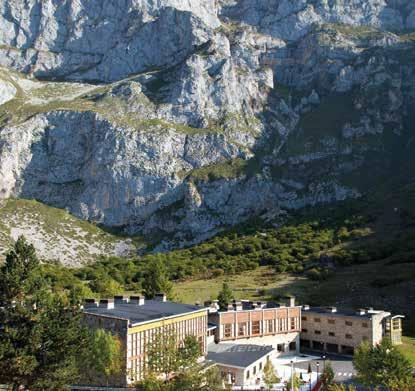
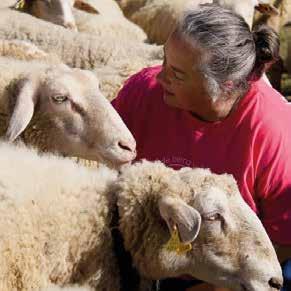
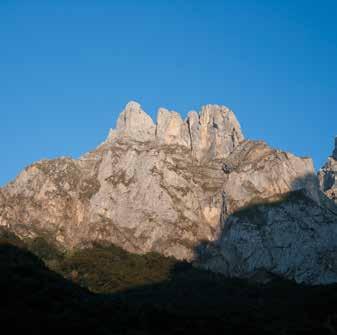
A meeting with a shepherdess from the Pesaguero valley to learn about extensive livestock farming and its role in biodiversity, the care of the flock, and the preparation and cleaning of wool, ending with a tasting of local cheese, bread, and wine.
Adventure between hiking and climbing in Liébana, following a safe and accessible iron path for all levels, which allows you to enjoy the landscape and strengthen the connection with nature.
UNDER THE INFINITE CANOPY UNDER THE INFINITE CANOPY
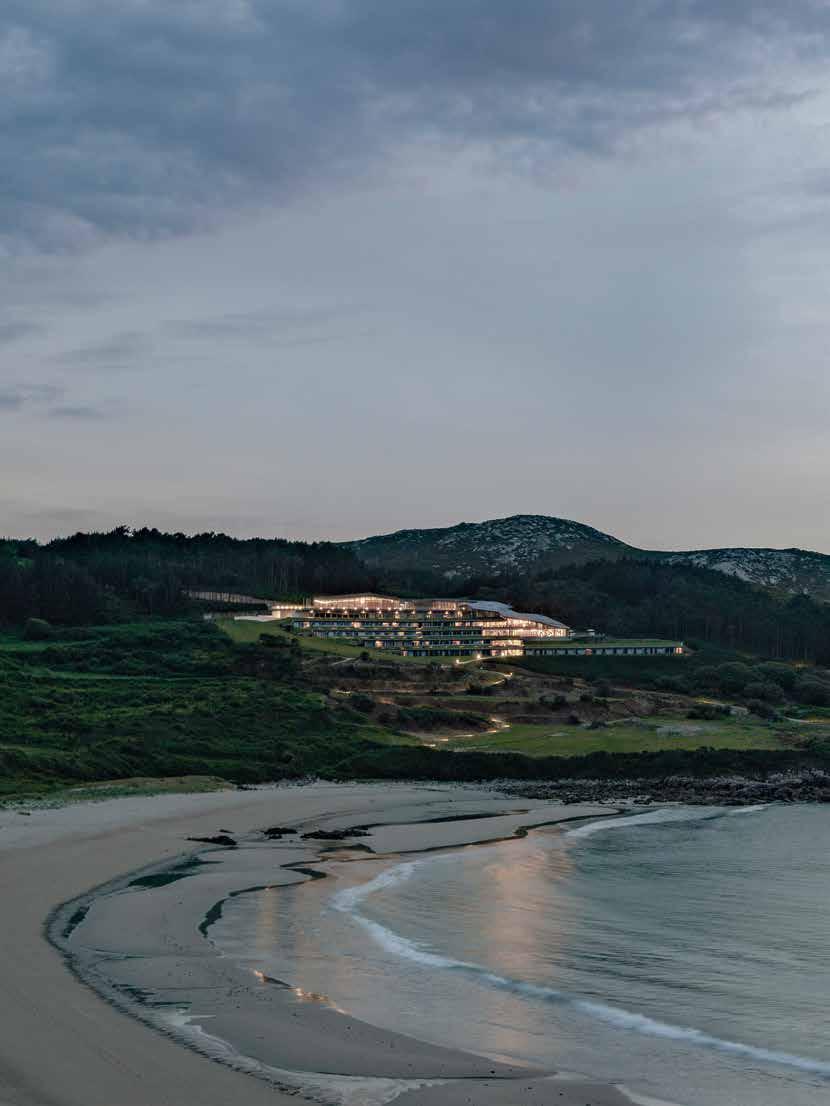
LA EXPERIENCIA STARLIGHT DE PARADORES
DESIRÉ ALIJA
La Fundación Starlight es una entidad sin ánimo de lucro creada en 2009 por el Instituto de Astrofísica de Canarias y Corporación 5. Su misión es difundir la astronomía y coordinar el movimiento internacional Starlight, impulsando la protección del cielo nocturno como patrimonio científico, cultural, natural y turístico. Nacida a partir de la Declaración de La Palma (2007), firmada por organismos como la UNESCO, ONU Turismo y la Unión Astronómica Internacional entre otras, la Fundación lidera acciones en cuatro ámbitos clave: la lucha contra la contaminación lumínica y el fomento de una iluminación eficiente; la divulgación cultural de la astronomía mediante formación, actividades y festivales; el impulso del astroturismo sostenible a través de certificaciones reconocidas a nivel internacional y formación especializada; y la promoción del ahorro energético en armonía con la protección de la biodiversidad nocturna.
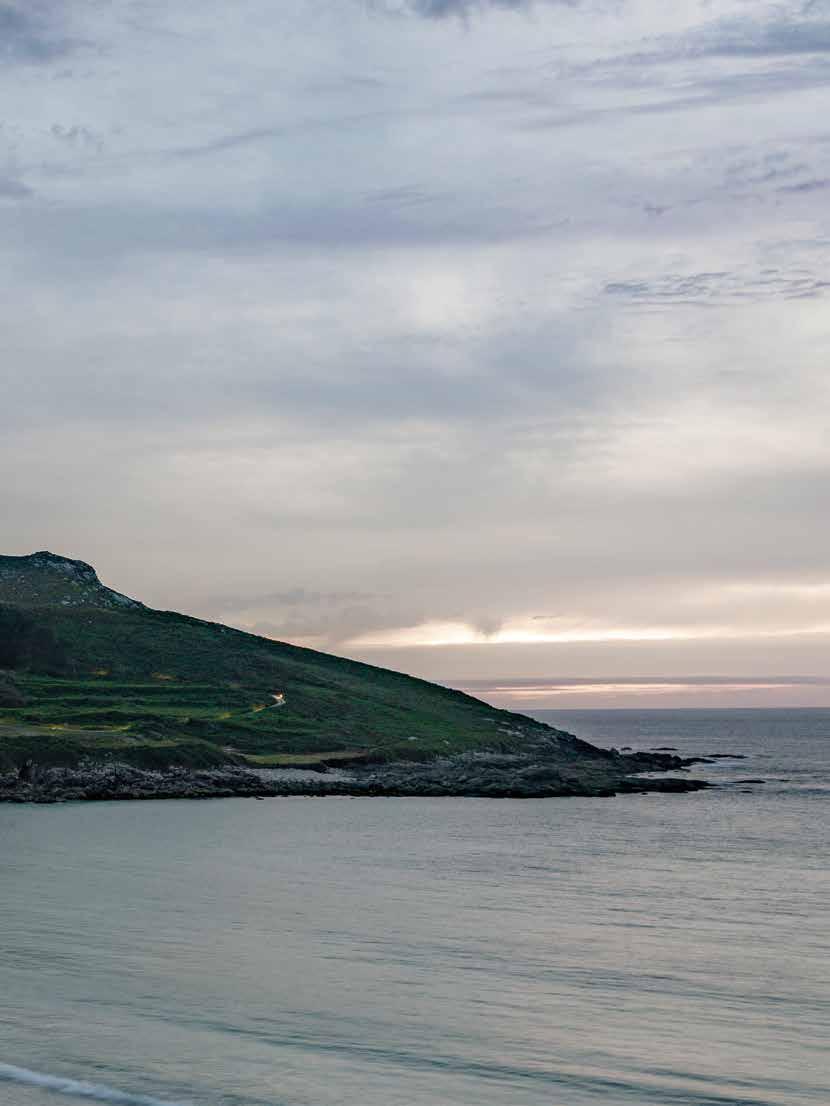
Noche serena. El cuerpo reposa sobre una hamaca, entregado al silencio noble de la naturaleza. Cielo infinito. Inabarcable y generoso, se despliega en lo alto, salpicado de astros. La escena, que parece brotar de un sueño, se torna realidad en los Paradores Starlight, donde el firmamento es mucho más que un telón de fondo: es el alma misma de la experiencia.
A still night. The body rests on a hammock, surrendered to the noble silence of nature. An infinite sky. Vast and generous, it unfolds above, scattered with stars. A scene that could belong to a dream becomes reality at the Starlight Paradores, where the night sky is far more than a backdrop: it's the very soul of the experience.
Desde las cumbres de Gredos hasta Vielha, pasando por Segovia, El Teide, Tejeda, Sigüenza o Molina de Aragón,son muchos los enclaves que han sido reconocidos por la Fundación Starlight como Destinos Turísticos Starlight. Esta distinción garantiza una calidad excepcional del cielo nocturno, libre de contaminación lumínica, y refleja un firme compromiso con la sostenibilidad, la protección del paisaje celeste y la divulgación científica.
Más allá de la belleza visual, esta certificación ratifica la implicación de Paradores en la divulgación científica y la conservación del medioambiente. Aquí, donde el asombro se entrelaza con la razón, la observación de las estrellas se convierte en una puerta hacia el conocimiento.
Durante todo 2025, los Paradores Starlight han cerrado un calendario cargado de experiencias. En caso de que las condiciones meteorológicas no permitan la observación directa, ofrecen alternativas en el interior de los Paradores, mediante simulaciones digitales del cielo nocturno y talleres astronómicos adaptados. A través de diferentes actividades, cuidadosamente diseñadas por el equipo de Paradores, jóvenes y adultos pueden acercarse al universo de manera pedagógica, inmersiva y profundamente estimulante. Las reservas pueden realizarse mediante web, teléfono, aplicación oficial, agencias de viaje o en los propios Paradores.
Los Paradores de Gredos y Las Cañadas, pioneros en esta propuesta, ofrecen un pack especial de astroturismo que incluye una velada nocturna guiada por monitores certificados en astroturismo. Gracias a telescopios profesionales y herramientas digitales de vanguardia, es posible observar cúmulos estelares, nebulosas, galaxias y otros cuerpos celestes.
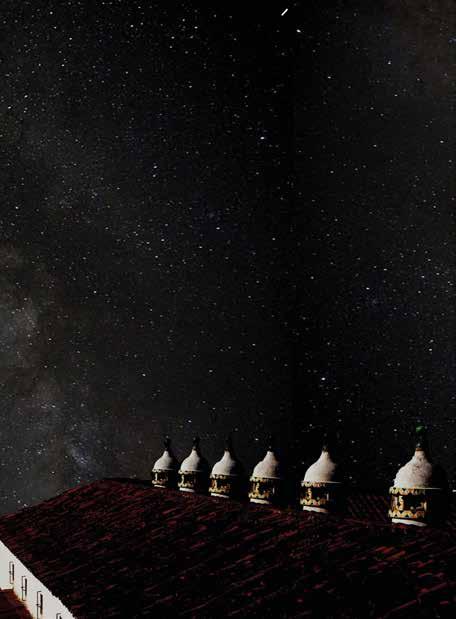
En los Paradores de Cruz de Tejeda, La Granja, Segovia, Sigüenza y Vielha, esta experiencia también puede disfrutarse previa reserva, adaptándose a las particularidades de cada emplazamiento.
En tiempos de prisas y pantallas, levantar la vista puede convertirse en un acto revelador. Y hacerlo desde un Parador es, sin duda, una de las formas más hermosas de recordar que el ser humano está hecho de polvo de estrellas.
Los meses estivales convierten el cielo español en un escenario privilegiado para los amantes del firmamento. En julio, hacen su aparición las Delta Acuáridas, una lluvia de meteoros sutil y veloz que cruza la atmósfera como un susurro de luz. Pero es en agosto cuando el cielo se enciende con las Perseidas, conocidas también como lágrimas de San Lorenzo, cuya intensidad y frecuencia las convierten en una de las lluvias de estrellas más admiradas del calendario celeste.
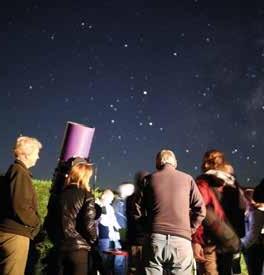
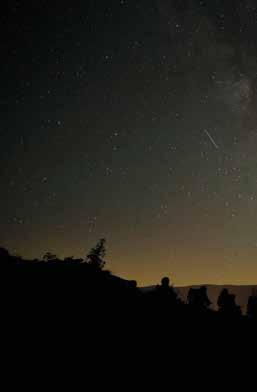
The Starlight Foundation is a nonprofit entity created in 2009 by the Institute of Astrophysics of the Canary Islands and Corporación 5. Its mission is to promote astronomy and coordinate the international Starlight movement, advocating for the protection of the night sky as scientific, cultural, natural, and tourist heritage. Born from the Declaration signed in La Palma (2007), endorsed by organizations such as UNESCO, UN Tourism, and the International Astronomical Union, the Foundation leads initiatives in four key areas: the fight against light pollution and the promotion of efficient lighting systems; cultural outreach of astronomy through education, events, and festivals; sustainable astrotourism, with internationally recognized certifications and specialized training, and energy conservation in harmony with the protection of nocturnal biodiversity.
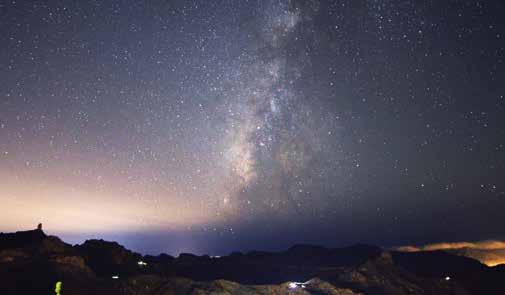
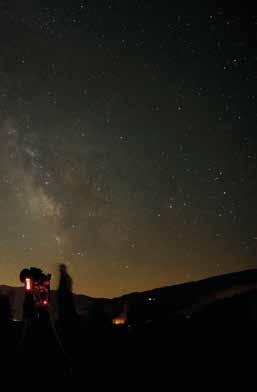
From the peaks of Gredos to Vielha, Segovia, El Teide, Tejeda, Sigüenza or Molina de Aragón, a lot of locations have been recognized by the Starlight Foundation as Starlight Tourist Destinations. This distinction guarantees exceptional night skies, free from light pollution, and affirms a strong commitment to sustainability, to the protection of the celestial landscape and to scientific dissemination.
Beyond visual beauty, the certification reflects Paradores’ deep involvement in scientific outreach and environmental conservation. Here, where wonder intertwines with reason, stargazing becomes a gateway to knowledge.
The Starlight Paradores have prepared a calendar full of experiences, and the summer season is one of the best times to enjoy them. Through a variety of carefully designed activities, both youngsters and adults are
invited to explore the universe in a way that is educational, immersive, and profoundly inspiring.
The Parador of Gredos and the Parador of Las Cañadas, pioneers in this initiative, offer a special astrotourism package that includes a stargazing evening guided by certified astrotourism instructors. Thanks to professional telescopes and cutting-edge digital tools, guests can observe star clusters, nebulae, galaxies, and other celestial bodies.
This experience is also available by prior booking at the Paradores of Cruz de Tejeda, La Granja, Segovia, Sigüenza, and Vielha, each adapted to the unique characteristics of its location.
In times of rush and screens, looking up can become a revealing act. And doing so from a Parador is undoubtedly one of the most beautiful ways to remember that human beings are made of stardust.
The summer months turn the Spanish sky into a privileged stage for lovers of the stars.
In July, the Delta Aquariids make their appearance, a subtle, swift meteor shower that streaks across the atmosphere like a whisper of light. But it is in August that the sky truly lights up with the Perseids, also known as the Tears of Saint Lawrence, whose brilliance and frequency make them one of the most admired meteor showers of the celestial calendar.
En cada luna nueva. Una noche de oscuridad perfecta para la observación profunda del firmamento. Ideal para ver galaxias, cúmulos estelares y la Vía Láctea en todo su esplendor. 29-30 de julio, máximo de las Delta Acuáridas. Lluvia de meteoros de trazo suave y constante. Mejores vistas tras la medianoche, en lugares alejados de fuentes de luz artificial. 12-13 de agosto, pico de las Perseidas. El fenómeno más esperado del verano: hasta cien meteoros por hora cruzan el cielo. En 2025, la Luna nueva garantiza una noche propicia para su observación sin interferencias.
7 de septiembre, eclipse total de Luna. Espectáculo astronómico de gran belleza. La Luna se teñirá de rojo durante la totalidad del eclipse, visible desde muchos puntos del país.
8 de octubre, máximo de las Dracónidas. Visible justo después del anochecer, la actividad suele ser baja (10–20 meteoros/h), pero es conocida por estallidos súbitos que han superado los 600 meteoros por hora. Ideal para observación en el primer tramo de la noche 20–21 de octubre, pico de la lluvia de meteoros Oriónidas. Provienen del cometa Halley y muestran una actividad moderada (≈20 meteoros/h), con trazos veloces y brillantes, a menudo con estelas persistentes.
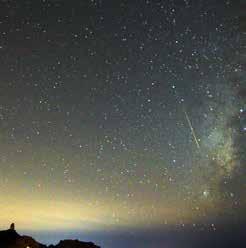

At every new moon. A night of perfect darkness for deep-sky observation. Ideal for spotting galaxies, star clusters, and the Milky Way in all its splendour.
July 29-30, peak of the Delta Aquariids. A meteor shower with soft, steady streaks of light. Best viewed after midnight, far from artificial light sources.
August 12–13, peak of the Perseids. The most anticipated event of the summer: up to 100 meteors per hour streak across the sky. In 2025, the new moon ensures optimal viewing without interference.
13–14 de diciembre, pico de la lluvia de meteoros Gemínidas. La lluvia más intensa del año, con tasas que superan los 100 meteoros/h en cielos oscuros.
20 de diciembre, luna nueva y cielos de invierno. Las noches más largas y claras del año permiten observar constelaciones invernales como Orión, Tauro o Géminis con total nitidez.
PARADORES CON EXPERIENCIAS STARTLIGHT
Las Cañadas • Cruz de Tejeda • Gredos • La Granja • Molina de Aragón • Segovia • Sigüenza • Vielha
September 7, total lunar eclipse. A breathtaking astronomical spectacle. The Moon will take on a reddish hue during the eclipse's total phase, visible from many parts of the country.
October 8, peak of the Draconids. Visible just after nightfall, activity is usually low (10–20 meteors/hour) but known for sudden outbursts that have exceeded 600 meteors per hour. Best viewed in the early evening.
October 20–21, peak of the Orionids Originating from Halley’s Comet, these meteors show moderate activity (≈20/hour), with fast, bright streaks and occasional persistent trails.
December 13–14, peak of the Geminids. The most intense meteor shower of the year, with rates exceeding 100 meteors per hour under dark skies.
December 20, New Moon and Winter Skies. The longest, clearest nights of the year are perfect for observing winter constellations like Orion, Taurus, and Gemini in stunning detail.
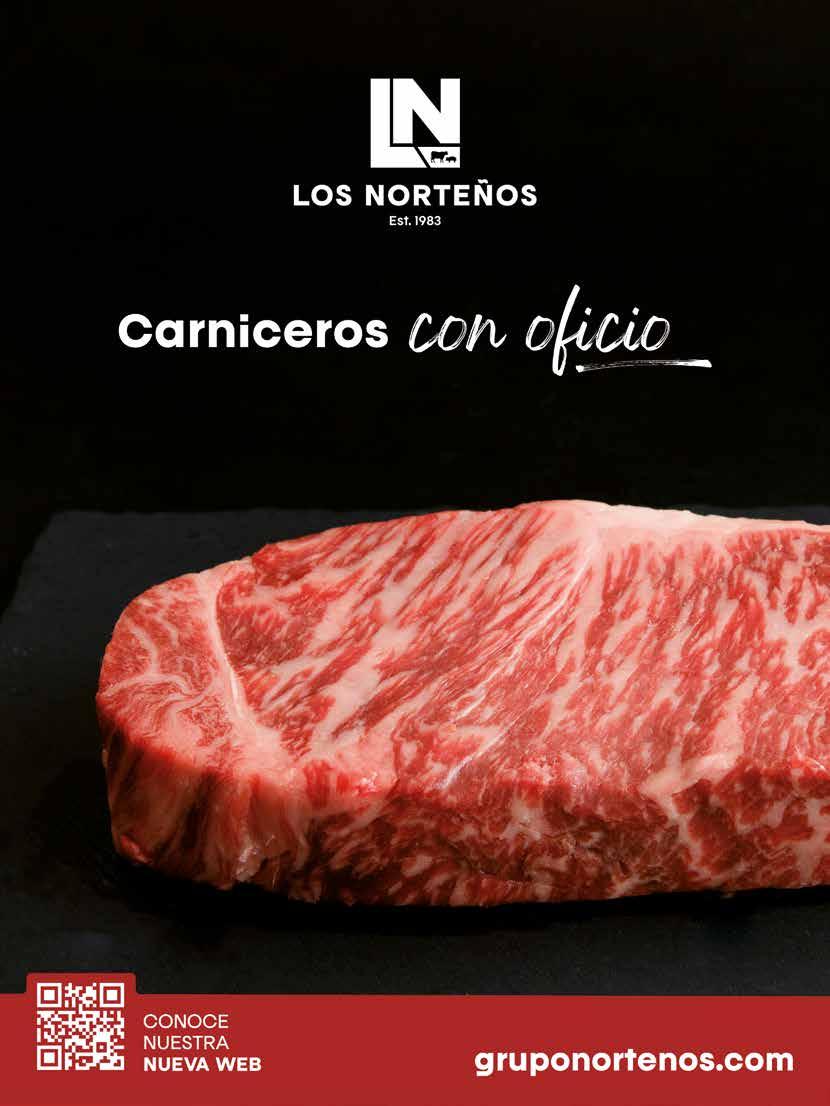
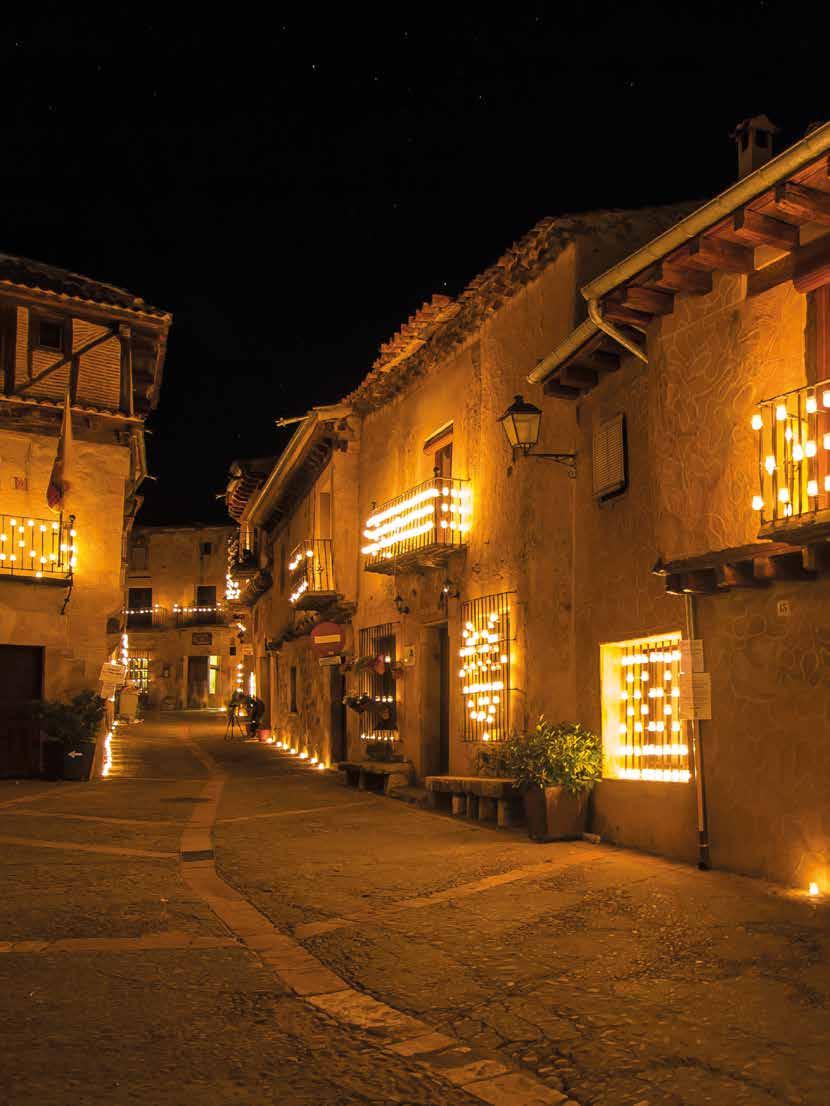
Cae la noche y las farolas se apagan. Intimidad, misterio, celebración y recuerdo. La oscuridad se viste con brillos tenues que susurran silencio, pero también promesa. Piedras centenarias se dejan acariciar por el resplandor titilante de la cera quemada. Son pueblos que exhiben una penumbra amable. Visitantes que se entregan al sueño de otra época.
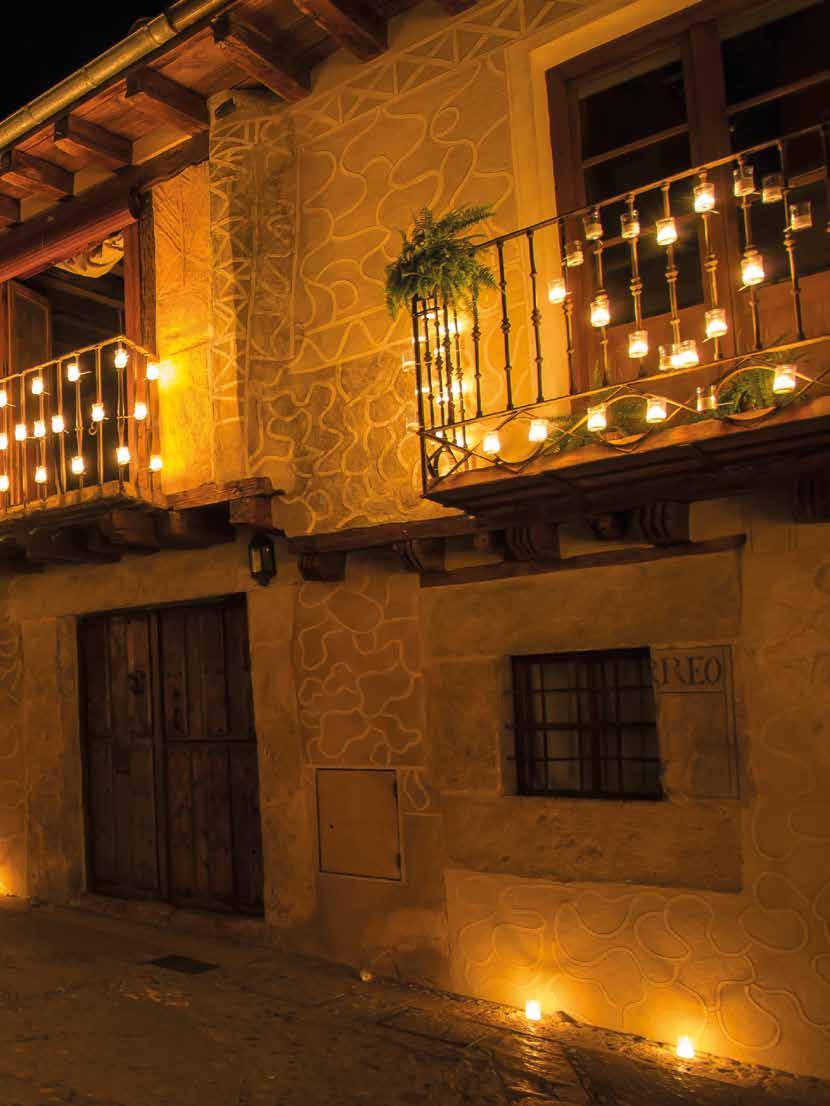
ANA FERNÁNDEZ
Night falls, and the streetlights fade out. Intimacy, mystery, celebration, and memory. The darkness is dressed in soft glimmers that whisper silence but also promise. Centuries-old stones are gently caressed by the flickering glow of burning wax. They are towns that display a kind, welcoming gloom. Visitors are carried away by the dream of another time.
A pocos minutos de los Paradores de Segovia y La Granja se alza Pedraza, reducto amurallado que alberga en su interior un viaje al pasado. Calles sinuosas y empedradas recrean un entorno de película que, desde 1993, se torna mágico los dos primeros sábados de julio. Cada rincón se adorna con pequeñas candelas para acoger los Conciertos de las Velas. Artistas nacionales e internacionales ocupan la explanada del Castillo para deleitar a los visitantes con una experiencia musical única. Clásico, coral e incluso flamenco tienen cabida en este ritual que la Fundación Villa de Pedraza organiza con mimo para continuar la tradición que, en 1996, quedó impresa en el Guinness de los récords, tras encen der 25 000 mechas para iluminar el pueblo.
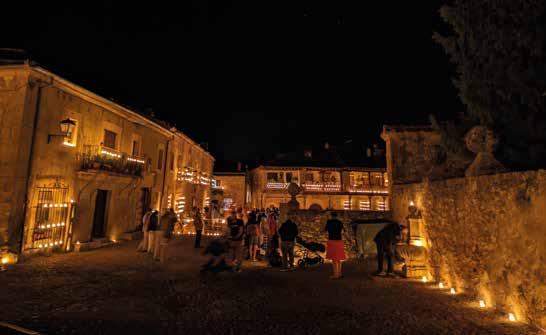
De norte a sur, la Noche de las Velas transforma Mojácar en un pueblo de leyenda. Más de 6000 velas decoran calles, fuentes, balcones y plazas en una noche estival que evoca romanticismo por los cuatro costados. El casco antiguo se transforma en un laberinto encantado con acordes de violines, guitarras flamencas y voces que lo llenan todo. Hay espectáculos de danza, narradores de cuentos y actuaciones musicales que invitan a recorrer cada rincón. El evento, previsto para el 20 de septiembre, puede disfrutarse desde el Parador de Mojácar. Su imponente vista al Mediterráneo hipnotiza y eleva la magia nocturna.

Just a few minutes from the Paradores of Segovia and La Granja stands Pedraza, a walled stronghold that offers a journey back in time. Winding, cobblestone streets recreate a cinematic atmosphere that, since 1993, becomes magical on the first two Saturdays of July. Every corner is adorned with small candles to welcome the Candlelight Concerts. National and international artists take to the esplanade of the Castle to delight visitors with a unique musical experience. Classical, choral, and even flamenco music are part of this ritual, organised with great care by the Fundación Villa de Pedraza to continue the tradition that, in 1996, was recorded in the Guinness World Records after lighting 25,000 wicks to illuminate the village.
En Guaro (Málaga), el fuego es raíz y origen. El Festival de la Luna Mora homenajea tiempos de convivencia entre cristianos, musulmanes y judíos. Miles de candelas transformarán este 12 y 13 de septiembre la localidad en un hervidero cultural casi de cuento. La música andalusí, sefardí y flamenca se mezcla con el bullicio de un zoco morisco que completa la experiencia. El descanso se abre paso entre el Parador de Málaga Gibralfaro, que regala las mejores vistas de la ciudad; el Parador de Málaga Golf o el de Nerja, a los pies del Mediterráneo; el Parador de Ronda, excepcional balcón que mira al Tajo, o el de Antequera, que exhibe modernidad y magníficas panorámicas de la vega antequerana.
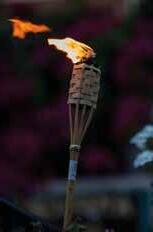
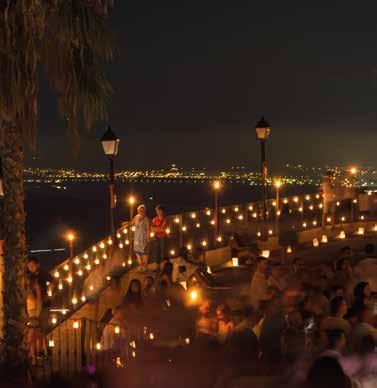
Aunque más simbólica que decorativa, la luz de las velas tiene un papel emocional y ceremonial en Elche (Alicante) . El 13 de agosto, durante la Nit de l’Albà y en los actos del Misteri d’Elx, la ciudad se convierte en un santuario ilumina do por la fe y la tra dición. Las llamas no solo decoran. Representa la voz de generaciones que han mantenido viva una de las celebraciones más antiguas y bellas del Mediterráneo. Las calles se convierten en escenario, los balcones en altares y cada vela en un latido. El Parador más próximo se encuentra en Jávea, a cerca de 90 km. Un baño de luz y mar en la Costa Blanca hará que la distancia se quede en nada.



Although more symbolic than decorative, the light of the candles plays an emotional and ceremonial role in Elche (Alicante). On August 13th, during the Nit de l’Albà and the events of the Misteri d’Elx, the city becomes a sanctuary illuminated by faith and tradition. The flames do more than just decorate. They represent the voice of generations that have kept alive one of the oldest and most beautiful celebrations of the Mediterranean. The streets become a stage, the balconies turn into altars, and each candle is a heartbeat. The nearest Parador is in Jávea, about 90 km away. A bath of light and sea on the Costa Blanca will make the distance feel like nothing.
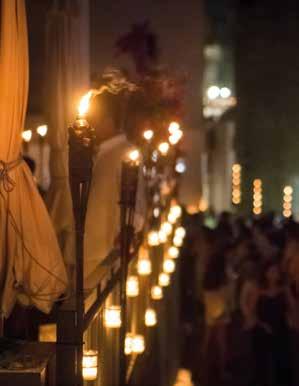
From north to south, the Night of the Candles transforms Mojácar into a village of legend. Over 6,000 candles decorate the streets, fountains, balconies, and squares on a summer night that evokes romance everywhere. The old town is transformed into an enchanted labyrinth, filled with the sounds of violins, flamenco guitars, and voices that fill the air. There are dance performances, storytellers, and musical acts that invite visitors to explore every corner. The event, scheduled for September 20th, can be enjoyed from the Parador of Mojácar. Its impressive view of the Mediterranean hypnotises and increases the nocturnal magic.
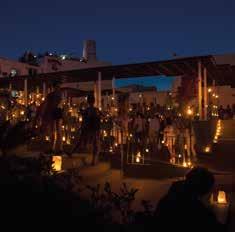
In Guaro (Málaga), fire is both root and origin. The Luna Mora Festival honours the times of coexistence between Christians, Muslims, and Jews. On September 12th and 13th, thousands of candles will transform the town into a cultural melting pot, almost like something out of a fairytale. Andalusian, Sephardic, and flamenco music blend with the bustling atmosphere of a Moorish souk, completing the experience. Rest can be found at the Parador of Málaga Gibralfaro, which offers the best views of the city; the Parador of Málaga Golf or the one in Nerja, at the foot of the Mediterranean; the Parador of Ronda, an exceptional balcony overlooking the gorge; or the Parador of Antequera, showcasing modernity and magnificent panoramic views of the Antequera plains.
Y para quienes ya sueñan con más noches encendidas para 2026, hay celebraciones que conviene tener en el radar. En Utiel (Valencia), la festividad 250 Años a la Luz de las Velas inunda cada mes de junio sus calles con miles de llamas titilantes en recuerdo de una antigua plegaria campesina. El aroma a cera derretida acompaña un programa vibrante de música, teatro, magia y gastronomía. Más al sur, en Vejer de la Frontera (Cádiz), las murallas blancas se visten cada primavera con más de 18 000 velas. La música –flamenco en vivo, cuerdas clásicas, coros que brotan desde los patios– transforma el paseo en una experiencia íntima y sensorial, un homenaje a la noche y a la belleza sin prisas. Son fiestas breves, pero intensas, que iluminan el alma del visitante y dejan una huella que invita a volver… quizás el año que viene.

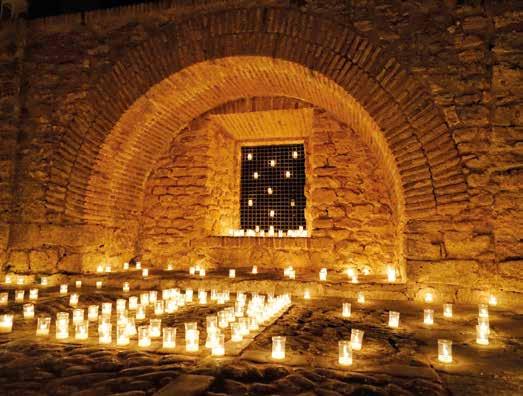
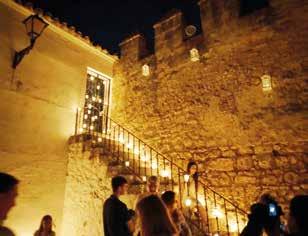
For those already dreaming of more candlelit nights in 2026, there are celebrations worth keeping on the radar. In Utiel (Valencia), the festival 250 Years of Candlelight fills its streets every June with thousands of flickering flames in memory of an ancient rural prayer. The scent of melted wax accompanies a vibrant programme of music, theatre, magic, and gastronomy. Further south, in Vejer de la Frontera (Cádiz), the white walls are adorned every spring with over 18,000 candles. The music –live flamenco, classical strings, choirs emerging from the courtyards– transforms the walk into an intimate and sensory experience, a tribute to the night and unhurried beauty. These are brief but intense festivities that light up the soul of the visitor and leave a trace that invites one to return… perhaps next year.
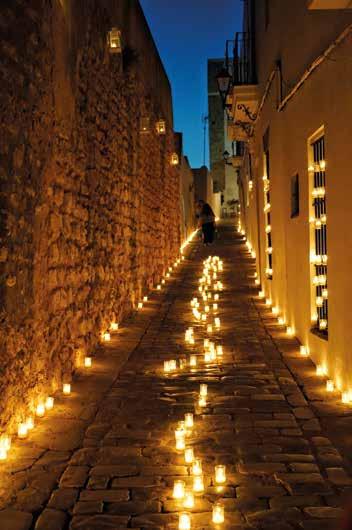
ENTRE MAR, MONTAÑAS Y MURALLA: PISTAS PARA AVIVAR EL GUSTO
BETWEEN THE SEA, MOUNTAINS, AND WALLS: TIPS TO AWAKEN THE SENSES
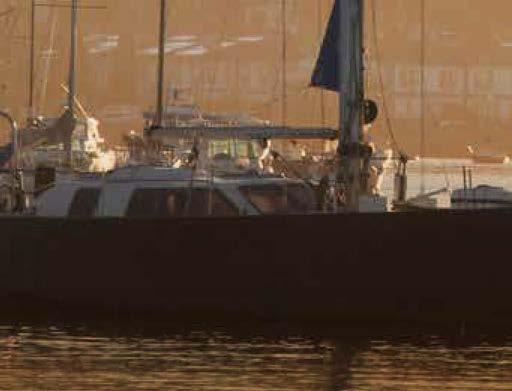
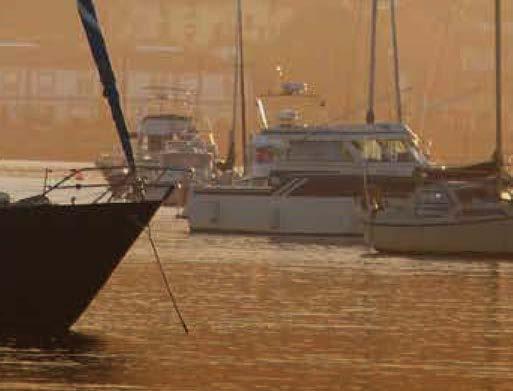
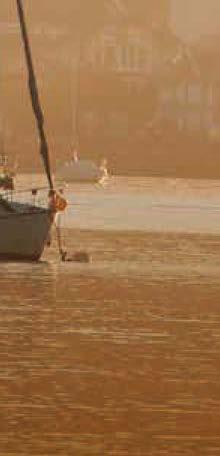
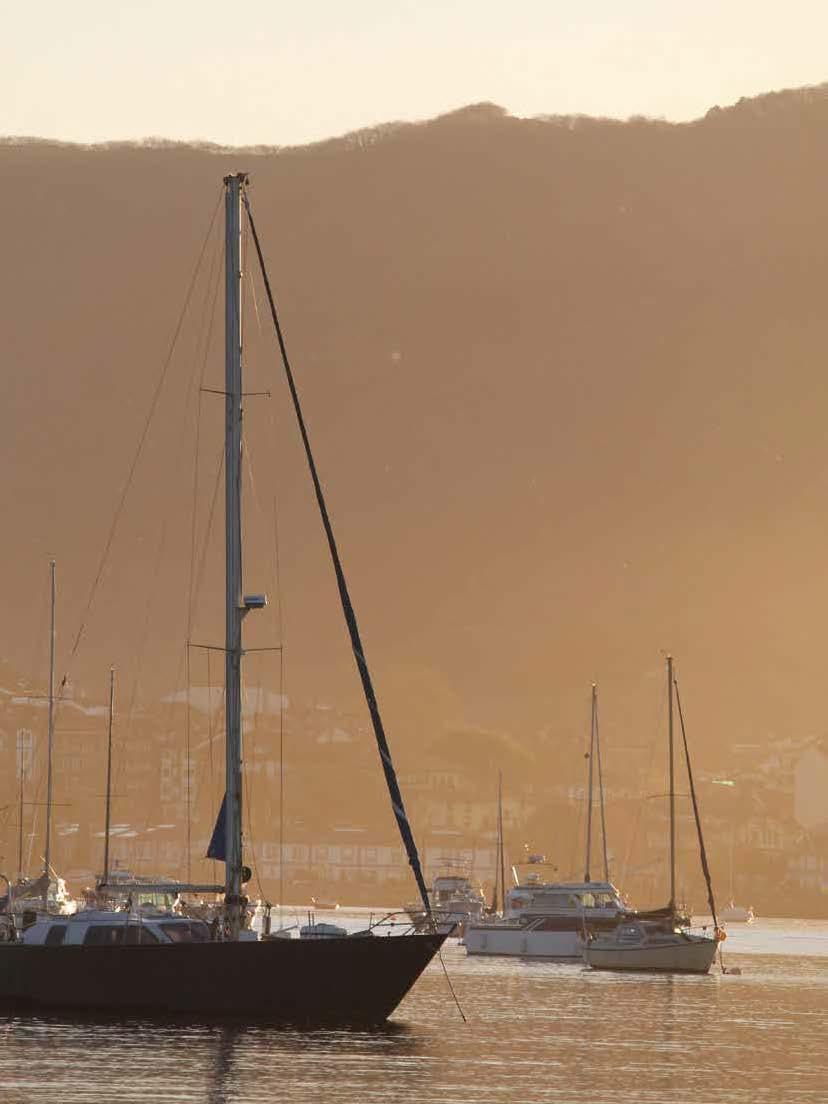
Hondarribia no exige mapa. Ni planificación milimétrica que obligue a recorrer cada punto de interés para no dejarse nada. Solo llegar y entregarse al disfrute. El bullicio de las calles indica el camino a seguir y también los tiempos. Lo mejor es pasear por su casco histórico, desde la Puerta de Santa María hasta la de San Nicolás.
La calle Mayor, su trazado medieval, la muralla y el barrio de la Marina, con sus coloridas casas con balcones, despiertan todos los sentidos. Sobre todo, el gusto.
Hondarribia doesn’t require a map. Nor does it demand meticulous planning to ensure every point of interest is visited. Just arrive and surrender to the enjoyment. The bustling streets indicate the way to go and also set the pace. The best thing is to stroll through the historic centre, from the Santa María gate to the San Nicolás one. The main street, its medieval layout, the wall, and the Marina quarter with its colourful houses and balconies awaken all the senses. Especially, the taste.
La brisa temprana que nace del Cantábrico concede a las mañanas estivales un clima perfecto para despertar los sentidos. Al cruzar la puerta de Santa María, la villa acoge al visitante con la humildad y serenidad propia de sus gentes. Un café es el mejor aliciente antes de enfilar Nagusia Kalea, la calle mayor, que enseña un breve reco rrido de lo que la ciudad encierra: tradición, cultura e historia.
Balconadas características de la arquitectura norteña y calles de piedra que exhiben la humedad refrescante en las primeras horas guiarán el camino hacia la iglesia de Santa María de la Asunción y del Manzano, templo que homenajea a su pa trona y se funde entre restos de la muralla.

Ya en la Plaza de Armas, el Castillo de Carlos V –hoy convertido en Parador–muestra el carácter defensivo y estratégico que siempre ha caracterizado a la villa. Una construcción del siglo X destinada a la defensa militar sobre el río Bidasoa, que explica los gruesos muros y la altura del edificio, donde se alojaron el emperador Carlos V, Felipe IV y V, y hasta el mismísimo Velázquez. Su interior guarda tesoros como los tapices diseñados por Rubens con el tema de la Historia de Aquiles.

The early breeze coming from the Cantabrian Sea grants the summer mornings a perfect climate to awaken the senses. After crossing the Santa María gate, the town welcomes visitors with the humility and serenity typical of its people. A coffee is the best incentive before heading down Nagusia Kalea, the main street, which offers a brief journey through what the town holds: tradition, culture, and history.
Representative northern architectural balconies and stone streets that display the refreshing humidity in the early hours will guide the way to the Church of Santa
María de la Asunción y del Manzano, a temple that honours its patron saint and blends with remnants of the town’s wall.
Once in the Plaza de Armas, the Castle of Charles V –now a Parador– shows the defensive and strategic character that has always defined the town. It is a 10th-century construction designed for military defence over the Bidasoa River, which explains the thick walls and height of the building, where Emperor Charles V, Kings Philip IV and V, and even the painter Velázquez stayed. Its interior houses treasures such as the tapestries designed by Rubens on the theme of the History of Achilles.
A mediodía, el sol gana fuerza y aviva el gozo. La Plaza de Guipuzkoa, uno de los enclaves más bellos de la ciudad, es parada obligada. Imprescindible es asomarse a la puerta de San Nicolás, entrada histórica de la villa, con pasarela rehabilitada que salva el desnivel del antiguo foso. Los pasos descienden hacia el barrio de La Marina. No es casual. El cambio de luz, el bullicio creciente y el inconfundible olor a plancha caliente impregna el aire al caer el día. La zona baja de Hondarribia, histórico barrio de los
arrantzales, muestra otra cara de la identidad guipuzcoana. Tradicionales casas de colores dibujan un paisaje único. Tras ellas, dormitan historias de marineros, balleneros y pescadores de leyenda. Huele a mar y a relatos de buen gusto. Basta recorrer San Pedro Kalea para hallar los mejores productos de la villa en forma de pintxos o elaboraciones tradicionales entre un ambiente que nunca defrauda. Y no hay comida sin un buen caldo. La ciudad presume de su hondarribi zuri, variedad de uva autóc tona con la que preparan su famoso txakolí. Hay que probarlo.
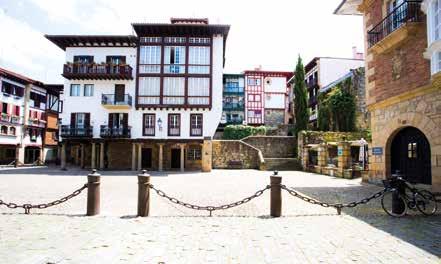
La ciudad susurra e invita al descanso. Hondarribia significa «vado de arena». Un arenal de casi setecientos metros se extiende en la Bahía de Txingudi, donde el Bidasoa se entrega al Cantábrico. Desde la costa se contempla Francia. Buena invitación para descubrir Hendaya o cualquiera de las bondades del País Vasco francés.
The city whispers and invites to rest. Hondarribia means “sand ford.” A sandy stretch of nearly seven hundred metres extends across the Bay of Txingudi, where the Bidasoa River flows into the Cantabrian Sea. From the coast, France can be seen. A perfect invitation to discover Hendaye or any of the wonders of the French Basque Country.
At midday, the sun gains strength and enhances the joy. Plaza de Guipuzkoa, one of the most beautiful spots in the city, is a must-see place. It is essential to stop by the San Nicolás gate, the historic entrance to the town, with its restored walkway that bridges the gap of the old moat.
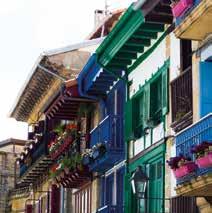
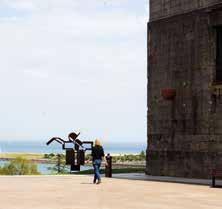
The steps lead down to the La Marina quarter. It’s no coincidence. The changing light, the growing bustle, and the unmistakable smell of sizzling grills fill the air as the day falls. The lower part of Hondarribia, the historic neighbourhood of the arrantzales, shows the other side of the Guipuzcoan identity. Traditional colourful houses sketch a unique landscape. Behind them, stories of sailors, whalers, and legendary fishermen slumber. It smells of the sea and tales of good taste. A stroll along San Pedro Kalea is enough to discover the best products of the town, in the form of pintxos or traditional dishes, all set in an atmosphere that never disappoints. And there is no meal without a good wine. The town proudly boasts its hondarribi zuri, a native grape variety used to make its famous txakolí. Another must-try.
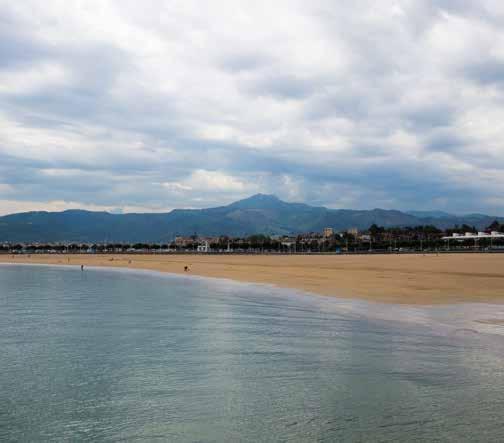
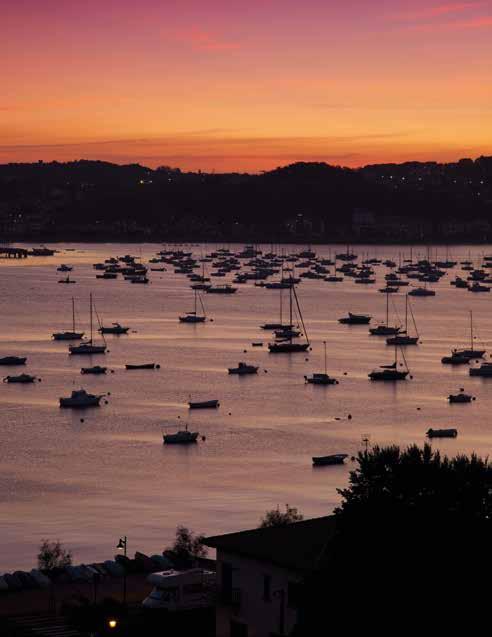
Paseando por la bahía y atravesando el puerto pesquero, se alcanza el Faro de Higer. Desde allí se entiende todo: por algo ostenta el título de ser uno de los pueblos más bonitos de Guipúzcoa. Las sugerencias no cesan: en los alrededores de la ciudad, se encuentra el parque ecológico de Playaundi de Irún, el pueblo pesquero de Pasai Donibane, el Museo Chillida Leku de Hernani y la ciudad de San Sebastián. Y para los más ansiosos, no faltan en Hondarribia oportunidades para practicar paddle surf, surf, buceo, snorkel o senderismo. Demasiado para no volver.
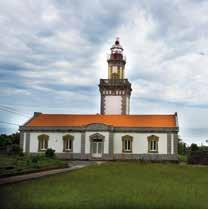
Walking along the bay and passing through the fishing port, you reach the Higer Lighthouse. From there, everything makes sense: no wonder it holds the title of one of the most beautiful towns in Guipúzcoa. The suggestions keep coming: around the town, you’ll find the Playaundi Ecological Park in Irún, the fishing village of Pasai Donibane, the Chillida Leku Museum in Hernani, and the city of San Sebastián. And for the more adventurous, Hondarribia offers plenty of opportunities to practise paddle surfing, surfing, diving, snorkelling, or hiking. Too much not to return.
Castillo de Carlos V
Plaza de Armas
Iglesia de Santa María de la Asunción
Puerto de Hondarribia
Paseo de Butrón
Playa de Hondarribia
Fuerte y Ermita de Guadalupe
Museo Romano Oiasso
Faro de Higuer
San Sebastián (21 km)
País Vasco francés:
San Juan de Luz y Biarritz (18 y30 km)
Costa Vasca: Orio (19km), Zarautz (22 km), Getaria (25km), Zumaia (30km) y Deba 36 km)
Santuario de Nuestra Señora de Aranzazu (Oñate) 95 Km.
THE MUST-SEE OF PARADORES
Castle of Charles V
Plaza de Armas
Church of Santa María de la Asunción
Port of Hondarribia
Promenade of Butrón
Hondarribia Beach
Fortress and Hermitage of Guadalupe
Oiasso Roman Museum
Higer Lighthouse
San Sebastián (21 km)
French Basque Country:
Saint-Jean-de-Luz and Biarritz (18 and 30 km)
Basque Coast: Orio (19 km), Zarautz (22 km), Getaria (25 km), Zumaia (30 km), and Deba (36 km)
Sanctuary of Our Lady of Aranzazu (Oñate) 95 km.
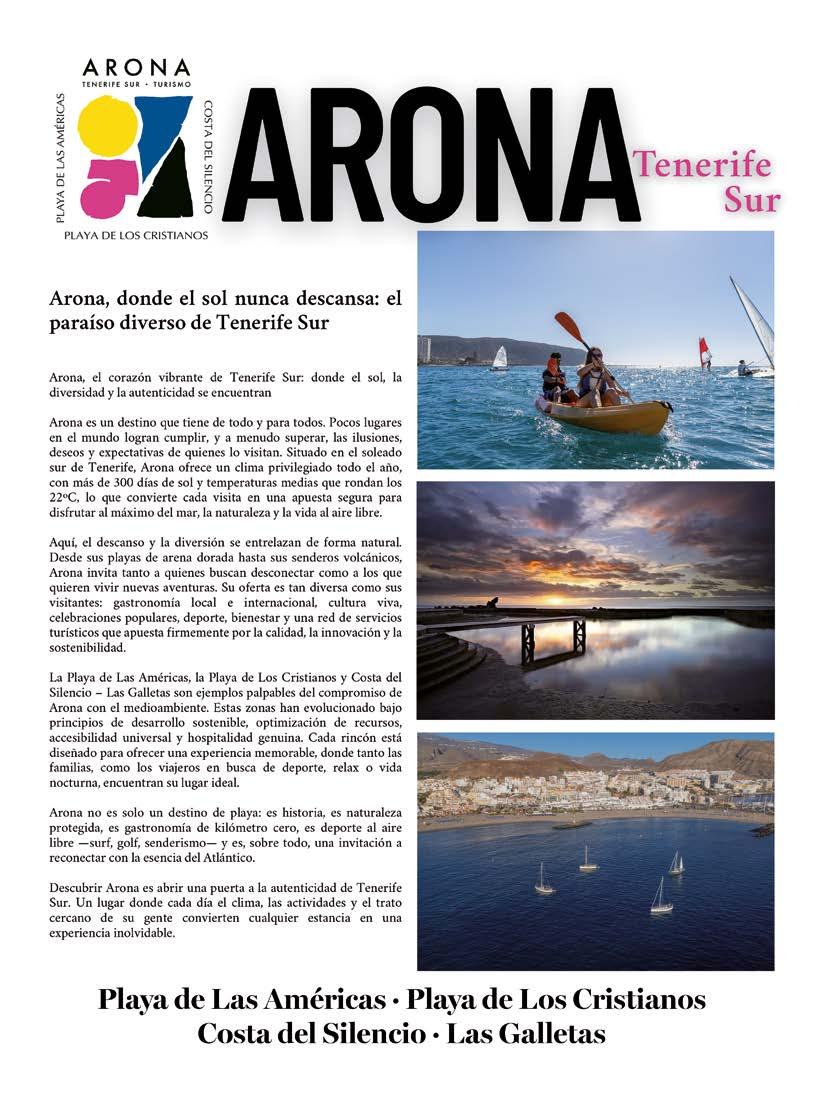
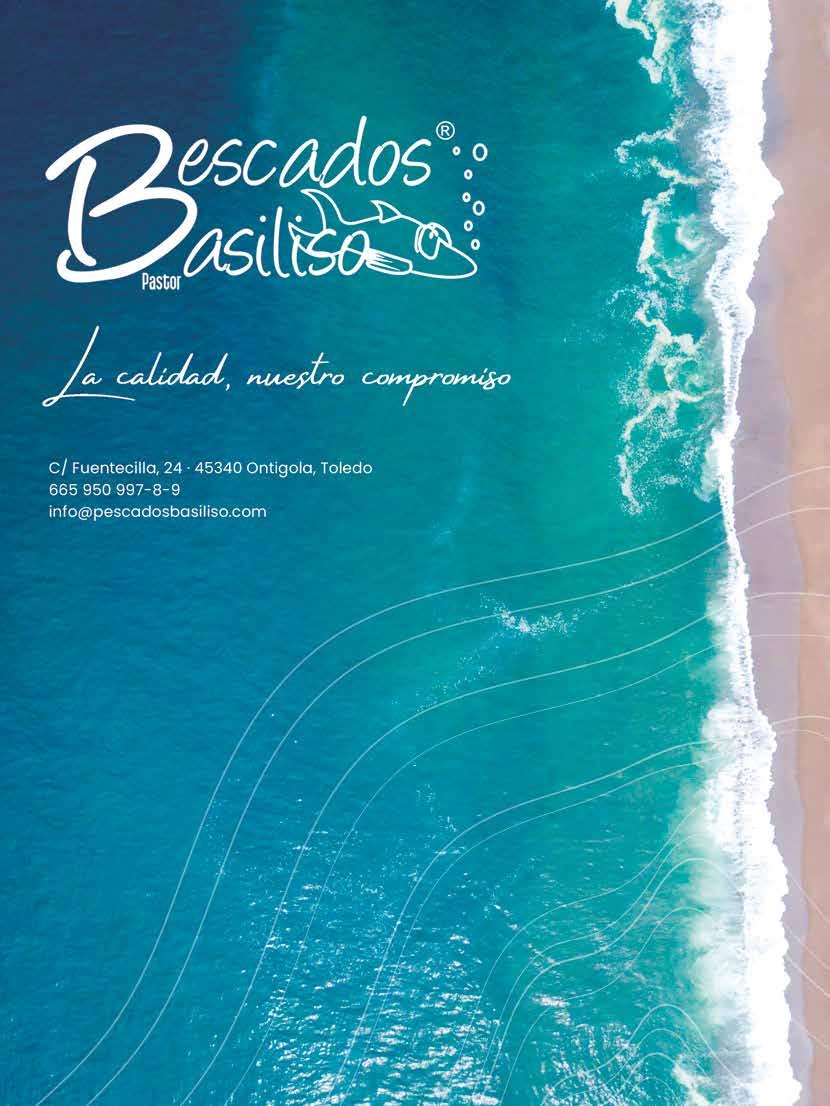


FLAVOURS WITH FRESH AIR

PARADORES PRESENTA UNA PROPUESTA RENOVADA PARA DISFRUTAR DE SU GASTRONOMÍA EN CLAVE INFORMAL LUIS TEJEDOR
PARADORES PRESENTS A RENEWED PROPOSAL TO ENJOY ITS GASTRONOMY IN A MORE CASUAL WAY


Con el verano como escenario, los Espacios Gastronómicos de Paradores actualizan su oferta para responder mejor a los gustos y ritmos del cliente actual. Son ambientes pensados para disfrutar sin rigideces, con una oferta que combina producto local, tradición y un formato más desenfadado, pero igual de cuidado.
Como complemento a sus restaurantes tradicionales, donde se imparte doctrina culinaria a cada comensal, Paradores dispone de una alternativa informal: los Espacios Gastronómicos, habilitados en cafeterías y terrazas, entre los que también se encuentran los llamados Espacios Tematizados, presentes en doce Paradores. Son ambientes recreados para momentos en los que «se prefiere ir de tapas, estar con los amigos y compartir o, simplemente, cenar algo ligero», confirma el Departamento de Restauración de Paradores.
La ubicación no debe distraer del concepto, porque va más allá del lugar que lo acoge. Por eso, «sería incorrecto llamarlos cafeterías, porque no son cafeterías al uso. Son espacios donde puedo tomar diferentes productos a lo largo del día, abiertos a una gran diversidad de propuestas», explica. A medida que avanza la jornada, la oferta se adapta a las apetencias del público para no dejar hueco sin cubrir. «Después del desayuno, puede apetecer algo a media mañana. ¿Por qué no un yogur con fruta deshidratada? O llega la hora del café y a uno se le antoja un dulce regional o una buena porción de tarta. Y, por supuesto, buenos platos para comer o para cenar».
No hay que perder de vista que España es un país de mesas animadas en las que se comparten platos y bulle la charla animada. Por eso, en Paradores estos espacios son cada vez más populares. A la gente le gusta comer de manera más informal y compartir lo que pide. «En la temporada estival, a nuestros clientes les gusta comer de manera distinta y hacerlo en el exterior», afirman. Precisamente, la llegada del estío trae consigo una evolución en la oferta de los Espacios Gastronómicos. «Queremos darle una vuelta porque tiene mucha demanda y, con ello, introducir platos que le van a dar un carácter diferente y especial a la propia carta», insisten.
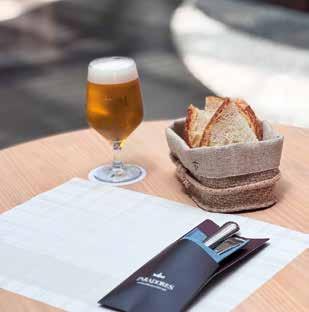
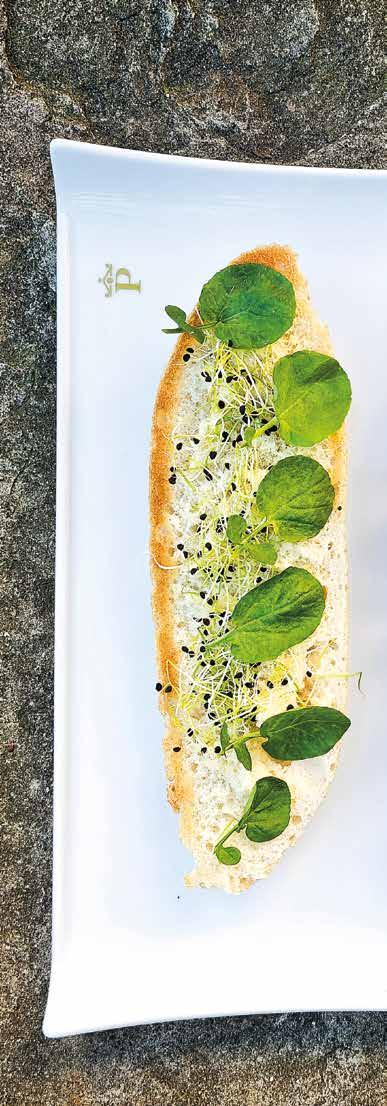
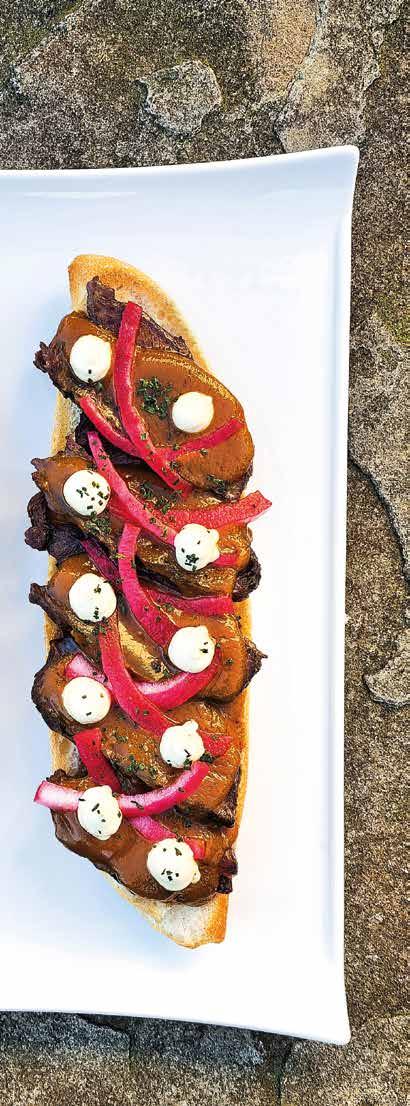
WITH SUMMER AS THE SETTING, PARADORES’ GASTRONOMIC SPACES UPDATE THEIR OFFERINGS TO BETTER RESPOND TO THE TASTES AND RHYTHMS OF TODAY’S GUESTS. THESE ARE ENVIRONMENTS DESIGNED TO BE ENJOYED WITHOUT RIGIDITY, OFFERING A SELECTION THAT COMBINES LOCAL PRODUCTS, TRADITION, AND A MORE RELAXED FORMAT, BUT JUST AS CAREFULLY PREPARED.

As a complement to its traditional restaurants, where culinary masterclasses are imparted to each diner, Paradores offers a more casual alternative: the Gastronomic Spaces, set up in cafeterias and terraces, including the socalled Themed Spaces, which are present in twelve Paradores. These are environments designed for moments when “you prefer to have tapas, be with friends and share, or simply have something light for dinner,” confirms Paradores’ Catering team.
The location should not distract from the concept, because it goes beyond the place that hosts it. For that reason, “it would be incorrect to call them cafeterias, because they are not cafeterias in the usual sense. They are spaces where you can have different products throughout the day, open to a wide variety of options,” they explain. As the day progresses, the offer adapts to the public’s cravings, leaving no gap uncovered. “After breakfast, one might feel like something mid-morning. Why not a yogurt with dried fruit? Or it’s time for coffee, and one craves a local pastry or a good slice of cake. And, of course, great dishes for lunch or dinner.”
El motivo de lanzarse a esta renovación es claro: «Satisfacer las necesidades de nuestros clientes. Contamos con una variedad de productos para llegar a todos, desde adultos a niños». Al fin y al cabo, es el modus operandi de la casa: «Nos gusta que la clientela perciba estos cambios y vea que sus preferencias son importantes para nosotros».
Fiel al espíritu que alimenta estas decisiones –adecuarse a los gustos de huéspedes y comensales–, tiempo habrá de valorar la aceptación de las nuevas propuestas. Al fin y al cabo, el cliente siempre tiene la razón.
En este planteamiento son indispensables los productos con identidad: jamón, embutidos, chacinas y quesos. Esta función la cumplen con creces los placeres más contundentes de la gastronomía hispana: jamón ibérico de bellota, embutidos locales, quesos artesanos, patés y conservas de calidad. Como contrapunto refrescante, hay una sección 100 % natural de platos frescos y ligeros que da cabida a ensaladas y cremas frías, santo remedio para los días de calor impenitente.
Dentro de este enfoque resultaba obligado incluir los viejos sabores tan del gusto de Paradores y de sus clientes. Tanto en los Espacios Gastronómicos como en los Espacios Tematizados hay elaboraciones tradicionales como las croquetas, las sartencillas o «una carne trinchada, que facilita su consumo». No podía faltar en esta relación de delicias informales los clásicos «Panes con estilo», el «fast-food» antes del fast-food. Sabido es que entre dos panes cabe casi todo, así que Paradores se ha esmerado en ofrecer la mejor compañía: productos locales de primera, hamburguesas de carne selecta o, por qué no, de guisos. Quienes no imaginaron comer pizza en Paradores se llevarán una grata sorpresa. Tal como explican, «estamos desarrollando una pizza especial de quesos regionales, muy artesana, para que puedan tenerla en todos estos espacios. Además, habrá opciones para darle un toque más local con ingredientes como el lacón en Galicia, la pata asada en Canarias o el lomo de orza en Castilla-La Mancha». Dicho esto, solo queda mudar la fe en obras y comprobar de primera mano que todo está tan bueno como se imagina.
El trabajo no estaría completo si la oferta no tuviera en cuenta a los celíacos y a quienes siguen una dieta vegetariana o vegana. Todo está previsto. En la casa aclaran que «dentro de nuestra oferta hay numerosas opciones que pueden tomar. Incluso en el apartado de hamburguesas contamos con alternativas vegetales. Evidentemente, también disponemos de productos sin gluten porque somos sensibles a estas necesidades».
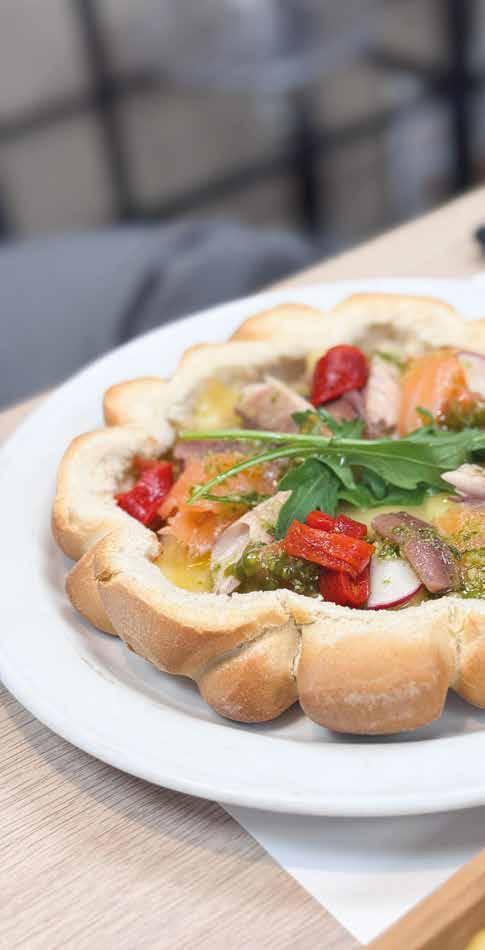
Entrepan relleno

Spain has always been a country of lively tables, where dishes are shared and animated conversations fill the air. That’s why, in Paradores, these spaces are becoming increasingly popular. People like to eat more informally and share what they order. “In the summer season, our customers like to eat differently and do so outdoors,” they affirm. Indeed, the arrival of summer brings an evolution in the offering of Gastronomic Spaces. “We want to give it a twist because there is a lot of demand, and with that, introduce dishes that will give a different and special character to the menu,” they insist.
The reason for this renewal is clear: “To meet the needs of our customers. We have a variety of products to cater to everyone, from adults to children.” After all, it’s the modus operandi of the house: “We like our customers to notice these changes and see that their preferences are important to us.”
True to the spirit that drives these decisions –adapting to the tastes of guests and diners– time will tell how well the new offerings are received. After all, the customer is always right.
The work wouldn’t be complete if the offering didn’t take into account coeliac people and those following a vegetarian or vegan diet. Everything is considered. At Paradores, they clarify that “within our offerings, there are numerous options that can be enjoyed. Even in the burger section, we have plant-based alternatives. Of course, we also offer gluten-free products because we are sensitive to these needs.”
In this approach, products with identity are essential: ham, cold meats and cheeses. This role is excellently fulfilled by the most robust pleasures of Spanish gastronomy: acornfed Iberian ham, local cured meats, artisan cheeses, pâtés, and quality preserves. As a refreshing counterpoint, there is a 100% natural section of fresh and light dishes offering salads and cold soups, the perfect remedy for the relentless summer heat.
Within this framework, it was essential to include the old flavours so beloved by Paradores and its guests. Both in the Gastronomic Spaces and in the Themed Spaces, there are traditional dishes such as croquettes, small pans, or “a carved meat that makes it easier to eat.” No informal delight list would be complete without the classic sandwich, the “fast food” before fast food. It’s well-known that almost anything can fit between two slices of bread, so Paradores has gone the extra mile to offer the best companions: premium local products, select meat hamburgers, or, why not, stews.
Those who never imagined eating pizza at Paradores will be pleasantly surprised. As they explain, “We are developing a special craft pizza made with regional cheeses so it can be available in all these spaces. Additionally, there will be options to give it a more local twist with ingredients like lacón in Galicia, roasted leg in the Canary Islands, or marinated pork loin in CastillaLa Mancha.” All that’s left is to put faith in these creations and see firsthand that everything tastes as good as it sounds.
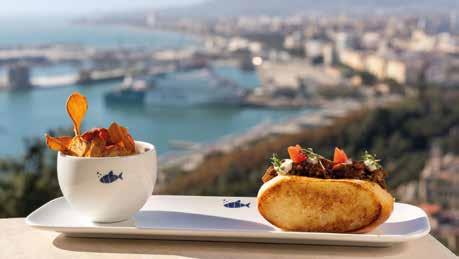
Parador de Teruel
Iván Domingo Jefe de Cocina
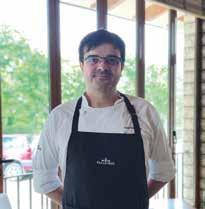
Roberto Martín Segundo

Más maño que el cierzo, el Ternasco de Aragón es uno de los clásicos de la gastronomía de esta región. Su buena fama viene de antaño porque los aragoneses han sabido sacar partido a este producto durante siglos. Como la experiencia es un grado, nadie mejor que ellos para darle el tratamiento que merece en lo culinario.
El Ternasco de Aragón fue la primera carne fresca reconocida con una Denominación Específica en 1989, y amparada por la Unión Europea como Indicación Geográfica Protegida (IGP) en el año 1996.
Las palabras no son inocentes, y ya el término ternasco aventura futuras delicias. Para confirmar que estamos ante un producto comme il faut, este corderito no debe superar los 35 días de vida ni un peso aproximado de 12 kilogramos. Solo así se garantiza su ternura y suavidad, características apreciadas desde antiguo. Todo en él es delicadeza, empezando por su sabor.
Para rendirle el homenaje que merece, esta receta mantiene la identidad tradicional del producto a través de una técnica moderna: la cocción al vacío a baja temperatura, que conserva su jugosidad. Después, la carne se prensa y se hornea para lograr un acabado crujiente y aportar textura.
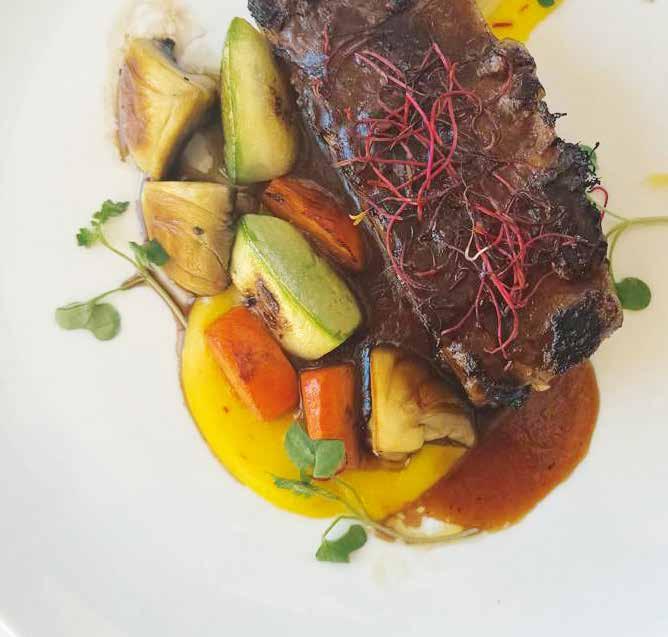
A un plato de altura como este le sienta bien un vino aragonés que no se arrugue ante su sabor: Viñas del Vero Gran Vos. Elaborado con una excelente selección de uvas tintas, es un reserva cuya elegancia se aprecia a primera vista, y un vino de guarda, por su gran capacidad de envejecimiento en botella con el paso de los años.

INGREDIENTES PARA 1 PALETILLA
Para la paletilla:
Paletilla de ternasco 1 ud
Manteca de cerdo c/s
Diente de ajo 1 ud
Laurel 1 hoja
Sal c/s
Pimienta c/s
Zanahoria 2 uds
Tomate c/s
Puerro c/s
Cebolla c/s
Agua 4 l
Vino tinto 0,5 L
Azúcar c/s
Para el cremoso de patata al azafrán
Patata 0,5 kg
Azafrán de Jiloca 1 gr
Agua 1 l
Mantequilla 50 gr
Para terminar
Zanahoria c/s
Setas c/s
Calabacín c/s
Brotes c/s
Elaboración
Deshuesar la paletilla y disponerla en una bandeja de horno honda, añadir dos cucharadas de manteca de cerdo, diente de ajo, hoja de laurel, sal y pimienta. Tapar con aluminio y cocinar a 150 ºC, durante 50 minutos. Trascurrido ese tiempo, darle la vuelta y volver a cocinar 50 minutos más
Una vez transcurrido este tiempo retirar la paletilla y reservar el jugo. En un molde disponer la piel de la paletilla en el fondo y colocar la carne desmechada sobre esta, prensando para que quede bien relleno, regar con el jugo y llevar al refrigerador con peso encima. Por otro lado, dorar los huesos en el horno, a posteriori en una olla agregar
las verduras, los huesos y el agua, dejar cocinar hasta que reduzca a la mitad. Preparar un caramelo con el vino y el azúcar y añadir al fondo. Reservar.
Para el cremoso
Pelar las patatas y cocer junto al azafrán, retirar y reservar parte del agua de cocción. Triturar la patata con la mantequilla y agregar agua de cocción hasta que quede textura deseada. Rectificar de sal y pimienta. En una sartén saltear las verduras.
Presentación
Desmoldar la paletilla y porcionar en dos lingotes, colocar en una bandeja de horno con la piel hacia arriba, a 210 ºC durante diez minutos o hasta que quede crujiente. Disponer en la base del plato el cremoso de patata, colocar el prensado de ternasco encima y terminar con las verduras salteadas y unos brotes para decorar.
INGREDIENTS FOR 1 SHOULDER OF LAMB
For the shoulder of lamb:
Shoulder of lamb
unit Lard
To finish
Prepare a caramel with the wine and sugar, then add it to the stock. Save. For the mashed potatoes
tbsp Garlic cloves
For the mashed potatoes
unit
unit
Preparation
Debone the shoulder and place it in a deep baking tray. Add two tablespoons of lard, a garlic clove, a bay leaf, salt, and pepper. Cover with aluminium foil and cook at 150°C for 50 minutes. After this time, flip the meat over and cook for another 50 minutes.
Once the time has passed, remove the shoulder and reserve the juices. In a mould, place the skin of the shoulder at the bottom and add the shredded meat on top, pressing to fill it well. Pour the reserved juices over it and refrigerate with a weight on top. Meanwhile, brown the bones in the oven, then place them in a pot with the vegetables and water. Cook until it reduces by half.
Peel the potatoes and cook them with the saffron. Remove and reserve some of the cooking water.
Mash the potatoes with the butter and add cooking water until the desired texture is reached. Season with salt and pepper to taste.
In a frying pan, sauté the vegetables. Presentation

Unmould the meat and portion it into two ingots. Place them on a baking tray with the skin facing up, at 210°C for ten minutes or until crispy.
On the base of the plate, place the mashed potatoes, then place the pressed Ternasco on top. Finish with the sautéed vegetables and garnish with some sprouts.

.
More Aragonese than the cierzo wind, Ternasco de Aragón is one of the classic meats of the region’s gastronomy. Its good reputation dates back to ancient times, as the people of Aragón have known how to make the most of this product for centuries. With experience being key, no one knows better than they do how to treat it as it deserves in the kitchen.
Ternasco de Aragón was the first fresh meat to be recognised with a Specific Denomination in 1989 and was protected by the European Union as a Protected Geographical Indication (PGI) in 1996.
Words are not innocent, and the term ternasco (related with tierno, tender in Spanish) hints at future delights. To confirm that we are dealing with a comme il faut product, this lamb must not exceed 35 days of age or a weight of approximately 12 kilograms. Only then can its tenderness and softness, characteristics appreciated since ancient times, be guaranteed. Everything about it is delicate, starting with its flavour.
To pay the tribute it deserves, this recipe preserves the product’s traditional identity through a modern technique: low-temperature sous-vide cooking, which retains its juiciness. Then, the meat is pressed and roasted to achieve a crispy finish and add texture.
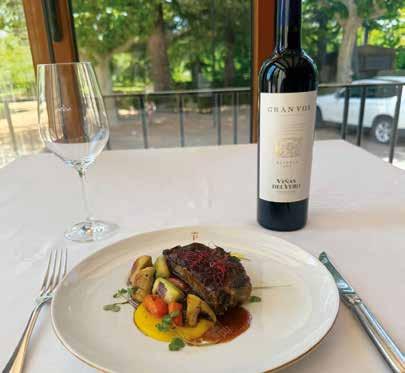
A dish of this calibre deserves an Aragonese wine that can hold its own against its flavour: Viñas del Vero Gran Vos. Made with an excellent selection of red grapes, it is a reserve wine whose elegance is evident at first sight, and a wine for aging, with great potential to mature in the bottle over the years.
Viñas del Vero. Barbastro (Huesca). González Byass Group
Designation of Origin: Somontano.



Denominación de Origen: Somontano.
Variedad: selección de las mejores uvas tintas de cada vendimia.
Elaboración: fermentaciones y crianzas varietales. Posterior ensamblaje tras una selección de los grupos de barricas.
Crianza: quince meses en barricas de roble francés.
Vista: aspecto brillante y capa cerrada.
Aroma: intensa y amplia paleta aromática dotada de gran cantidad de matices, de complejidad y elegancia, que invitan a descubrir su armoniosa boca.
Paladar: sabroso, carnoso, grueso y largo.
Maridaje: ideal con carpaccios, carne roja, guisos, caza, quesos semicurados y postres de chocolate amargo.
Servicio: temperatura entre 16 y 18 ºC.
Variety: A selection of the best red grapes from each harvest.
Winemaking: Fermentation and varietal ageing. Subsequent blending after selection from barrel groups.
Aging: 15 months in French oak barrels.
Appearance: Bright appearance with a deep colour.
Aroma: An intense and wide aromatic range with a great variety of nuances, complexity, and elegance, inviting one to discover its harmonious palate.
Palate: Flavourful, full-bodied, thick, and long-lasting.
Food Pairing: Ideal with carpaccio, red meat, stews, game, semi-cured cheeses, and dark chocolate desserts.
Serving: temperature between 16 and 18°C.

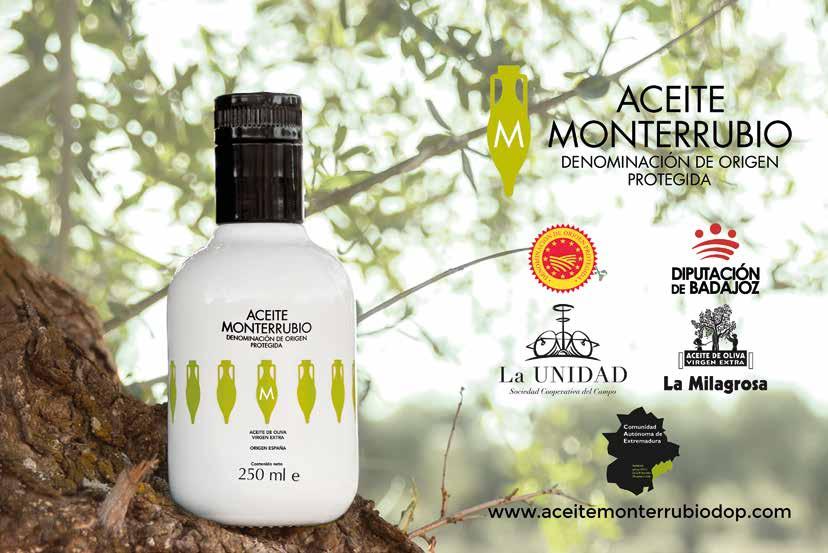
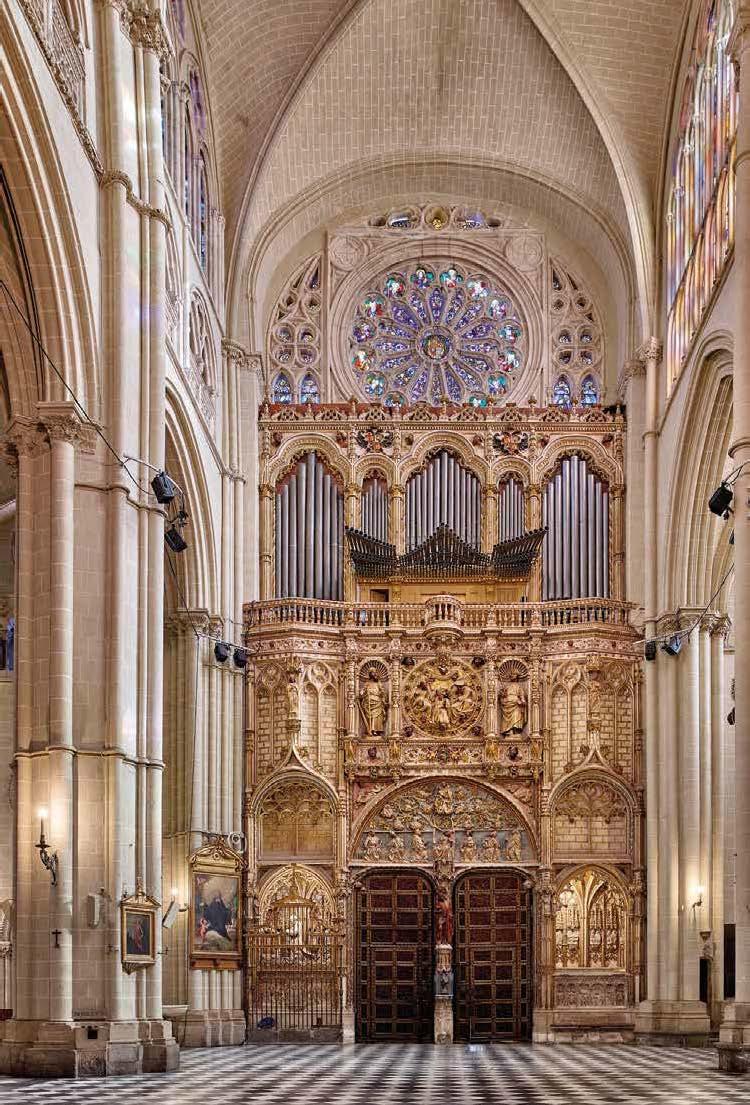

TOLEDO AND SEGOVIA CELEBRATE THE EIGHTH AND FIFTH CENTURIES OF THEIR ICONIC TEMPLES
MARKEL SIERRA, LUIS TEJEDOR
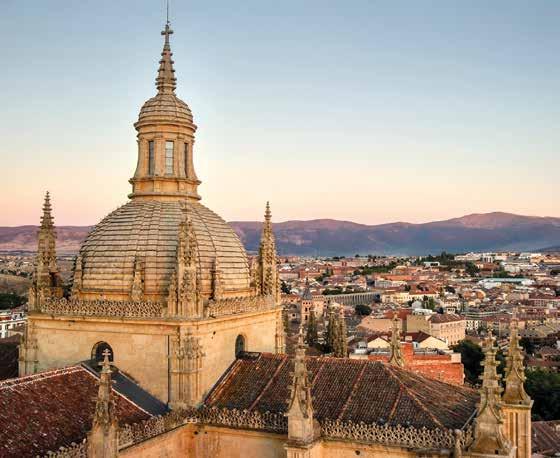
En 2025, a dos grandes hitos de la arquitectura española les toca soplar velas: la Catedral de Toledo, cuya construcción comenzó hace casi ocho siglos, y la Catedral de Segovia, que celebra cinco siglos desde que se colocó su primera piedra. Ambas ciudades se preparan para honrar estos edificios, testigos eternos de la historia y la cultura que han moldeado. /
In 2025, two major milestones in Spanish architecture will blow out their candles: the Toledo Cathedral, whose construction began nearly eight centuries ago, and the Segovia Cathedral, celebrating five centuries since the first stone was laid. Both cities are preparing to honour these buildings, eternal witnesses of the history and culture they have shaped.
Las históricas ciudades de Toledo y Segovia celebran en 2025 sendos aniversarios que rememoran el inicio de las obras de dos de sus monumentos más señeros: la catedral primada y la catedral gótica respectivamente. Estas joyas arquitectónicas, testigos de siglos de historia y fe, invitan a descubrir no solo su imponente estructura sino también la profunda huella que han dejado en las ciudades que las albergan.
Aunque la Santa Iglesia Catedral, consagrada a la Virgen María en su Asunción a los cielos, comenzó a construirse en 1226 bajo el mandato del arzobispo Rodrigo Jiménez de Rada, el tiempo ya había dejado allí estratos de historia. En el siglo VI, existía una iglesia visigoda que habría de convertirse en una de las mezquitas más importantes de Al Ándalus. De aquellos días se conservan elementos árabes bajo el suelo de la Catedral, como pozos con hermosos brocales, y una refinada caligrafía, similar a la expuesta en el Museo de la Santa Cruz. También permanecen una columna de la capilla de Santa Lucía y algunos fustes y capiteles de mármol en el exterior del coro.
«Una catedral, al igual que el lanzamiento de un cohete a la Luna, es tecnología punta»
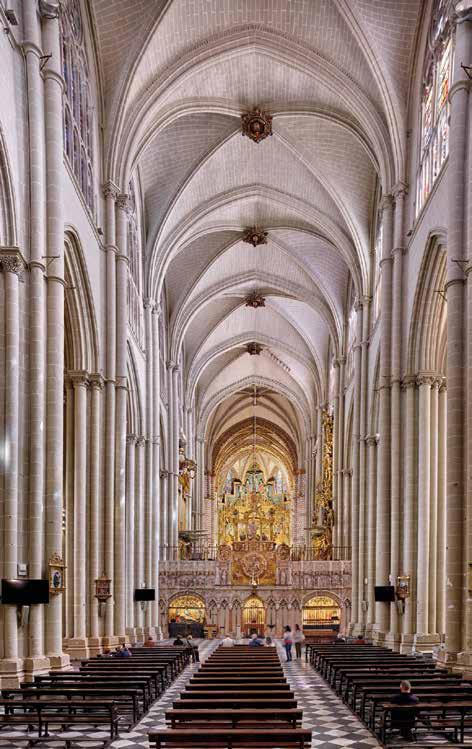
Tras la conquista de Alfonso VI, la mezquita entró en decadencia. La superioridad militar cristiana condujo a la destrucción de este espacio, que ya hacía las veces de catedral, para edificar el templo actual. La ubicación no fue un capricho: el objetivo era recuperar la primacía de la antigua catedral visigoda, disputada por Santiago de Compostela, Tarragona y Burgos. Jiménez de Rada –quien, paradójicamente, no fue enterrado en la catedral– fue la mente detrás del proyecto, con la intención de que Toledo se consolidara como corazón de la monarquía castellana.
Ken Follett Puestos a echar la casa por la ventana, la Ciudad Imperial inició en 2024 los eventos de conmemoración de su catedral primada, con la reactivación del proyecto Lúmina, una imprescindible visita nocturna que combina luz y sonido para ofrecer una nueva perspectiva del templo. Desde entonces, no han faltado conciertos, ciclos de conferencias y hasta un Congreso Eucarístico. Por su singularidad, destaca la restauración del «Rosario de Cristal», una obra de gran valor que se exhibirá y que, por primera vez, se espera que procesione el 7 de diciembre de 2025 en honor a la Inmaculada, permitiendo admirar públicamente su esplendor.
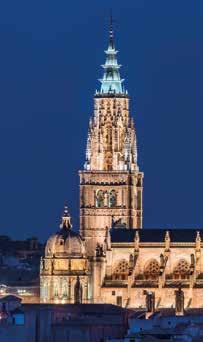
The historic cities of Toledo and Segovia will celebrate in 2025 the anniversaries marking the beginning of the construction of two of their most emblematic monuments: the primatial cathedral and the Gothic cathedral, respectively. These architectural jewels, witnesses to centuries of history and faith, invite us to discover not only their imposing structures but also the profound impact they have left on the cities that house them.
Even if the Cathedral, dedicated to Virgin Mary in her Ascension to the heavens, began to be built in 1226 under order of the Archbishop Rodrigo Jiménez de Rada, its history already goes back centuries. In the 6th century, there was a Visigothic church that would become one of the most important mosques in Al-Andalus. Under the floor of the Cathedral, Arab elements from those days are preserved, such as wells with beautiful curbstones and refined calligraphy, similar to the one on display in the Museum of Santa Cruz, or a column from the chapel of Santa Lucia and some marble shafts and capitals from the exterior of the choir.
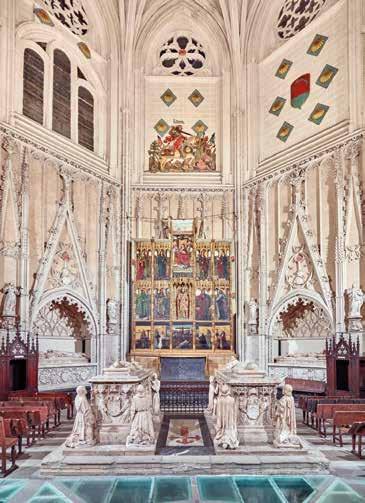
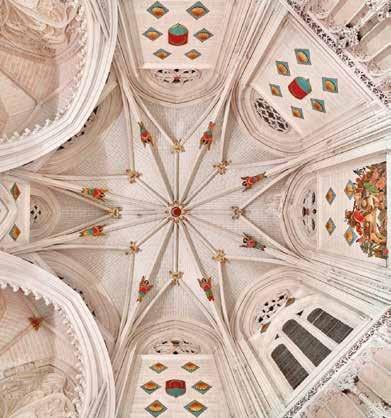
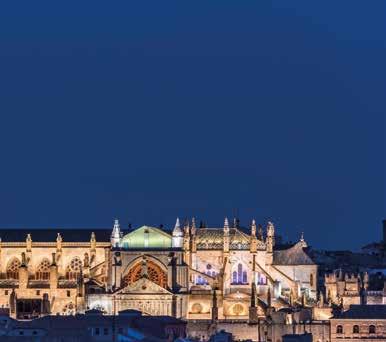
“A cathedral, much like the launch of a rocket to the Moon, is cutting-edge technology”
KEN FOLLET
After the conquest of Alfonso VI, the mosque began its decline. The Castilian military superiority led to the destruction of this space, which was already serving as a cathedral, in order to build the current temple. The location of it was not a whim: the objective was to recover the political and spiritual supremacy of the ancient Visigothic cathedral, which was being disputed by Santiago de Compostela, Tarragona and Burgos. Jiménez de Rada –who, paradoxically, was not buried in the cathedral– was the mastermind behind the project, with the intention of consolidating Toledo as the heart of the Castilian monarchy.
To go all out, the Imperial City began its 2024 celebrations commemorating its primatial cathedral, with the revival of the Lúmina project, an essential night-time tour that combines light and sound to offer a new perspective on the temple. Since then, there have been concerts, lecture cycles, and even an Eucharistic Congress. Noteworthy for its uniqueness is the restoration of the “Crystal Rosary,” a highly valuable work of art that will be displayed and, for the first time, is expected to be part of a procession on 7 December 2025 in honour of the Immaculate Conception, allowing the public to admire its splendour.
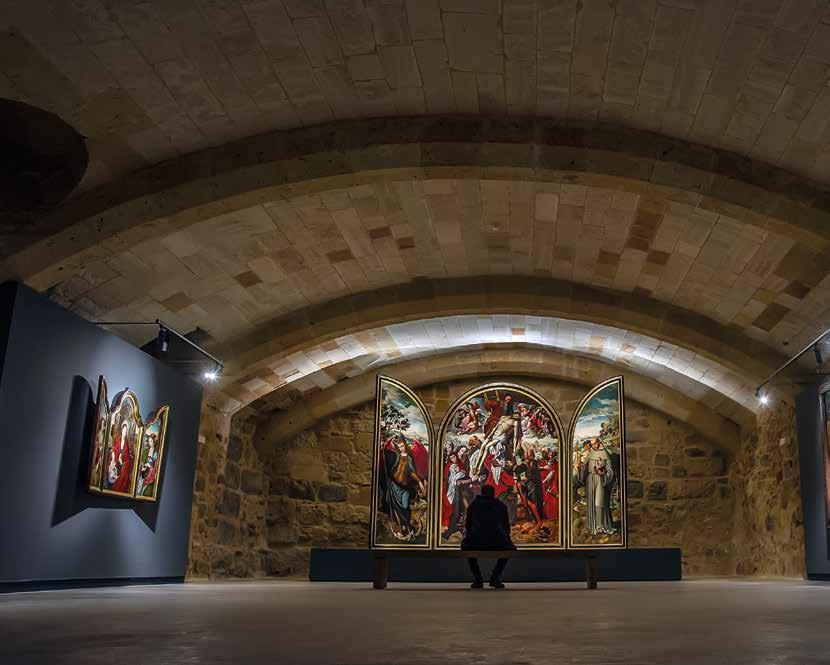
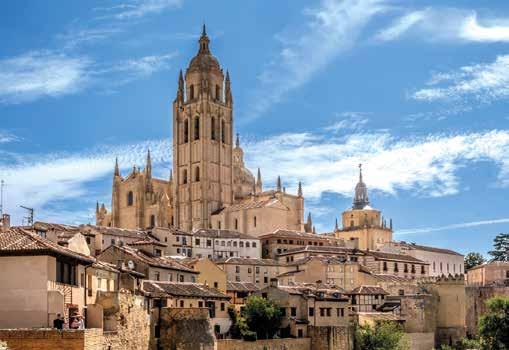
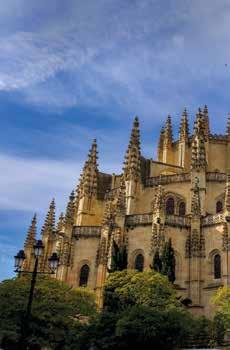
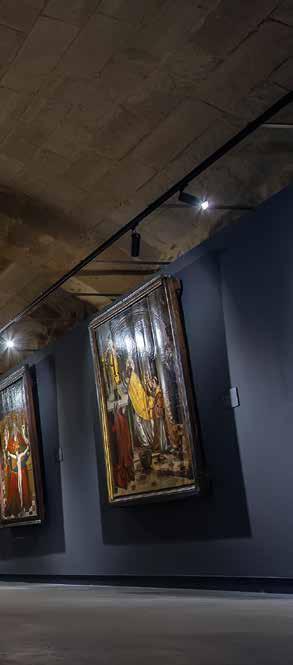
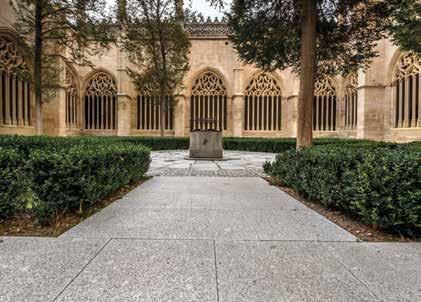
La historia de España, tan dada a sucesos turbulentos, tuvo en la Guerra de las Comunidades de Castilla (15201525) la causa inesperada de una formidable consecuencia: la Catedral de Segovia. El asedio del Alcázar segoviano por parte de los comuneros, que no tenían en alta estima a Carlos I, tuvo en la vetusta seo románica una víctima colateral de tanto ardor bélico.
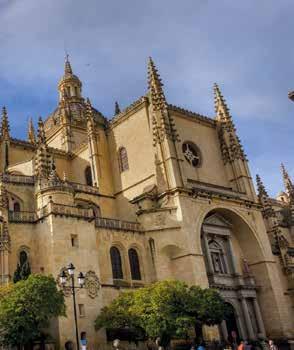
Fue el 8 de junio de 1525 cuando se colocó la primera piedra de esta nueva edificación, bajo el reinado del primero de los Austrias. Más allá de su significación religiosa, la idea era reflejar la grandeza de una era y la solidez de un reinado. El diseño inicial corrió a cargo del arquitecto Juan Gil de Hontañón, aunque la obra fue continuada por su hijo Rodrigo y otros maestros a lo largo de los siglos.
Inmersa ya en la celebración del quinto centenario, los visitantes que quieran sumergirse en la historia de este templo disponen de visitas guiadas especiales, algunas temáticas. Sin duda, uno de los platos fuertes de cualquier recorrido por la catedral será la visita a la capilla de La Piedad para contemplar la exposición «La Leyenda de San Jorge», que incluye la obra del taller de Peter Paul Rubens, Paisaje con San Jorge y el dragón. Esta pintura puede ya verse en una puesta en escena expositiva que incorpora información artística sobre la obra, su autor y procedencia, junto con el relato iconográfico.
The history of Spain, so prone to turbulent events, had in the War of the Communities of Castile (1520-1525) the unexpected cause of a formidable consequence: the Segovia Cathedral. The siege of the Segovia Alcázar by the comuneros, who did not hold Charles I in high regard, had in the ancient Romanesque cathedral a collateral victim of such intense warfare.
It was on 8 June 1525 that the first stone of this new building was laid, under the reign of the first of the Habsburgs. Beyond its religious significance, the idea was to reflect the grandeur of an era and the solidity of a reign. The initial design was carried out by architect Juan Gil de Hontañón, although the work was continued by his son Rodrigo and other masters over the centuries.
Already immersed in its fifth centenary celebrations, visitors who wish to delve into the history of this temple can enjoy special guided tours, some with specific themes. Undoubtedly, one of the highlights of any tour of the cathedral will be the visit to the Chapel of La Piedad to see the exhibition “The Legend of Saint George,” which includes the work from the Peter Paul Rubens workshop, Landscape with Saint George and the Dragon. This painting can now be seen in an exhibition setup that incorporates artistic information about the work, its author, and its origin, along with the iconographic narrative.
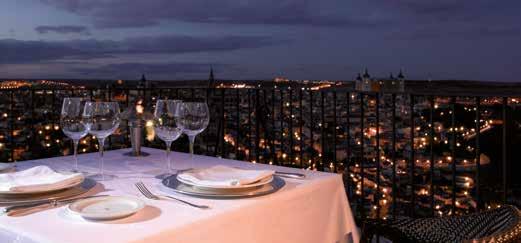
Ubicado sobre uno de los cerros del sur de la ciudad, el Parador ofrece la mejor vista panorámica de las Tres Culturas, convirtiéndose en el punto de partida ideal para visitar Toledo. El Parador es castellano-manchego por los cuatro costados, algo evidente una vez que se pisa su amplia explanada y se contemplan los porches de madera que sostienen la cubierta de teja árabe. Heredero de las tres culturas que poblaron la ciudad imperial ofrece una propuesta culinaria basada en la consistente y sabrosa gastronomía local, que bebe de la cultura cazadora y pastoril. La perdiz estofada a la toledana, las migas del pastor y el lomo de ciervo marinado, entre otras especialidades, atestiguan su excelencia.
A tres kilómetros del centro histórico de Segovia se encuentra el Parador, un moderno edificio diseñado por Joaquín Pallás en 1963, destaca como un prodigio arquitectónico que mezcla los estilos brutalista y regionalista. Con una ubicación privilegiada y orientación suroeste, ofrece una de las mejores vistas de la ciudad. La combinación de hormigón, ladrillo y cristal le otorga una identidad dis tintiva y vanguardista. El interior está decorado con estilo clásico que cuida cada mínimo detalle con sencilla elegancia. Si se puede elegir, nada mejor que alojarse en una habitación con terraza amueblada desde la que seguir con templando la ciudad. La carta del restaurante es un amplio escaparate de la generosidad del recetario regional. Aquí mandan los asados de cochinillo y lechazo en su horno de leña, bacalao al estilo Carrascal del Río, chuletón de buey premium o el tradicional ponche de yema y mazapán como postre.

Located on one of the hills to the south of the city, the Parador offers the best panoramic view of the Three Cultures City, making it the ideal starting point for visiting Toledo. The Parador is Castilian Manchego through and through, something that becomes evident once you step onto its wide esplanade and admire the wooden porches supporting the Arabic-tile roof. Heir to the three cultures that populated the imperial city, it offers a culinary proposal based on the hearty and flavoursome local cuisine, which draws from the hunting and shepherding culture. Stewed partridge in the Toledo style, shepherd’s migas, and marinated venison loin, among other specialties, testify to its excellence.
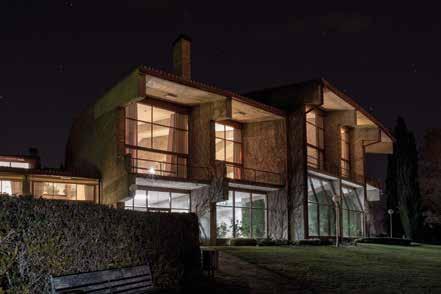
Three kilometres from the historic centre of Segovia stands the Parador, a modern building designed by Joaquín Pallás in 1963, which stands out as an architectural marvel blending brutalist and regionalist styles. With a privileged location and a southwest orientation, it offers one of the best views of the city. The combination of concrete, brick, and glass gives it a distinctive and avant-garde identity.
The interior is decorated in a classic style, paying attention to every little detail with simple elegance. If possible, nothing beats staying in a room with a furnished terrace from which to continue enjoying the view of the city. The restaurant’s menu is a broad showcase of the generosity of the regional recipes. Roast suckling pig and lamb in the wood-fired oven, cod Carrascal del Río style, premium beef rib-eye, and the traditional egg yolk and marzipan “ponche” (cake) for dessert are the stars of the menu.
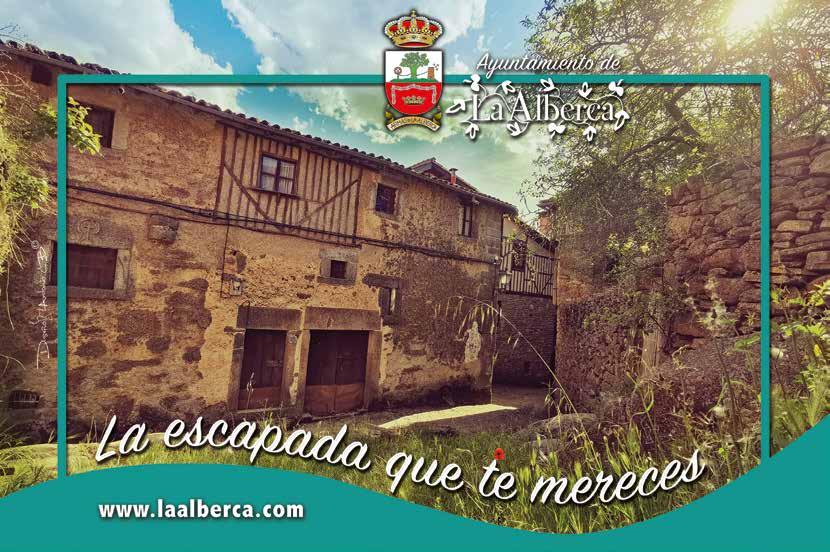
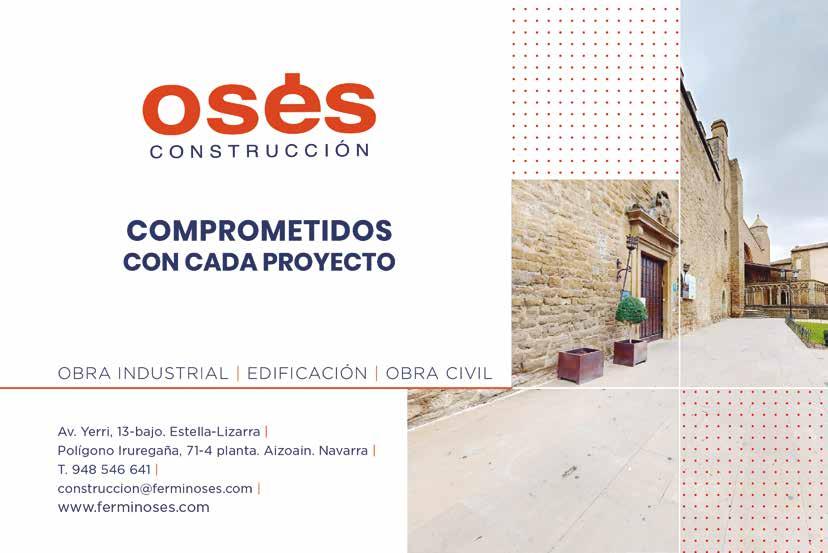
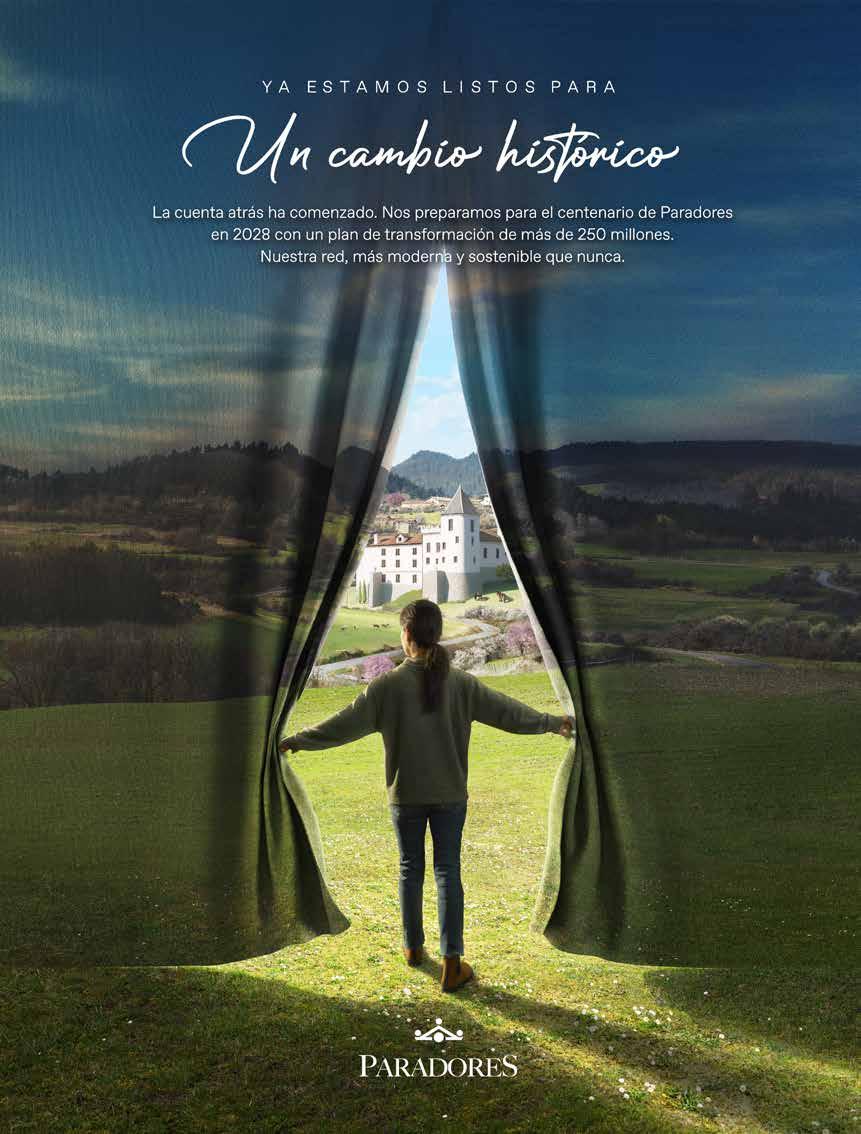
Mis personajes casi siempre sacan las uñas, no se rinden, nunca dejan de intentarlo

“My characters almost always fight back, they don’t give up, and they never stop trying”
Desde que, en 2009, El tiempo entre costuras se convirtiera en el debut soñado por cualquier escritor, María Dueñas ha hecho de cada una de sus novelas un acontecimiento esperado por una numerosísima comunidad de lectores. Su última obra, Por si un día volvemos, no es una excepción.
Ambientada en la Argelia francesa, exige atención desde la primera página gracias a Cecilia, protagonista con alma de seda y acero.
Por si un día volvemos traza un arco de treinta años hasta 1962, con el éxodo de los pieds-noirs de Argelia. ¿Qué le llamó la atención de ese tiempo y ese lugar?
En esta novela me centro en la última etapa de la Argelia francesa, cubriendo un arco temporal de treinta y cinco años, desde finales de la década de los veinte hasta la independencia en 1962. Sitúo la acción en Orán, ciudad mediterránea muy cercana a las costas del sureste peninsular, con una gran vinculación histórica con España. Durante la etapa francesa, y gracias a las oportunidades laborales, llegaron allí miles de emigrantes españoles. La trama se centra en el devenir de una mujer española, Cecilia Belmonte, durante las últimas décadas de aquella época colonial, años repletos de turbulencias dentro de un mundo en el que varias capas sociales y culturales –árabes, franceses, españoles– se superponen en una convivencia que poco a poco se va agrietando. Es un capítulo de nuestra historia muy desconocido, a pesar de la nutrida comunidad procedente de España que allí hubo siempre.
La presencia de españoles en Argelia retratada en la novela lleva a momentos donde la emigración era común. ¿Cómo contempla este fenómeno hoy? ¿Se trata con demasiada ligereza este complejo problema?
He reflexionado mucho sobre esto mientras escribía la novela. He pensado, sobre todo, en cómo hemos evolucionado los españoles, pasando en solo unas pocas décadas de ser una nación de emigrantes a convertirnos en un país receptor de personas de procedencias muy distintas. A veces, esta situación se convierte en un problema complejo. No sé cuáles son las mejores soluciones, pero, desde luego, conviene que mantengamos la sensibilidad de quienes fuimos no hace tanto tiempo.
¿Cómo eran aquellos españoles presentes en Argelia? ¿Hay alguna historia que le tocara especialmente?
Algunos –los menos– fueron empresarios o profesionales. La mayoría eran personas de origen modesto que progresaron gracias a su tesón y esfuerzo. Hay muchas historias impactantes, admirables, conmovedoras… Una de las más conocidas es la de Albert Camus, descendiente, por línea materna, de humildes emigrantes menorquines asentados en Argel, la capital. Viniendo de un origen muy humilde, casi mísero, acabó siendo Premio Nobel de Literatura en 1957.
Durante la fase documentación, ¿qué buscaba entre la maraña de información disponible?
En todas mis novelas, para reconstruir los universos en los que sitúo las tramas, utilizo todo tipo de documentación. Mi propósito no es solo contar qué ocurrió en aquellos días y lugares en términos históricos; también pretendo recrear atmósferas y dotar esa realidad de vida: de olores, colores, sabores, sonidos, texturas… Me interesa saber cómo era la gente que vivía allí en esos momentos, cómo hablaban y se vestían, quiénes eran sus vecinos, qué comían y bebían, qué leían o escuchaban en la radio. Cómo eran sus viviendas, sus calles, sus barrios, sus negocios… Gracias a la suma de todos esos detalles, logro levantar escenarios que permiten a los lectores sumergirse en el ambiente de cada novela con la mayor precisión posible.

Since 2009, when The Time in Between became the dream debut for any writer, María Dueñas has made each of her novels an eagerly awaited event for a large community of readers. Her latest work, Por si un día volvemos , is no exception. Set in French Algeria, it demands attention from the very first page thanks to Cecilia, a protagonist with a soul made of silk and steel.

Por si un día volvemos shows a thirty-year span until 1962, with the exodus of the pieds-noirs from Algeria. What drew you to that time and place?
In this novel, I focus on the last stage of French Algeria, covering a time span of thirty-five years, from the late 1920s to independence in 1962. I set the action in Oran, a Mediterranean city very close to the southeast coast of Spain, with a strong historical connection to Spain. During the French period, and thanks to work opportunities, thousands of Spanish immigrants arrived there. The plot revolves around the life of a Spanish woman, Cecilia Belmonte, during the final decades of that colonial era, years full of turbulence within a world where several social and cultural layers –Arabs, French, Spaniards– overlap in a coexistence that gradually begins to crack. It’s a chapter of our history that is largely unknown, despite the significant community from Spain that has always been there.
The presence of Spaniards in Algeria depicted in the novel takes us to moments when emigration was common. How do you view this phenomenon today? Is this complex issue treated too lightly?
I’ve thought a lot about this while writing the novel. I’ve especially reflected on how we, the Spanish, have evolved, going from being a nation of emigrants to becoming a country that now receives people from very different backgrounds in just a few decades. Sometimes, this situation becomes a complex problem. I don’t know what the best solutions are, but we certainly need to maintain the sensitivity of who, not long ago, were.
En sus novelas, las mujeres avanzan pese a la adversidad. ¿Cómo define el coraje femenino? ¿Afrontan las dificultades de una manera diferente hombres y mujeres?
A menudo, es una mezcla de fortaleza con vulnerabilidad, algo consustancial al ser humano y, quizá de forma más específica, a la propia esencia de las mujeres. Sortear obstáculos y encarar las adversidades, sacar fuerzas de donde creemos que ya no quedan, vencer la vulnerabilidad y seguir creciendo son realidades a las que la mayoría de las mujeres estamos acostumbradas. Esto es lo que yo transfiero de una manera casi orgánica a mis personajes. A veces consiguen sus objetivos y salen a flote o incluso triunfan; otras veces caen, se fracturan y les cuesta levantarse. No obstante, mis personajes casi siempre sacan las uñas, no se rinden, nunca dejan de intentarlo.
¿Cómo es Cecilia? ¿Qué buscaba a la hora de construir su personalidad?
Cuando la conocemos, en las primeras páginas, es una joven que huye de un crimen involuntario bajo la falsa identidad de Cecilia Belmonte. De su mano, transitamos por esas últimas décadas de la Argelia francesa, desde su llegada, siendo una joven miserable, ignorante y proclive al abuso, hasta despedirla convertida en una empresaria solvente. A lo largo de esos años, seremos testigos de su crecimiento como persona, conoceremos a sus amores, amigos y socios, compartiremos sus anhelos e inquietudes, y la veremos abrirse camino en el negocio de la fabricación y venta de jabón, desde su comienzo como una actividad humilde y clandestina, hasta convertirse en una mujer admirable.
¿Ha cambiado su forma de afrontar una historia desde que dejó de ser una autora desconocida con El tiempo entre costuras?
Cuando escribí mi primera novela, yo era una profesora universitaria dedicada a la docencia y la investigación a tiempo completo, que arañaba horas al día para avanzar en una novela que aún no sabía si sería o no publicada. Ahora me dedico únicamente a la escritura y, tras completar cada obra, la acompaño para presentarla a los lectores, medios de comunicación, libreros... En ese sentido, mi actividad literaria es ahora mucho más profesional y organizada. Me agrada ponerme en movimiento después de terminar cada novela, igual que agradezco retirarme después de un período de actividad pública para arrancar un nuevo libro.


How were those Spaniards present in Algeria? Is there a story that particularly touched you?
Some –the few– were businessmen or professionals. Most were people of modest origins who made progress through their determination and hard work. There are many striking, admirable, and moving stories... One of the best-known is that of Albert Camus, who was, on his mother’s side, a descendant of humble Menorcan emigrants settled in Algiers, the capital. Coming from a very humble, almost miserable background, he ended up winning the Nobel Prize in Literature in 1957.
During the research phase, what did you look for among the wealth of available information?
In all my novels, to reconstruct the universes where I set the plots, I use all kinds of documentation. My goal is not just to tell what happened in those days and places in historical terms; I also want to recreate atmospheres and bring that reality to life: smells, colours, flavours, sounds, textures… I’m interested in knowing how the people who lived there at that time were, how they spoke and dressed, who their neighbours were, what they ate and drank, what they read or listened to on the radio. What were their homes like, their streets, their neighbourhoods, their businesses... Thanks to the sum of all these details, I’m able to create settings that allow readers to immerse themselves in the atmosphere of each novel with the greatest possible accuracy.
In your novels, women move forward despite adversity. How do you define feminine courage? Do men and women face difficulties in a different way?
Often, it’s a mixture of strength and vulnerability, something inherent to being human and perhaps more specifically to the essence of women. Navigating obstacles and confronting adversities, drawing strength from where we believe there is none left, overcoming vulnerability and continuing to grow are realities that most women are used to. This is what I transfer almost organically to my characters. Sometimes they achieve their goals and stay afloat, or even triumph; other times they fall, fracture, and struggle to rise again. Nevertheless, my characters almost always fight back, they don’t give up, and they never stop trying.
“Feminine courage is a mixture of strength and vulnerability”
What about Cecilia? What did you aim for when building her personality?
When we meet her, on the first pages, she is a young woman fleeing from an involuntary crime under the false identity of Cecilia Belmonte. Through her, we walk through the last decades of French Algeria, from her arrival as a miserable, ignorant young woman prone to abuse, to her departure as a successful businesswoman. Over these years, we witness her growth as a person, we get to know her loves, friends, and business partners, we share her desires and worries, and we see her carve a path in the soap manufacturing and sales business, starting from a humble, underground activity, until she becomes an admirable woman.
Has your way of approaching a story changed since you became a known author thanks to The Time in Between?
When I wrote my first novel, I was a university professor dedicated to teaching and research full-time, stealing hours from my day to make progress on a novel that I didn’t even know would be published or not. Now, I dedicate myself solely to writing, and after completing each work, I accompany it to present it to readers, the media, booksellers... In that sense, my literary activity is now much more professional and organised. I enjoy getting moving after finishing each novel, just as I appreciate retreating after a period of public activity to start a new book.

¿Qué opina de la figura del autor como personaje mediático? ¿Siente responsabilidad hacia la amplia comunidad de lectores que le siguen?
El éxito de los escritores es muy manejable, para nada abrumador o incómodo, menos aún para alguien como yo, que tiene escasa presencia activa en redes sociales y se mantiene al margen de debates públicos ajenos a mi trabajo. Si alguien se te acerca es normalmente con respeto; yo me muevo con absoluta comodidad, agradecida por la atención que despiertan mis novelas entre los lectores y sin que el éxito me pese. Además, sería injusto decir que el éxito no acarrea también algunas consecuencias agradables: reconocimientos muy gratos, la posibilidad de participar en acciones atractivas o de conocer a gente muy interesante.
¿Una narradora de éxito como usted tiene miedos a la hora de enfrentarse a una historia? Si los tiene, ¿cómo los exorciza?
No, no tengo ningún miedo, al contrario. Cada nuevo proyecto es ilusionante; ante mí se abre un mundo nuevo en el que sumergirme para construir un universo, crear personajes cautivadores y componer una historia con la que espero volver a seducir a los lectores.
¿Conoce la Red de Paradores? ¿Tiene algún favorito?
La conozco y la disfruto siempre que puedo. Mi favorito es el de Almagro; allí celebré mi boda y las de casi todos mis hermanos. Este próximo mes de octubre volveremos a reunirnos en él, para una nueva celebración, con toda mi gran familia.
«El coraje femenino es una mezcla de fortaleza con vulnerabilidad»
What do you think of the figure of the author as a media personality? Do you feel responsible towards the large community of readers who follow you?
The success of writers is very manageable, not overwhelming or uncomfortable at all, even less so for someone like me, who has minimal active presence on social media and stays out of public debates unrelated to my work. If someone approaches you, it’s usually with respect; I move with absolute comfort, grateful for the attention my novels generate among readers, and without the success weighing on me. Furthermore, it would be unfair to say that success doesn’t also bring some pleasant consequences: very gratifying recognitions, the chance to participate in attractive activities, or to meet very interesting people.
Does a successful narrator like you have fears when facing a new story? If you do, how do you exorcise them?
No, I have no fear, on the contrary. Every new project is exciting; before me opens up a new world in which I can immerse myself to build a universe, create captivating characters, and compose a story with which I hope to seduce readers once again.
Are you familiar with the Paradores Network? Do you have a favourite?
I know it and enjoy it whenever I can. My favourite is the one in Almagro; I celebrated my wedding there, and almost all my siblings’ weddings too. This coming October, we will gather again for a new celebration with my entire large family.

Pierre Lemaitre, ganador del Premio Goncourt, continúa su tetralogía años gloriosos con Un futuro prometedor Esta novela retrata la Francia de los años sesenta y explora las transformaciones sociales y políticas de la época. Con su estilo característico, Lemaitre ofrece una narrativa rica en detalles y personajes complejos, consolidando su posición como uno de los grandes narradores contemporáneos.


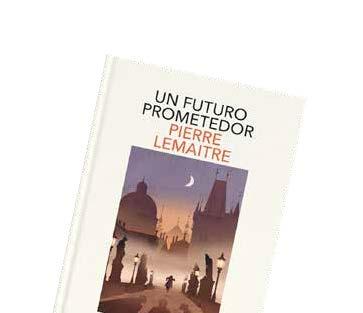
Tras el éxito internacional de Amarilla, R. F. Kuang se consolida como una de las voces más potentes de la fantasía contemporánea. Con Catábasis un giro hacia el dark academia con tintes mitológicos. Alice Law y Peter Murdoch, dos estudiantes brillantes y rivales, deben descender literalmente al infierno para recuperar el alma de su difunto profesor. Inspirada en Dante y en el mito de Orfeo, Kuang construye un inframundo tan inquietante como fascinante, donde la magia académica se entrelaza con la culpa, la ambición y el sacrificio. Con diálogos agudos, tensiones latentes y una ambientación poderosa, Catábasis es tanto una exploración del conocimiento como una odisea emocional: una novela donde salvarse a uno mismo puede ser el mayor desafío.
CARLES LLUSÀ
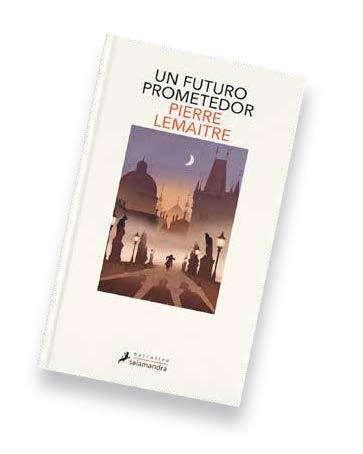

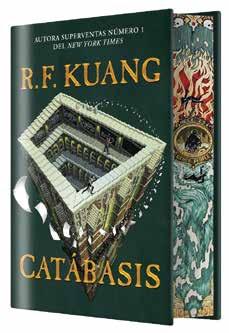
Pierre Lemaitre
Pierre Lemaitre, winner of the Goncourt Prize, continues his teThe Glorious Years with . This novel portrays 1960s France and explores the social and political transformations of the era. With his distinctive style, Lemaitre delivers a narrative rich in detail and complex characters, establishing his position as one of the great contemporary storytellers.
Following the international success of Babel and Yellowface, establishes herself as one of the most powerful voices in contemporary fantasy. With Katabasis, she takes a turn towards dark academia with mythological undertones. Alice Law and Peter Murdoch, two brilliant and rival students, must literally descend into hell to retrieve the soul of their deceased professor. Inspired by Dante and the myth of Orpheus, Kuang creates an underworld that is as unsettling as it is fascinating, where academic magic intertwines with guilt, ambition, and sacrifice. With sharp dialogue, underlying tensions, and a striking setting, Katabasis is both an exploration of knowledge and an emotional odyssey: a novel where saving oneself may prove to be the greatest challenge.



Freida McFadden, autora bestseller reconocida por sus thrillers psicológicos, presenta Nunca mientas, una historia que desvela los oscuros secretos de una mansión abandonada. Cuando un joven matrimonio adquiere la antigua casa de una psiquiatra desaparecida, comienzan a suceder eventos inquietantes. Con su estilo ágil y envolvente, McFadden mantiene al lector en constante tensión, cuestionando la realidad y las apariencias.


Heinrich Harrer, alpinista austriaco y pionero del montañismo extremo, escribió una de las grandes memorias de viaje del siglo XX. En Siete años en el Tíbet, publicado en 1953, relata su fuga de un campo británico en la India durante la Segunda Guerra Mundial y su increíble travesía hasta llegar a Lhasa, donde fue acogido como tutor del joven Dalái Lama. Harrer convivió con los tibetanos durante años, aprendiendo su lengua y cultura desde dentro, en los últimos días de un mundo que pronto desaparecería con la invasión china. Su relato es al mismo tiempo aventura, crónica histórica y testimonio íntimo. Una obra que combina observación lúcida, espíritu de superación y una mirada respetuosa a una civilización única.

Freida McFadden, a bestselling author renowned for her psychological thrillers, presents Never Lie, a story that uncovers the dark secrets of an abandoned mansion. When a young married couple purchases the former home of a missing psychiatrist, unsettling events begin to unfold. With her fast-paced and immersive style, McFadden keeps the reader on edge, constantly questioning reality and appearances.
Heinrich Harrer
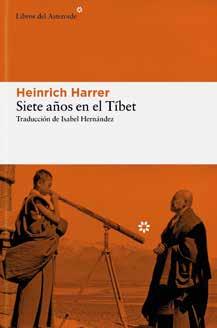

Heinrich Harrer, Austrian mountaineer and pioneer of extreme mountaineering, wrote one of the great travel memoirs of the 20th century. Seven Years in Tibet, published in 1953, he recounts his escape from a British camp in India during World War II and his incredible journey to Lhasa, where he was welcomed as tutor to the young Dalai Lama. Harrer lived among the Tibetans for years, learning their language and culture from the inside, in the final days of a world that would soon vanish with the Chinese invasion. His account is at once an adventure, a historical chronicle, and an intimate testimony. A work that combines lucid observation, a spirit of perseverance, and a respectful gaze at a unique civilization.
mountain moun


Dan Brown, autor de Vinci, regresa con una nueva y trepidante aventura de Robert Langdon. En esta ocasión, el célebre profesor de simbología viaja a Praga para asistir a una conferencia revolucionaria impartida por Katherine Solomon, una brillante científica noética con quien ha iniciado una relación. La novela promete acción vertiginosa, giros inesperados y enigmas por descifrar que atraparán a los lectores como solo Dan Brown sabe hacerlo.


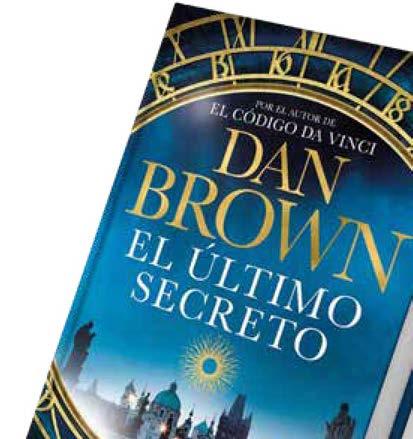


El capitán Alatriste regresa en Misión en París, una nueva entrega de la emblemática saga de espadachines ambientada en la España del Siglo de Oro. Con más de 27 millones de ejemplares vendidos y traducida a más de 40 idiomas, la serie forma ya parte del imaginario colectivo. En esta ocasión, Alatriste viaja a la capital francesa acompañado de Quevedo y Copons para entregar unos despachos secretos. Pero nada es sencillo cuando la política y el acero se cruzan. Catorce años después de puente de los asesinos, esta penúltima novela recupera todo el pulso aventurero que ha hecho inmortal al personaje.








Dan
Dan Brown, author of The Da Vinci Code, returns with a new, thrilling adventure of Robert Langdon. This time, the esteemed professor of symbology travels to Prague to attend a groundbreaking lecture by Katherine Solomon, a prominent noetic scientist with whom he has begun a relationship. The novel promises fast-paced action, unexpected twists, and riddles to solve that will captivate readers in the way only Dan Brown can.
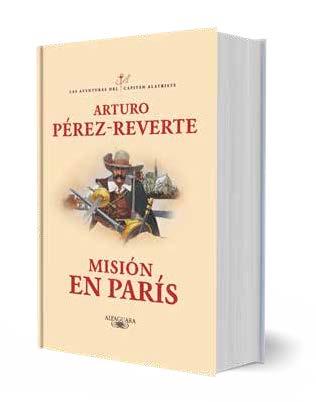
imag adven
Captain Alatriste returns in Mission in Paris, a new novel in the iconic swordsman saga set in Spanish Golden Age. With over 27 million copies sold and translated into more than 40 languages, the series has become part of the imaginary. This time, Alatriste travels to the French capital, accompanied by Quevedo and Copons, to deliver some secret dispatches. But nothing is easy when politics and steel collide. Fourteen years after The Bridge of the Assassins, this last novel but one recaptures all the adventurous spirit that has made the character immortal. El código Da trepi profe prom -
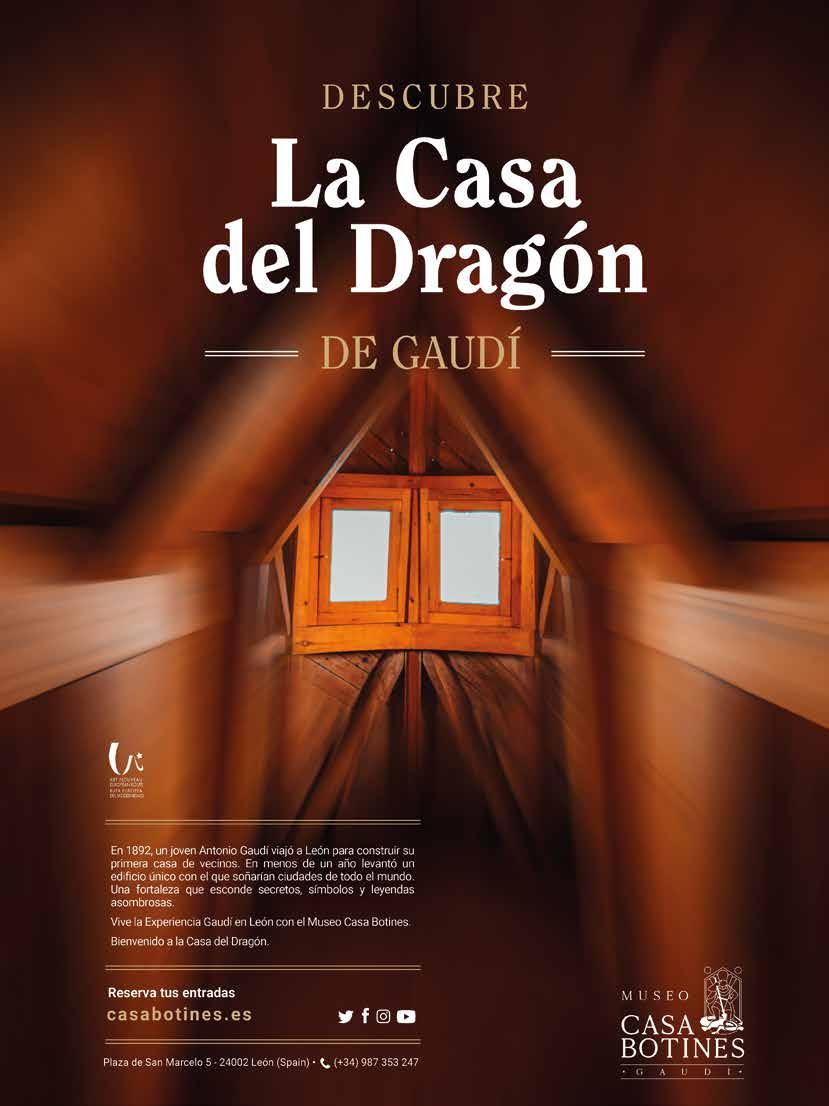


Con 30 años y raíces manchegas, Andrea Garralón lleva más de media década coordinando equipos en el sector del outsourcing comercial. Apasionada por descubrir otras formas de vida, encuentra en los viajes no solo inspiración, sino una forma de entender el mundo. Esa curiosidad constante por lo diverso la llevó a unirse al programa Amigos de Paradores en el verano de 2022. Desde entonces es una entusiasta activa del intercambio cultural.
¿Cómo conoció Paradores? ¿Ha influido el programa Amigos de Paradores en su forma de viajar o en su relación con Paradores?
La cadena la conocí por mi pareja, que guarda un recuerdo muy especial por varios viajes que hizo en su infancia. Tras hospedarnos en nuestro primer Parador, decidimos darnos de alta en el programa. Tenemos claro que queremos hacer la ruta de Paradores y conocer cada uno de ellos. El programa brinda la oportunidad de conocer España a través de edificios emblemáticos y con mucha historia. Las condiciones que ofrece Paradores por ser amigos marcan la diferencia con el resto de las cadenas de la misma categoría.
Como Amiga Oro, ¿qué ventajas del programa valora más en sus estancias?
El sistema de puntos que se van acumulando por noches y consumos, y que, posteriormente, se pueden canjear por noches gratis.
Desde 2022, usted ha visitado más de treinta Paradores…
El primer Parador que visité fue el de Sos del Rey Católico. Es un edificio emblemático en el que se respira encanto por cada rincón. Eso nos motivó a conocer todos los Paradores de la red y ¡lo estamos cumpliendo!
«En Paradores, siempre encontramos lo que buscamos: comodidad, gastronomía y lugares con encanto»
At 30 years old and with roots in La Mancha, Andrea Garralón has spent over five years coordinating teams in the commercial outsourcing sector. Passionate about discovering other ways of life, she finds in travel not only inspiration but also a way to understand the world. This constant curiosity about otherness led her to join the Friends of Paradores program in the summer of 2022. Since then, she has been an active enthusiast of cultural exchange.
How did you discover Paradores? Has the Friends of Paradores program influenced your way of travelling or your relationship with Paradores?
I first discovered the brand through my partner, who has very special memories from several trips he took in his childhood. After staying in our first Parador, we decided to sign up for the program. We are determined to follow the Paradores route and visit each one. The program offers the opportunity to explore Spain through iconic buildings full of history. The benefits Paradores offers to its friends make all the difference compared to other chains of the same category.
¿Algún Parador favorito hasta el momento? ¿Qué lo hace especial para usted?
Por un lado, el de Santiago de Compostela, espectacular edificio histórico ubicado en un sitio inmejorable como es la Plaza del Obradoiro, compuesto por cuatro claustros, una capilla, un restaurante, que te hace pasar una velada muy especial con un pianista en directo, y una taberna más informal donde la comida está riquísima. Por otro lado, está el Parador de Baiona, una fortaleza con unas vistas inmejorables al mar y al pueblo. El edifico es una especie de castillo medieval que te transporta a otra época. Cabe destacar la taberna que tienen de ambiente marinero y desde la que se puede visualizar la bahía y las Islas Cíes. Desde luego, tengo pensado volver. Y en mi lista de pendientes, el Parador soñado es Granada.
¿Qué encuentra en Paradores que no suele encontrar en otras cadenas hoteleras?
La ubicación de los hoteles, en ciudades con historia. Las estancias son también un punto muy favorable, con espacios comunes que los hacen más acogedores, igual que sus diversos salones, ambientados según la temática del Parador. Valoro mucho la posibilidad de acumular el gasto realizado hasta el final de la estancia y que, en función del importe, dispongas de puntos para canjear en siguientes estancias. Además, el orden y la limpieza son notables, lo llevan a rajatabla, y el trato que se recibe por parte del personal es excelente.
Sabemos que nos sigue en redes sociales. ¿Qué le atrae de nuestro contenido?
Me encanta el contenido que se publica en Instagram, especialmente cuando se muestran fotos y vídeos de los diferentes Paradores. Me sirven de inspiración para organizar las escapadas. Me parece muy interactivo que se muestren fotos para adivinar a qué Parador pertenecen.


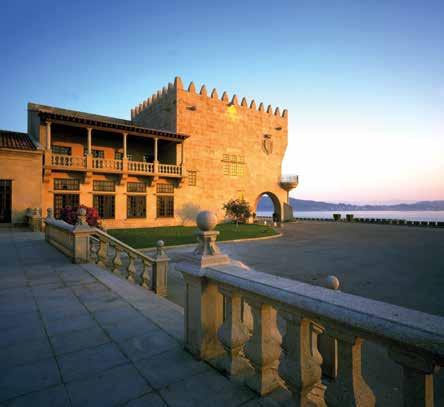
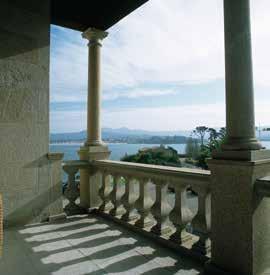
As a Gold Friend, what benefits of the program do you value most during your stays?
The points system that accumulates through nights and purchases, which can later be redeemed for free nights.
“In Paradores we always find what we’re looking for: comfort, gastronomy, and staying in charming places”
Since 2022, you’ve visited more than thirty Paradores...
The first Parador I visited was the one in Sos del Rey Católico. It’s an iconic building, full of charm in every corner. That inspired us to visit all the Paradores in the network, and we’re making it happen!
Do you have a favourite Parador so far? What makes it special for you?
On the one hand, the one in Santiago de Compostela. It’s a spectacular historical building located in an unbeatable spot, the Plaza del Obradoiro, with four cloisters, a chapel, and a restaurant where you can enjoy a very special evening with live piano music, as well as a more casual tavern with delicious food. On
the other hand, there’s the Parador of Baiona, a fortress with unbeatable views of the sea and the village. The building is like a medieval castle that takes you back to another era. It’s worth mentioning the tavern, with its nautical atmosphere, where you can see the bay and the Cíes Islands. I definitely plan to return. And on my list of future visits, the dream Parador is Granada.
What do you find in Paradores that you don’t usually find in other hotel chains?
The location of the hotels, in cities with history. The stays are also a big plus, with common areas that make them more welcoming, just like their various lounges, each themed according to the Parador. I really appreciate the ability to accumulate spending throughout the stay, and based on the amount, earn points that can be redeemed in future stays. In addition, the order and cleanliness are remarkable; they follow strict protocols, and the hospitality provided by the staff is excellent.

Cuando viaja, ¿lo hace habitualmente sola, en pareja, con amigos o en familia?
Habitualmente en pareja, él también es amante de Paradores. Siempre encontramos lo que buscamos: comodidad, gastronomía y hospedarnos en lugares con encanto.
We know you follow us on social media. What attracts you to our content?
I love the content posted on Instagram, especially when photos and videos of the different Paradores are shown. They inspire me to plan getaways. I also find it very interactive when photos are posted, prompting followers to guess which Parador they belong to.
When you travel, do you usually travel alone, with a partner, with friends, or with family?
Usually with my partner, who is also a fan of Paradores. We always find what we’re looking for: comfort, gastronomy, and staying in charming places.
This summer, you’ve booked a route through the southern Paradores. Why did you choose them?
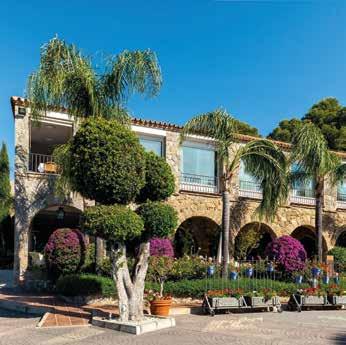
Este verano ha reservado una ruta por los Paradores del sur. ¿Por qué los ha elegido?
Visitaremos los Paradores de Arcos de la Frontera, Cádiz, Ronda, Málaga Gibralfaro y Antequera. Queríamos conocer el sur de la mano de Paradores y haremos esta ruta para conocer los pueblos blancos. Esperamos encontrar mucha historia en los edificios en los que nos hospedemos y la gastronomía típica de la zona.
We’ll be visiting the Paradores in Arcos de la Frontera, Cádiz, Ronda, Málaga Gibralfaro, and Antequera. We wanted to explore the south with Paradores and will be taking this route to visit the white towns. We expect to find a lot of history in the buildings where we stay, along with the typical cuisine of the region.
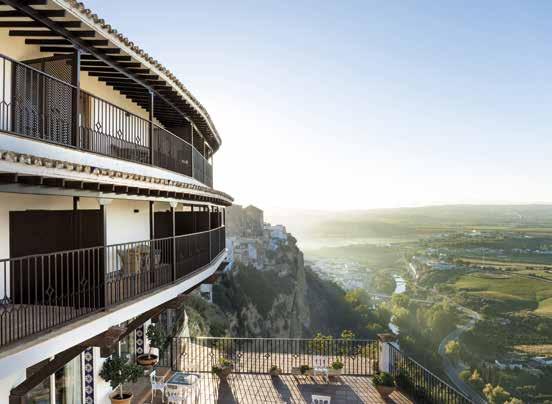

Acumula puntos para conseguir noches gratis
Ofertas y promociones exclusivas
Copa de bienvenida en todas tus estancias
¡Regístrate y disfruta de tu primer desayuno gratis!*
*Con tu próxima reserva como Amigo. Consulta condiciones. y mucho más...
paradores.es Amigos de Paradores: 91 374 26 00 / amigos@parador.es

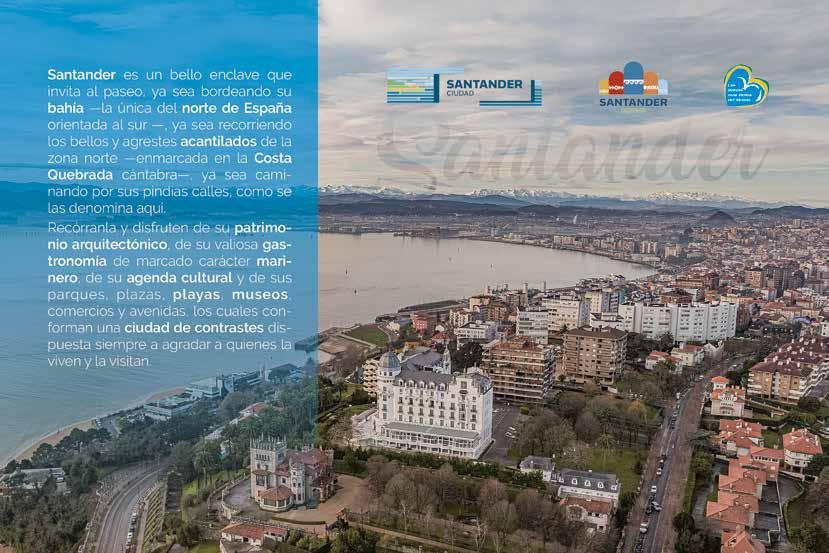
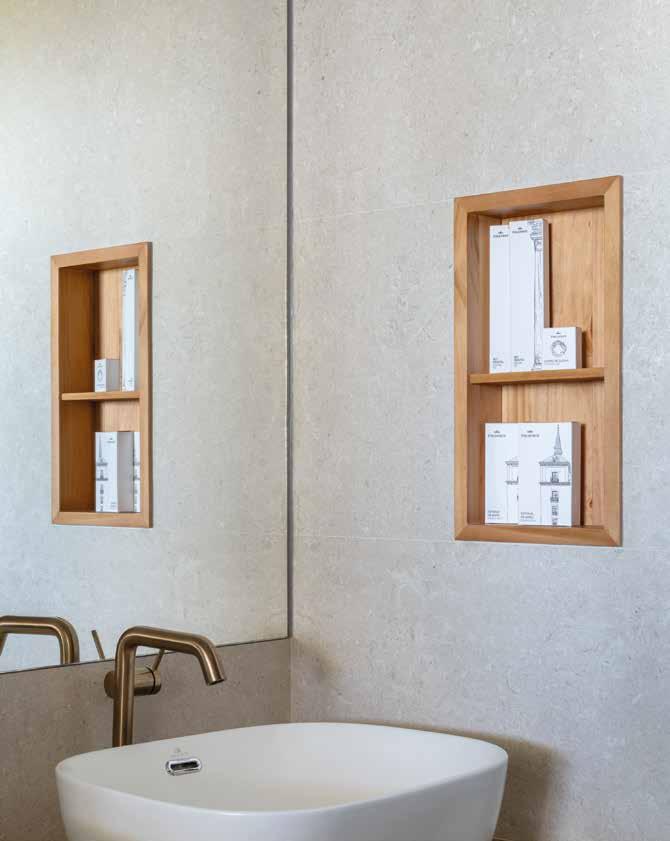
PARADORES ACTUALIZA SU LÍNEA DE AMENITIES: MÁS SOSTENIBLE E INSPIRADA EN SU PATRIMONIO
PARADORES UPDATES ITS AMENITIES LINE: MORE SUSTAINABLE AND INSPIRED BY ITS HERITAGE.
La nueva línea de artículos de bienvenida une funcionalidad, sostenibilidad y atención al detalle en su propuesta. Son productos que componen una oferta pensada para mejorar la experiencia del huésped sin olvidar el compromiso con el entorno. Pequeños gestos que confirman una vocación: hacer del detalle una forma de hospitalidad.
Ser un anfitrión hospitalario no es una cortesía trivial. Se trata de construir vínculos, mediante la atención al detalle, entre el huésped y quien le recibe. Al fin y al cabo, todos hemos sido forasteros alguna vez. En un mundo que gira vertiginosamente hacia la prisa, acoger con generosidad es casi un acto de resistencia, deliciosamente clásico.
En el sector hotelero, las cosas pequeñas marcan la diferencia entre una estancia correcta, sin más, y unos días verdaderamente memorables. Desde la amabilidad en el saludo del personal hasta la limpieza impecable de una habitación, todo cuenta. Son circunstancias que comunican respeto por el cliente. Como las llamadas amenities, esos pequeños artículos exclusivos ofrecidos con el fin de mejorar la estancia del cliente, que ahora renueva la Red en sus establecimientos.
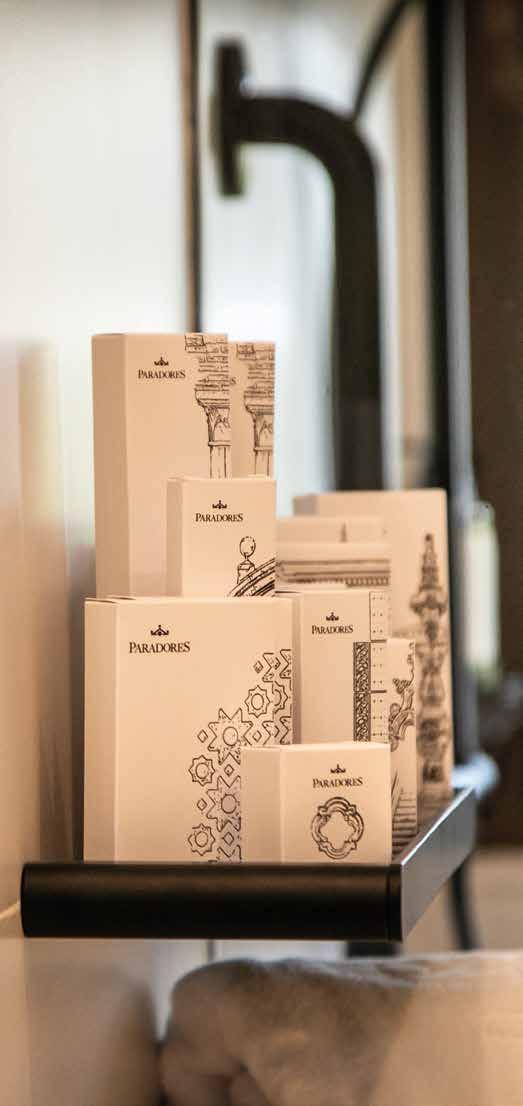

The new line of welcome items combines functionality, sustainability, and attention to detail in its offering. These products make up a selection designed to enhance the guest experience while maintaining a commitment to the environment. Small gestures that confirm a vocation: making detail a form of hospitality.
Being a hospitable host is not a trivial courtesy. It’s about building connections, through attention to detail, between the guest and the host. After all, we have all been strangers at some point. In a world that spins rapidly towards haste, welcoming with generosity is almost an act of resistance, delightfully classic.
In the hotel industry, small things make the difference between an average stay and truly memorable days. From the kindness in the staff’s greeting to the impeccable cleanliness of a room, everything counts. These are circumstances that convey respect for the guest. Like the so-called amenities, those small exclusive items offered to improve the guest’s stay, which are now being renewed by the network in their establishments.
As early as 2019, the network began the process of eliminating single-use plastics in its rooms by replacing welcome items with reusable dispensers and recyclable containers. The new line of bathroom and toiletry amenities takes another step forward in its commitment to sustainability, a value Paradores proudly upholds through the implementation of several key decisions. On one hand, the size of the gel and shampoo dispensers has been increased to reduce the number of containers and plastic consumption. The cosmetic containers are made from recyclable materials, 100% recycled in origin. Additionally, non-essential or single-use items, such as paper bags or cup covers, have been removed.
Furthermore, for the first time, solid cosmetics (gel, shampoo, and toothpaste) have been introduced, which require fewer packages and help reduce the carbon footprint associated with transportation and production. The previous stock is being allocated to common areas and internal services, as outlined in the 2025-2028 Sustainability Plan developed by Paradores.
Ya en 2019, la Red inició el proceso de eliminación de plásticos de un solo uso en sus habitaciones, mediante la sustitución de los artículos de bienvenida por dispensadores reutilizables y recipientes reciclables. La nueva línea de amenities de baño y tocador da un paso más en el compromiso con la sostenibilidad, del que Paradores hace gala mediante la ejecución de varias decisiones clave. Por un lado, se amplía el tamaño de los dispensadores de gel y champú para reducir el número de recipientes y el consumo de plástico. Los envases cosméticos están realizados con materiales reciclables, de origen 100% reciclado. Además, se han retirado elementos no imprescindibles o de un solo uso, como bolsas de papel o fundas de vasos.
Asimismo, por primera vez, se introduce cosmética sólida (gel, champú y pasta dental) que requieren menos envases y contribuyen a reducir la huella de carbono asociada al transporte y la producción. El stock anterior se destina a espacios comunes y servicios internos, como está previsto en el Plan de Sostenibilidad 20252028 elaborado por Paradores.
Como atractivo adicional, el packaging y las etiquetas se han personalizado con una estética que rinde homenaje al legado artístico de Paradores, fruto de un acertado rediseño realizado por el equipo de marca de la Red. Cada envase y producto incorpora ilustraciones inspiradas en elementos singulares de edificios históricos de la cadena.
El bálsamo labial, el costurero, la gamuza limpiazapatos, el champú, el acondicionador sólido y el jabón corporal lucen grabados del Parador de Tordesillas. El cepillo para el pelo, el gorro de ducha y el kit de buenas noches se ilustran, respectivamente, con la vitrina del Parador de Limpias, el óculo del Parador de Cuenca y los azulejos del restaurante del Parador de Guadalupe.
Una de las icónicas torres del Parador de Lerma es la referencia de la esponja de baño y un fragmento de la portada del mismo Palacio Ducal, del peine; también un fragmento de la arcada del Parador de Corias identifica el kit femenino, y la reja de la capilla del Parador de Mérida, la lima de uñas. Un deleite para los ojos.
As an additional attraction, the packaging and labels have been personalized with an aesthetic that pays tribute to the artistic legacy of Paradores, the result of a successful redesign carried out by the brand team of the network. Each container and product features illustrations inspired by unique elements of the historical buildings in the chain.
The lip balm, sewing kit, shoe cleaning cloth, shampoo, solid conditioner, and body soap showcase engravings from the Parador of Tordesillas. The hairbrush, shower cap, and goodnight kit are illustrated, respectively, with the showcase of the Parador of Limpias, the oculus of the Parador of Cuenca, and the tiles from the restaurant of the Parador of Guadalupe.
One of the iconic towers of the Parador of Lerma serves as the reference for the bath sponge, and a fragment of the doorway of the same Ducal Palace for the comb; also, a piece of the arcade of the Parador of Corias identifies the women’s kit, and the grill of the chapel of the Parador of Mérida is the motif for the nail file. A delight for the eyes.

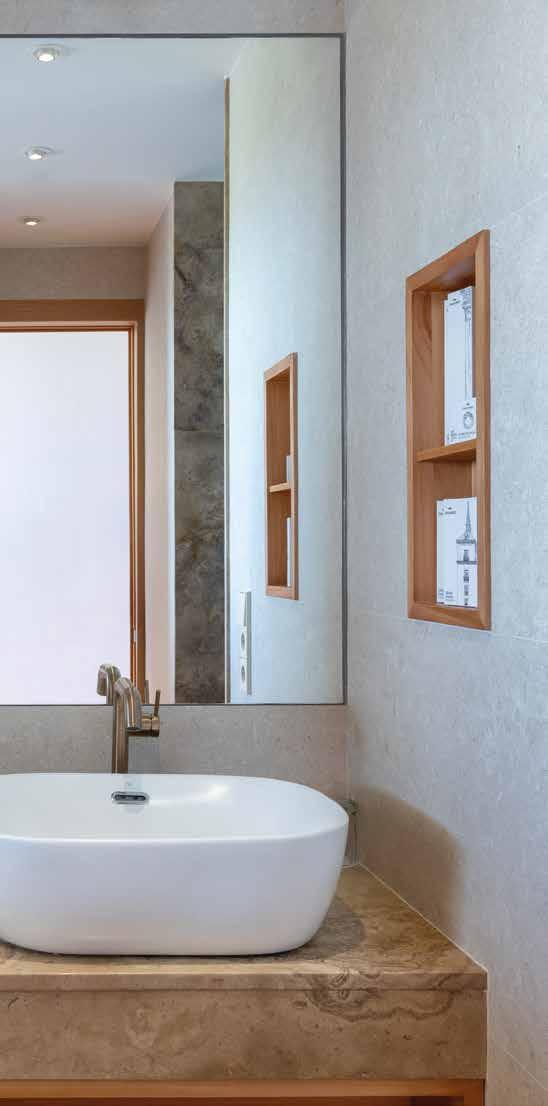
La propuesta cosmética está a la altura de los elevados estándares propios de Paradores. No hay sulfatos ni parabenos en su formulación, de modo que son aptos también para niños, más sensibles a estas cuestiones. También se han rediseñado los artículos complementarios para mejorar su ergonomía, como los cepillos dentales o las maquinillas de afeitar. Además, en las habitaciones más especiales, los clientes disfrutarán de la gama The Lab Room, marca española que complementa la experiencia de estancia con una propuesta cuidada al detalle. Son productos que cuentan con la certificación Ecolabel, un sello, reconocido a nivel europeo, que garantiza su respeto a la salud humana y al medioambiente. /
The cosmetic range meets the high standards typical of Paradores. There are no sulphates nor parabens in its formulation, making it suitable for children, who are more sensitive to such concerns. The complementary items have also been redesigned to improve their ergonomics, such as the toothbrushes and razors. Additionally, in the most special rooms, guests will enjoy the The Lab Room range, a Spanish brand that enhances the stay experience with a carefully crafted proposal.
These products are certified with the Ecolabel, a seal recognized across Europe that ensures respect for both human health and the environment.
De cara a incentivar la responsabilidad en el consumo, la nueva política de prestación de estos servicios permite al cliente acceder a más productos, de forma personalizada y eficiente. A través de un QR en la habitación, los huéspedes pueden consultar la oferta completa y solicitar fácilmente los artículos deseados: peine, set dental, pasta dentífrica, set de afeitado o cepillo de pelo, entre otros.

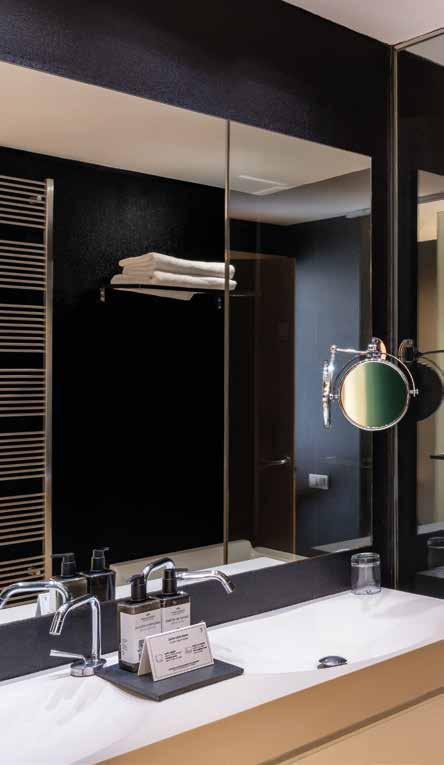
In order to encourage responsible consumption, the new policy for providing these services allows guests to access more products, in a personalized and efficient way. Through a QR code in the room, guests can view the full range of offerings and easily request the desired items: comb, dental kit, toothpaste, shaving kit, or hairbrush, among others.
Desde 2022, Paradores forma parte de la Iniciativa Mundial sobre Turismo y Plásticos (Global Tourism Plastics Initiative), promovida por el Programa de Turismo Sostenible One Planet, liderado por la Organización Mundial del Turismo (OMT) y el Programa de las Naciones Unidas para el Medio Ambiente, en colaboración con la Fundación Ellen MacArthur. A través de esta alianza, se compromete a reducir progresivamente el uso de plásticos innecesarios o de un solo uso, promover modelos reutilizables e incorporar contenido reciclado en los envases, contribuyendo así a una economía circular del plástico en el sector turístico.
Since 2022, Paradores has been part of the Global Tourism Plastics Initiative, promoted by the One Planet Sustainable Tourism Programme, led by the World Tourism Organization (UNWTO) and the United Nations Environment Programme, in collaboration with the Ellen MacArthur Foundation. Through this alliance, Paradores is committed to progressively reducing the use of unnecessary or single-use plastics, promoting reusable models, and incorporating recycled content in packaging, thus contributing to a circular plastic economy in the tourism sector.
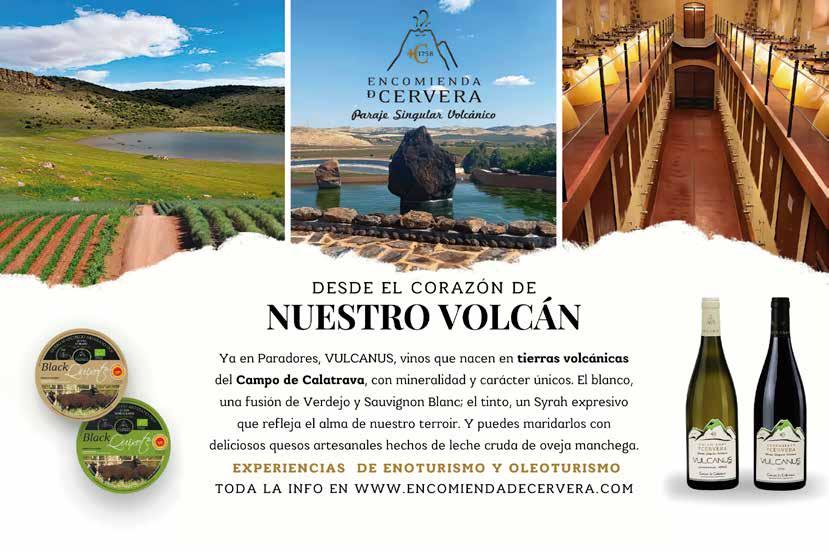
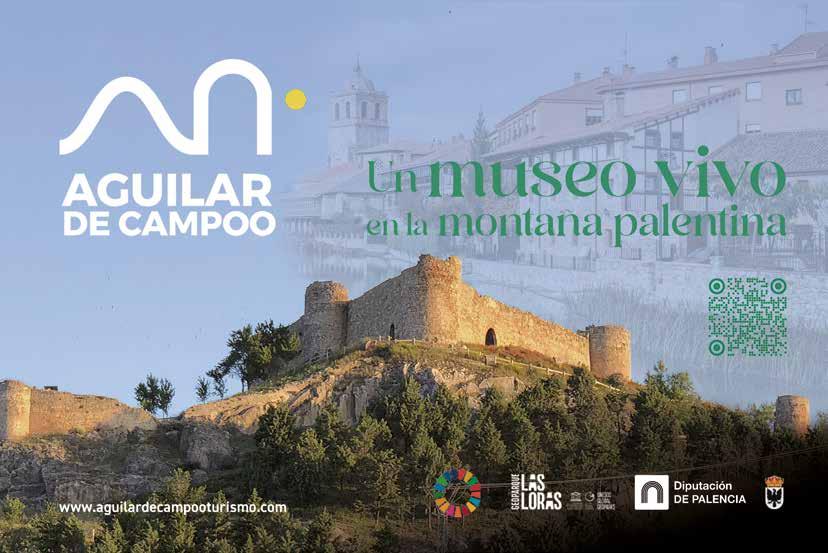
DESIRÉ ALIJA

«Hubo un momento en que se escuchó un clic, y no era el disparo de una cámara. Eran las neuronas despertando y mirando hacia el lado opuesto al que están acostumbradas». Así resume Lucía Herrero una de las escenas más reveladoras vividas durante el reciente Photowalk 2025, organizado en el Parador de Sos del Rey Católico. /
“There was a moment when a click was heard, and it wasn’t the shutter of a camera. It was the neurons waking up and looking towards the opposite side from where they are used to.” This is how Lucía Herrero sums up one of the most revealing scenes experienced during the recent Photowalk 2025, organized at the Parador of Sos del Rey Católico.
Más que una fotógrafa, Herrero es una narradora visual, una creadora que combina arquitectura, teatro físico y antropología para construir imágenes con alma. Su estilo –al que denomina «Antropología Fantástica»– se sitúa en una intersección entre lo documental y lo escenificado, una mirada a través de la lente que transforma lo común en extraordinario, y que ha conquistado museos, festivales internacionales y publicaciones de prestigio.
Durante las tres jornadas del Photowalk, un grupo de aficionados a la fotografía vivieron una intensa inmersión creativa en el entorno del Parador de Sos del Rey Católico. Acompañados por Herrero, los participantes se embarcaron en un proceso vertiginoso de creación colectiva que dio lugar a tres miniseries fotográficas, cada una con una narrativa propia, nacida del impulso y la intuición. «La idea era someterlos a una creación intensiva y en tiempo récord», explica la fotógrafa. «Generar en ellos la urgencia y la obsesión que nos caracteriza a los artistas. Sacarlos de su zona de confort y empujarlos al abismo de su propia creatividad». Y lo logró, con creces.
More than a photographer, Herrero is a visual storyteller, a creator who blends architecture, physical theatre, and anthropology to craft images with soul. Her style –which she calls “Fantastic Anthropology”– sits at the intersection of documentary and staged work, a lens that transforms the ordinary into the extraordinary, and has won her accolades in museums, international festivals, and prestigious publications.
During the three days of Photowalk, a group of photography enthusiasts experienced an intense creative immersion in the environment of the Parador of Sos del Rey Católico. Accompanied by Herrero, participants embarked on a dizzying process of collective creation that resulted in three photographic miniseries, each with its own narrative, born from impulse and intuition. “The idea was to subject them to intensive creation and within a record time,” the photographer explains. “To generate the urgency and obsession that characterizes artists. To take them out of their comfort zone and push them to the abyss of their own creativity.” And she succeeded, with flying colours.
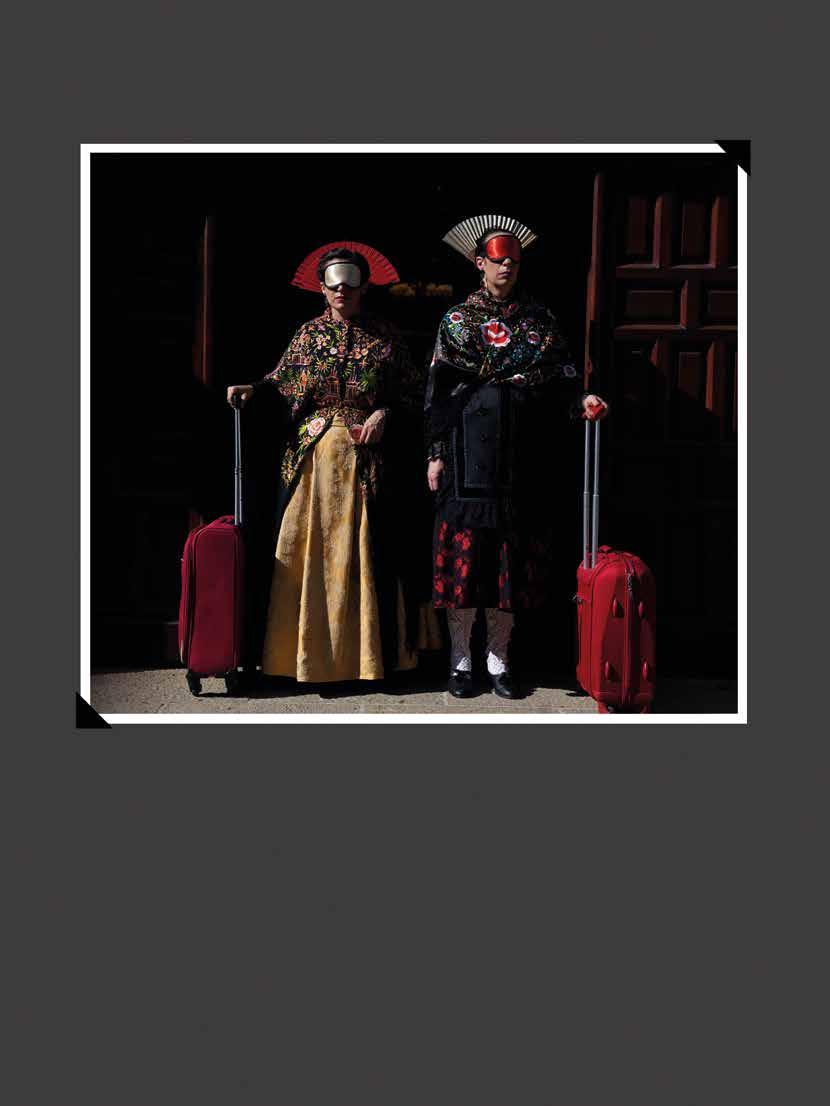
PARADORES CONVIERTE SOS DEL REY CATÓLICO EN UN PLATÓ DE REALISMO MÁGICO CON LUCÍA HERRERO
Los asistentes recorrieron el entorno histórico y natural de la comarca de las Cinco Villas, abordando todas las fases del proceso creativo, desde la gestación conceptual hasta la edición final de sus imágenes. Se les otorgó plena libertad para utilizar el equipo de su elección –desde cámaras réflex o mirrorless, hasta teléfonos móviles–, primando en todo momento la expresividad personal por encima de la destreza técnica. Más que un taller técnico, esta actividad supuso un viaje interior y compartido para Lucía Herrero: «traje un formato de alto impacto creativo, diseñado para sacudir al participante, para activar su imaginación desde un lugar más visceral e instintivo», comenta. «A mis alumnos les propuse crear una mala historia y alejarse lo máximo posible de un premio Pulitzer. Eso les relajó. A partir de entonces no tuvieron inconveniente en conectar y dejarse llevar por su intuición».
The participants toured the historical and natural surroundings of the Cinco Villas region, addressing all phases of the creative process, from conceptualization to the final editing of their images. They were given full freedom to use their equipment of choice –from DSLR or mirrorless cameras to mobile phones–with personal expression always taking precedence over technical skill. More than a technical workshop, this activity was an inner and shared journey for Lucía Herrero: “I brought a format with high creative impact, designed to shake the participant, to activate their imagination from a more visceral and instinctive place,” she comments. “I asked my students to create a ‘bad story’ and move as far away from a Pulitzer Prize as possible. That relaxed them. From then on, they had no trouble connecting and letting themselves be guided by their intuition.”
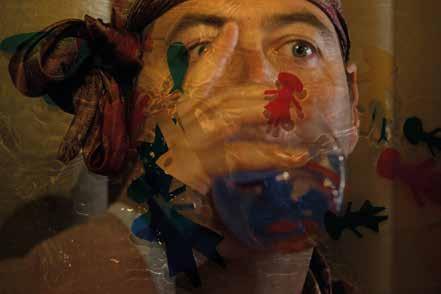
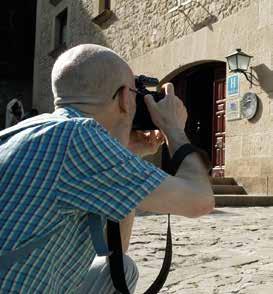
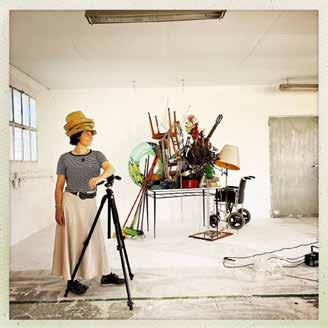

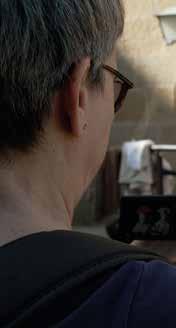
Traje un formato de alto impacto creativo, diseñado para sacudir al participante, para activar su imaginación desde un lugar más
El resultado: tres relatos visuales únicos, nacidos de una mirada renovada, donde lo más bello fue atestiguar ese viaje sutil, pero profundo, desde el territorio de la normalidad hacia el paisaje luminoso de la creación libre e intuitiva. Para Herrero, el escenario no es un mero fondo, sino un cómplice.
Paradores no solo ofreció una localización privilegiada, sino también un equipo humano implicado y una comunidad local abierta a la experiencia. Vecinos convertidos en personajes medievales y baturros aportaron autenticidad y riqueza visual a las historias.
«Siento un cariño especial por la red de Paradores. Su labor de recuperación del patrimonio arquitectónico e histórico, así como su implicación en la dinamización del mundo rural, conectan de forma natural con mi visión artística y mi forma de entender el territorio», afirma la fotógrafa.
El encanto de este paraje, unido a la metodología de Herrero, no dejaron a nadie indiferente: invitaron a jugar, a improvisar, a leer el entorno como quien interpreta un poema. «Trabajo con personas reales que se prestan como modelos voluntarios para

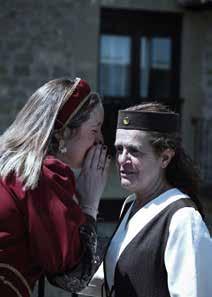
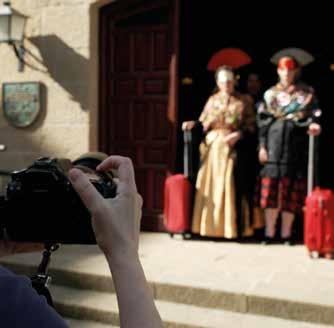
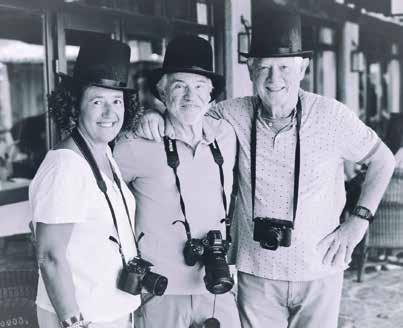
The result: three unique visual stories, born from a renewed perspective, where the most beautiful thing was witnessing the subtle but profound journey from the realm of normality to the luminous landscape of free and intuitive creation. For Herrero, the setting is not just a backdrop, but an accomplice.
Paradores not only provided a privileged location, but also a dedicated human team and a local community open to the experience. Neighbours transformed into medieval characters and traditional baturros added
authenticity and visual richness to the stories. “I feel a special affection for the Paradores network. Their work in the recovery of architectural and historical heritage, as well as their involvement in revitalizing rural areas, naturally aligns with my artistic vision and my way of understanding the territory,” says the photographer.
The charm of this landscape, combined with Herrero’s methodology, left no one indifferent: they invited people to play, to improvise, to read the surroundings as if they were interpreting a poem. “I work with real people who
I brought a format with high creative impact, designed to shake the participant, to activate their imagination from a more visceral and instinctive place
interpretarse a sí mismas, lo que genera imágenes cargadas de verdad, teatralidad y sentido. Es mi camino creativo». Esa filosofía impregnó cada instante. «Vi a los participantes correr obsesionados fotografiando baturros y medievales. Era como si, por un rato, se hubieran convertido en mí», ríe.
En su trabajo, todo puede ser materia prima: la luz más humilde, un rostro anónimo, o una plaza cualquiera. «Toda luz es buena», repite a sus alumnos. «Lo esencial no es tener lo ideal, sino saber leer lo que tienes delante y trabajar con ello». De esa lectura nace una fotografía que es relato, que contiene estadística emocional, memoria simbólica y poesía popular. «La historia ya está ahí… solo hay que sacarla al exterior», afirma.
El Photowalk de Paradores ha sido para ella un punto de inflexión. «He descubierto que tengo mucho que entregar y que ha llegado el momento de hacerlo más a menudo», confiesa. Con su «Antropología Fantástica» como guía, Lucía Herrero no solo enseña a mirar: enseña a ver. Y esa diferencia es, como su trabajo, profundamente transformadora.
Siento
un cariño especial por la red de Paradores. Su labor de recuperación del patrimonio arquitectónico e histórico, así como su implicación en la dinamización del mundo rural, conectan de forma natural con mi visión artística y mi forma de entender el territorio
Esa transformación no solo alcanzó a la artista, sino que impregnó cada detalle de la experiencia vivida por los participantes. Como parte integral del encuentro, disfrutaron de dos noches de alojamiento en el Parador y de una propuesta gastronómica cuidadosamente diseñada en torno a la tradición culinaria local. Además, las obras resultantes fueron posteriormente difundidas a través de los canales digitales de Paradores, consolidando así el vínculo entre creación artística y patrimonio cultural.
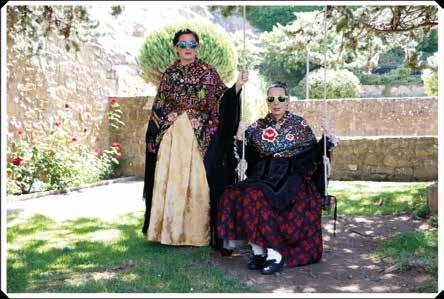
volunteer as models to portray themselves, which creates images full of truth, theatricality, and meaning. It’s my creative path.” That philosophy permeated every moment. “I saw the participants running, obsessed with photographing baturros and medieval characters. It was as if, for a while, they had become me,” she laughs.
In her work, everything can be raw material: the humblest light, an anonymous face, or any random square. “All light is good,” she repeats to her students. “The essential thing is not having the ideal but knowing how to read what you have in front of you and work with it.” From that reading emerges a photograph that tells a story, containing emotional statistics, symbolic memory, and popular poetry. “The story is already there... you just have to bring it to the surface,” she says.
The Paradores Photowalk has been a turning point for her. “I’ve discovered that I have so much to give, and that the time has come to do it more often,” she confesses. With her “Fantastic Anthropology” as a guide, Lucía Herrero not only teaches how to look: she teaches how to see. And that difference is, like her work, deeply transformative.
This transformation not only reached the artist but also infused every detail of the experience lived by the participants. As an integral part of the encounter, they enjoyed two nights of accommodation at the Parador and a gastronomic proposal carefully designed around the local culinary tradition. Additionally, the resulting works were later shared through Paradores’ digital channels, thus consolidating the link between artistic creation and cultural heritage.
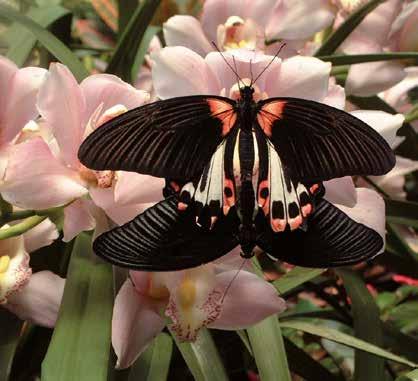

La mariposa nace para procrear, esa es su misión, pero ¿cómo reconoce a su pareja? Lo hacen mediante el olor utilizando un perfume para atraer al sexo contrario, las feromonas. Para que no haya error, cada especie utiliza un perfume diferente.
Las feromonas son tan potentes que bastan 200 moléculas de feromona femenina por cm3 de aire para que el macho la detecte. Esto equivaldría a 100 litros de afrodisiaco disueltos en todos los océanos del planeta.
La mariposa hembra se aparea una sola vez en su
vida. Por el contrario el macho suele aparearse con diferentes hembras. La cópula puede durar desde varios minutos hasta dos días. Durante la cópula pueden volar, pero sólo una de ellas lo hace, la otra se deja llevar. Normalmente la que vuela es la hembra.
Calle Muérdago s/n (Junto a Templo Budista) · Benalmádena - Málaga
951 211 196 | www.mariposariodebenalmadena.com

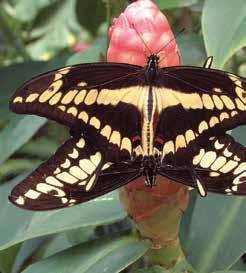


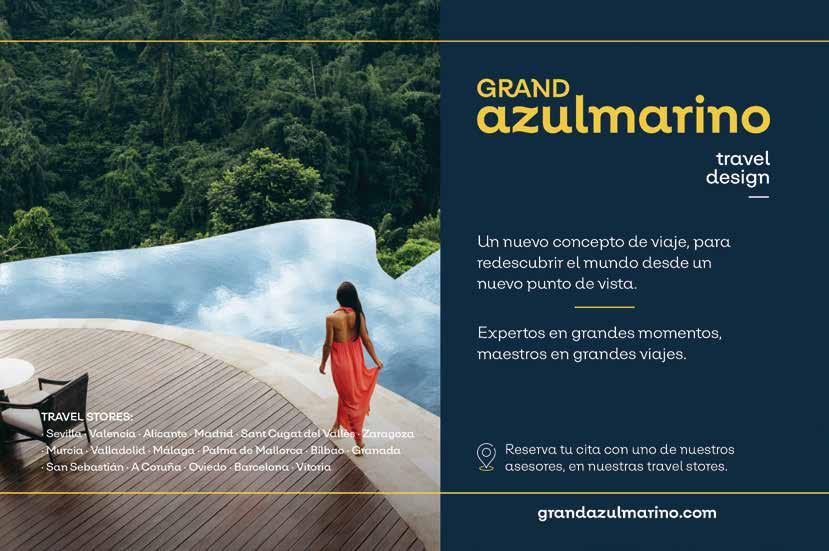
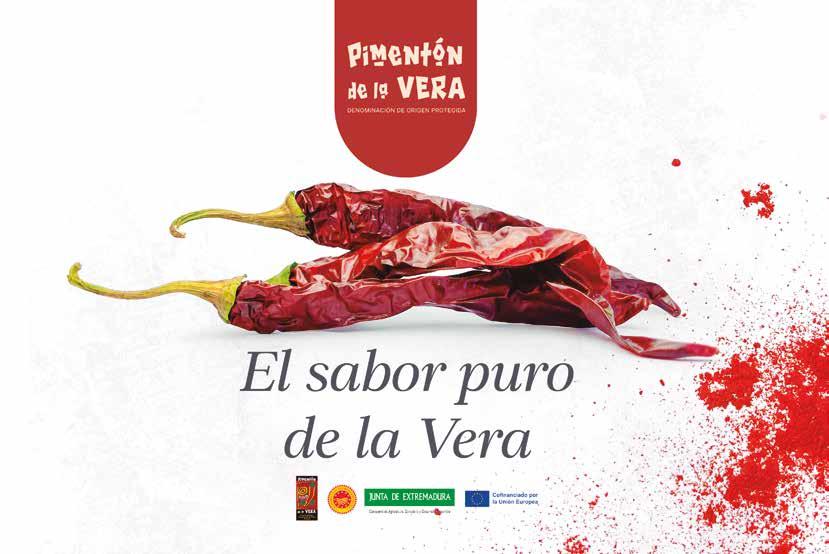
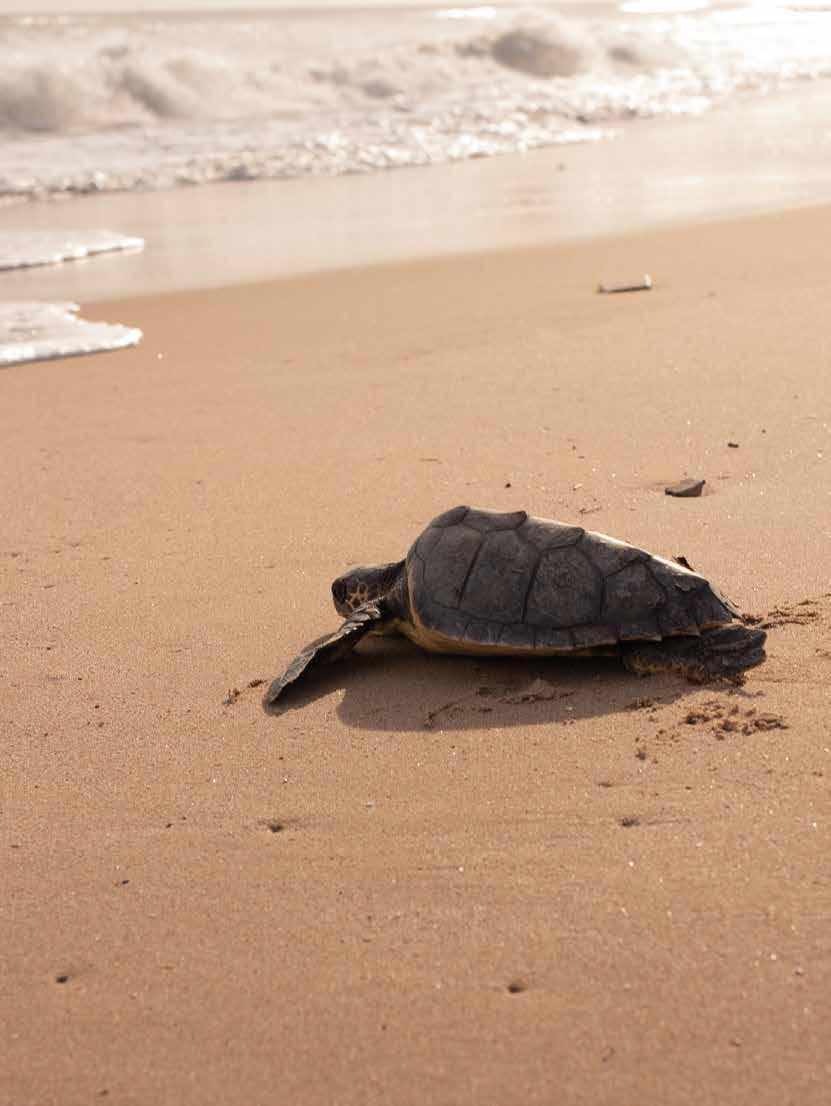
PARADORES Y FUNDACIÓN OCEANOGRÀFIC, UNA ALIANZA POR LOS OCÉANOS
Cada vez que un huésped atraviesa el umbral de un Parador, se adentra también en un compromiso sereno y profundo: habitar el paisaje con respeto y cuidar lo que nos cuida. Ese pacto con el entorno suma un nuevo capítulo gracias a la renovación de la alianza entre Paradores y la Fundación Oceanogràfic de la Comunitat Valenciana. Bajo el lema «El mar empieza aquí», ambas instituciones reafirman su vocación común: sensibilizar desde la belleza, educar desde la experiencia y actuar frente a uno de los desafíos más acuciantes de nuestro tiempo –la contaminación por plásticos– que amenaza la vida en los mares.
Every time a guest crosses the threshold of a Parador, they also step into a calm and profound commitment: to inhabit the landscape with respect and to care for what takes care of us. This pact with the environment adds a new chapter with the renewal of the alliance between Paradores and the Oceanographic Foundation of the Valencian Community. Under the motto “The sea starts here,” both institutions reaffirm their shared mission: to raise awareness through beauty, to educate through experience, and to act against one of the most pressing challenges of our time –plastic pollution– which threatens life in the seas.

Puede pensarse que el mar comienza allí donde la arena se encuentra con la espuma, en las orillas abiertas al horizonte. No es así. Empieza mucho antes, en cada gesto cotidiano, en cada colilla arrojada al suelo o en cada envoltorio que el viento arrastra hasta una alcantarilla. El 80% de los residuos que ahogan nuestros océanos nacen tierra adentro y viajan sin permiso hasta los estuarios, los deltas y el mar abierto.
Con esta certeza como brújula, Paradores y la Fundación Oceanogràfic renuevan su alianza para desplegar la campaña «El mar empieza aquí», una invitación a mirar con otra profundidad lo que nos rodea. Desde este verano, los 98 establecimientos de la Red se convierten en puntos de luz y conciencia, albergando materiales didácticos y señales que invitan a reducir, reutilizar y reciclar. Cartelería integrada en arquitectura, códigos QR que abren ventanas
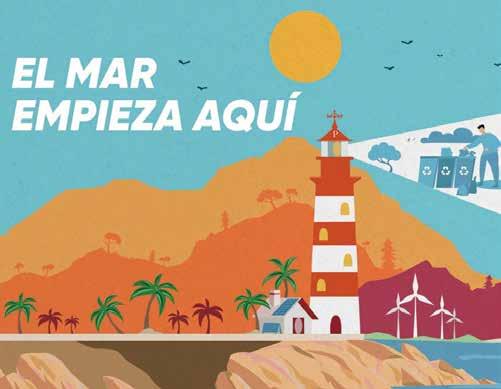
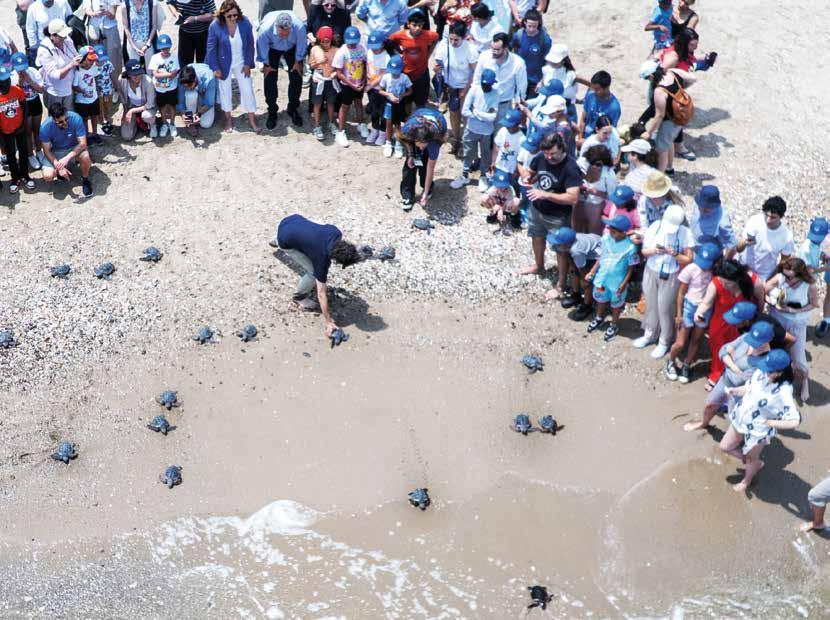

It can be thought that the sea begins where the sand meets the foam, on shores open to the horizon. But that’s not the case. It begins much earlier, in every daily gesture, in every cigarette butt thrown on the ground or in every wrapper carried by the wind to a drain. 80% of the waste that suffocates our oceans originates inland and travels without permission to estuaries, deltas, and the open sea.
With this certainty as compass, Paradores and the Oceanographic Foundation renew their alliance to launch the “The Sea Begins Here” campaign, an invitation to look more deeply at what surrounds us. Starting this summer, the 98 establishments in the Paradores network become points of light and awareness, hosting educational materials and signs that invite reducing, reusing, and recycling. Signs integrated into the architecture, QR

80% of marine waste originates on land

a la participación familiar o propuestas lúdicas que hacen del aprendizaje una aventura, componen el hilo narrativo de esta campaña.
Este compromiso trasciende el espacio físico de los establecimientos y se proyecta en canales digitales, publicaciones institucionales y acciones de impacto directo, como las limpiezas de playas promovidas por la Fundación Oceanogràfic junto a Paradores de la Comunitat Valenciana. Una manera tangible de convertir la conciencia en acción.
El convenio –suscrito el pasado 21 de mayo por Raquel Sánchez Jiménez, presidenta de Paradores, y Leocadia Ana García Bartual, gerente de la Fundación Oceanogràfic– consolida una década de colaboración en favor
de la sostenibilidad, la divulgación científica y la educación ambiental.
Este año, la campaña se adentra aun más en la vivencia compartida, con especial énfasis en el ámbito familiar.
A través de actividades autoguiadas, juegos participativos y pequeños gestos cotidianos, los niños descubren que una botella desechada sin cuidado puede acabar entre continentes
flotando en silencio, y al hacerlo, invitan también a los adultos a cuestionarse y a tomar acción.
«El mar empieza aquí» no es un eslogan, sino una certeza. Un recordatorio de que todo lo que ocurre bajo nuestros pies tiene eco en el agua. Paradores ha elegido ser parte de esta corriente que cuida, preserva y despierta.


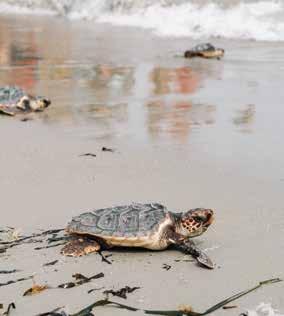

codes that open windows to family participation, and playful proposals that turn learning into an adventure, all weave the narrative thread of this campaign
This commitment transcends the physical space of the establishments and extends into digital channels, institutional publications, and direct impact actions, such as the beach cleanups promoted by the Oceanographic Foundation alongside Paradores in the Valencian Community. A tangible way to turn awareness into action.
This year, the campaign goes even further into shared experience, with special emphasis on the family sphere. Through self-guided activities, participatory games, and small daily gestures, children discover that a discarded bottle, carelessly thrown, can end up floating between continents in silence, and in doing so, they also invite adults to question and take action.
“The sea starts here” is not just a slogan, but a certainty. A reminder that everything happening under our feet echoes in the water. Paradores has chosen to be part of this current that cares, preserves, and awakens.
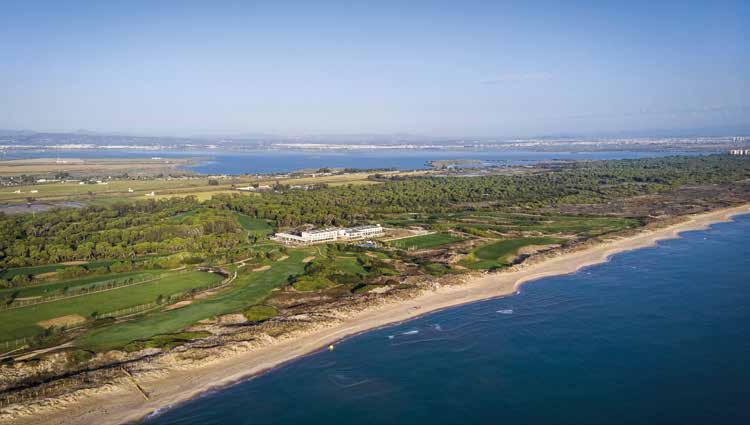
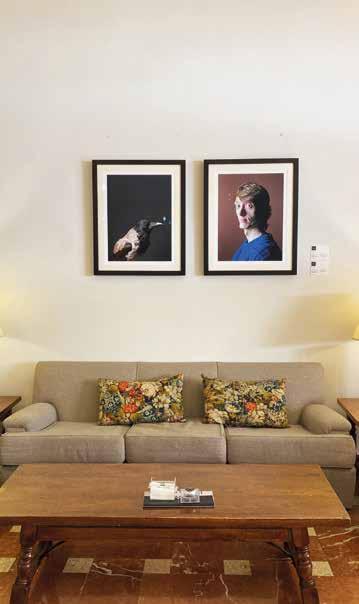
Día Mundial de la Tapa en Paradores
Con motivo del Día Mundial de la Tapa, Paradores ha preparado un año más una selección de aperitivos tradicionales para cada región con producto de proximidad. Siguiendo con su labor de embajadores de la marca España, cada establecimiento agasaja a sus clientes con una tapa gratuita para acercar y homenajear esta tradición gastronómica tan arraigada en el país.
El Parador de Tordesillas ha recibido veinticuatro obras de la colección Doce fotógrafos en el Museo del Prado como parte de un nuevo proyecto artístico que homenajea a Juana I de Castilla, insignia de la historia del municipio y de todo el país. Firmadas por artistas como Joan Fontcuberta, Alberto García-Alix, Chema Madoz, Isabel Muñoz, Pilar Pequeño o Javier Vallhonrat, complementan la inversión de 3,4 millones de euros realizada para mejorar la eficiencia energética.
The art of El Prado in Paradores
The Parador of Tordesillas has received twenty-four works from the collection Twelve Photographers at the Museo del Prado as part of a new artistic project that honours Juana I of Castile, a key figure in the history of the town and the country. Signed by artists such as Joan Fontcuberta, Alberto García-Alix, Chema Madoz, Isabel Muñoz, Pilar Pequeño, and Javier Vallhonrat, these works complement the 3.4 million euros investment made to improve energy efficiency.
On the occasion of World Tapas Day, Paradores has once again prepared a selection of traditional appetizers for each region, using local products. Continuing its role as ambassadors of the Spain brand, each establishment treats its guests to a complimentary tapa, bringing them closer to and honouring this deeply rooted gastronomic tradition in the country.
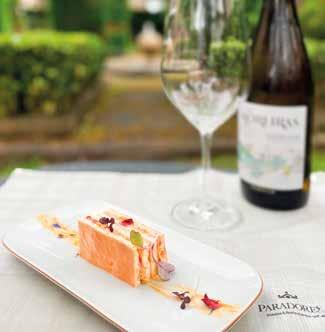
El ministro de Industria y Turismo Jordi Hereu anuncia una inversión de treinta millones de euros para ampliar el Parador de León. El proyecto incluye la construcción de un nuevo edificio, conectado al ya existente, que contará con cincuenta nuevas habitaciones, gimnasio, piscina y grandes salones para responder a la creciente demanda, en especial centrada en el turismo de eventos. Esta nueva apuesta por el Parador leonés se suma a los trabajos de restauración que se están llevando a cabo en la actualidad en el edificio histórico, financiados con fondos Next Generation.
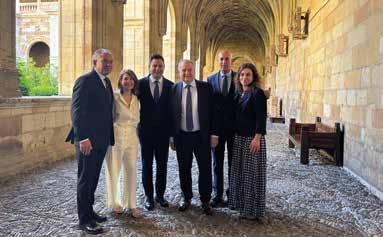
Minister of Industry and Tourism Jordi Hereu announces a 30-million-euro investment to expand the Parador of León. The project includes the construction of a new building, connected to the existing one, which will feature fifty new rooms, a gym, a swimming pool, and large lounges to meet the growing demand, particularly focused on event tourism. This new investment in the Parador of León complements the ongoing restoration work on the historic building, funded by Next Generation funds.
El Parador de Oropesa ha recibido una inversión de doce millones de euros para labores de restauración y rehabilitación de su patrimonio y sus instalaciones. Esta inyección, que proviene de fondos de la red –3,8 millones de euros– y Turespaña –8,5 millones de euros de fondos del Plan de Recuperación, Transformación y Resiliencia–, forma parte del plan de transformación de Paradores para su centenario, que incluye proyectos de reforma para el 50 % de sus edificios con un presupuesto total de más de 250 millones de euros.
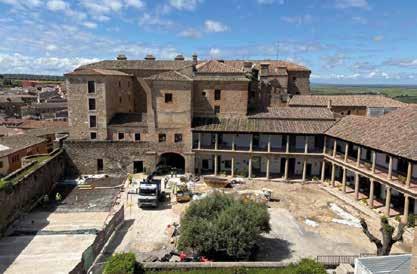
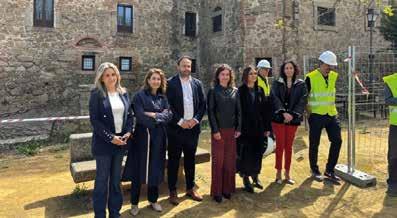
The Parador of Oropesa has received a 12-million-euro investment for restoration and rehabilitation work on its heritage and facilities. This funding, which comes from the network’s funds –3.8 million euros– and from Turespaña –8.5 million euros from the Recovery, Transformation, and Resilience Plan– is part of Paradores’ transformation plan for its centenary, which includes renovation projects for 50% of its buildings, with a total budget of over 250 million euros.
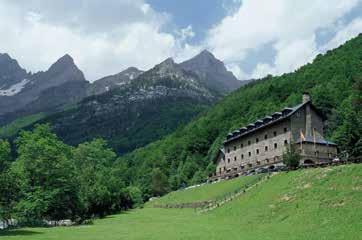
El Parador de Bielsa ha sido reconocido por su compromiso con el turismo sostenible en Aragón con el Premio Edelweiss en la categoría de Alojamiento Turístico. El Parador de Turismo Monte Perdido, de Bielsa (Huesca) ha sido reconocido con el Premio Edelweiss en la categoría de Alojamiento Turístico de Aragón en la quinta edición de estos galardones que otorga anualmente el Clúster de Turismo Sostenible de Aragón (TSAC), una asociación de empresas del sector turístico y entidades vinculadas al mismo, cuyo fin es la promoción, formación e innovación en el ámbito del turismo sostenible.
The Parador of Bielsa was recognized for its commitment to sustainable tourism in Aragón with the Edelweiss Award in the category of Tourist Accommodation. The Parador of Monte Perdido, in Bielsa (Huesca), has received the Edelweiss Award in the Tourist Accommodation of Aragón category, as part of the fifth edition of these annual prizes granted by the Aragón Sustainable Tourism Cluster (TSAC), an association of tourism-sector companies and related entities dedicated to promoting, training, and innovating in the field of sustainable tourism.
Paradores recibió el premio de los lectores de Viajes National Geographic2025 al mejor proyecto de sostenibilidad turística. El reconocimiento ha sido fruto de un extenso trabajo de la Red para reducir su huella medioambiental, que pasa por el logro de la certificación Ecostar para todos sus establecimientos, su incansable apuesta por el producto de proximidad y kilómetro 0 y su programa de Ecoturismo «Naturaleza para los sentidos». El secretario general de Paradores, Ricardo Mar, ha afirmado que «para nosotros, la sostenibilidad no es únicamente una obligación ética o normativa; es, ante todo, una valiosa oportunidad para generar valor».
Paradores received the readers’ award from Viajes National Geographic 2025 for the best sustainable tourism project. The recognition is the result of extensive work by the network to reduce its environmental footprint, including the achievement of the Ecostar certification for all its establishments, its continuous commitment to local products, and its ecotourism program “Nature for the senses.” The Secretary General of Paradores, Ricardo Mar, stated that “for us, sustainability is not just an ethical or regulatory obligation; above all, it is a great opportunity to create value.”
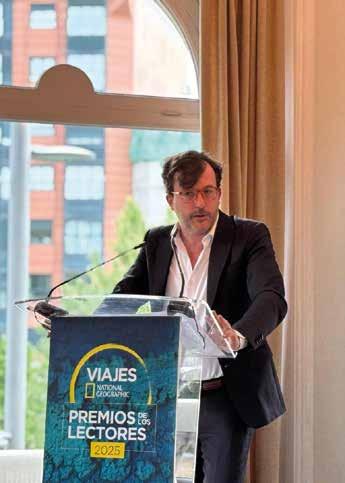

El Parador de El Saler ha recibido el Premio en Sostenibilidad Ambiental de la Capital Verde Europea de manos de la Fundació Visit València. El reconocimiento ha señalado su labor de más de una década de protección del entorno privilegiado en el que se encuentran. Este establecimiento ha desarrollado numerosos proyectos de eficiencia energética, recuperación de especies en peligro de extinción y gestión de residuos, entre otros, que le han situado como referente del turismo respetuoso y sostenible en la región.
The Parador of El Saler received the Environmental Sustainability Award from the European Green Capital, presented by the Visit València Foundation. The recognition highlights more than a decade of commitment to protecting the exceptional natural surroundings in which it is located. The Parador has implemented numerous projects in energy efficiency, endangered species recovery, and waste management, establishing itself as a benchmark for respectful and sustainable tourism in the region.
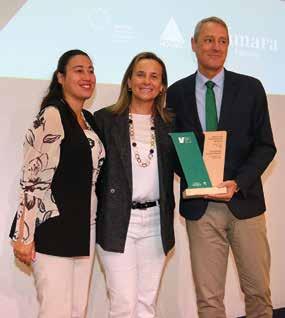
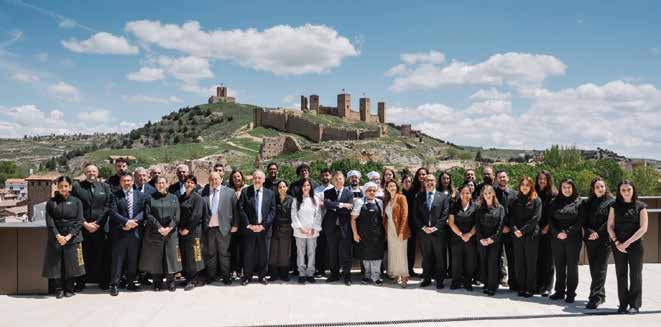
Desde el 14 de mayo, el Parador de Molina de Aragón se ha sumado a la red de Paradores, que ya cuenta con 98 establecimientos en todo el país –nueve en Castilla-La Mancha–. Este nuevo proyecto, que sitúa a la Red más cerca de su objetivo de contar con cien alojamientos para su centenario en 2028, ha sido posible gracias a una inversión de veintidós millones de euros aportados principalmente por Turespaña. La presidenta de Paradores, Raquel Sánchez, afirma que esta apertura es un claro ejemplo de que «lo público puede y debe llegar donde no llega la iniciativa privada».
Since May 14th, the Parador of Molina de Aragón has joined the Paradores network, which now includes 98 establishments across the country, nine of them in Castilla-La Mancha. This new project, which brings the network closer to its goal of reaching one hundred accommodations by its centenary in 2028, has been made possible thanks to a 22-million-euro investment, mainly provided by Turespaña. The President of Paradores, Raquel Sánchez, states that this opening is a clear example of how “the public sector can and must reach where the private initiative does not.”
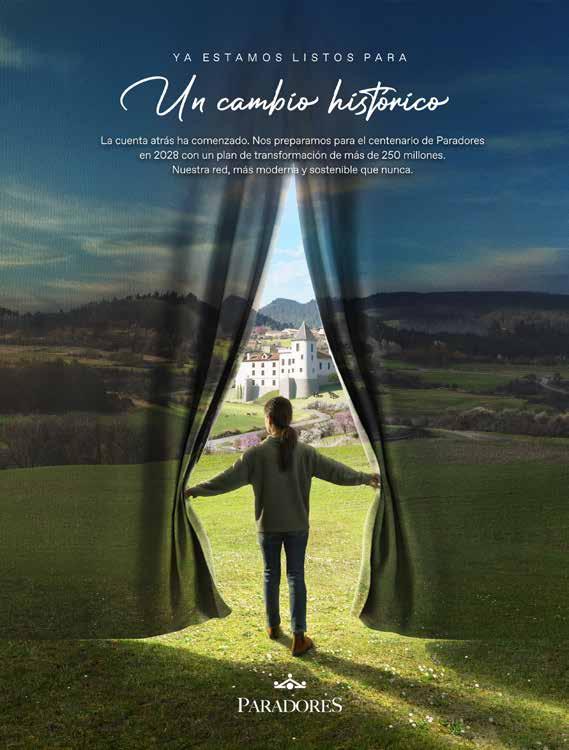
«Ya estamos listos para un cambio histórico» es el lema de la nueva imagen de marca que presenta Paradores. Con ella, la Red pretende poner en valor la gran inversión que está realizando para adaptarse a los nuevos tiempos, creando un modelo más moderno, sostenible y conectado con el viajero del siglo xxi, pero manteniendo su espíritu. La creatividad es obra del artista Mikel Cámara, que ha querido combinar el realismo mágico con la esencia patrimonial de Paradores a través de un gran telón que desvela la nueva era de la Red.
“We are ready for a historic change” is the slogan of the new brand image presented by Paradores. With it, the network aims to highlight the significant investment being made to adapt to modern times, creating a more modern, sustainable model that connects with the 21st-century traveller while maintaining its essence. The creativity is the work of artist Mikel Cámara, who sought to combine magical realism with the heritage essence of Paradores through a large curtain that unveils the new era of the network.
Con el lema «Paradores es otro mundo. Donde el verano fluye al ritmo de tus emociones», la hotelera ha presentado su campaña de verano, con descuentos para los meses de junio, julio y agosto. La imagen de marca de la temporada estival viene de la mano de Óscar Llorens, artista madrileño que refleja su particular universo veraniego en este trabajo.

With the slogan “Paradores is another world where summer flows to the rhythm of your emotions,” the hotel chain has presented its summer campaign, offering discounts for the months of June, July, and August. The brand image for the summer season comes from Madrid artist Óscar Llorens, who reflects his unique summer universe in this work.
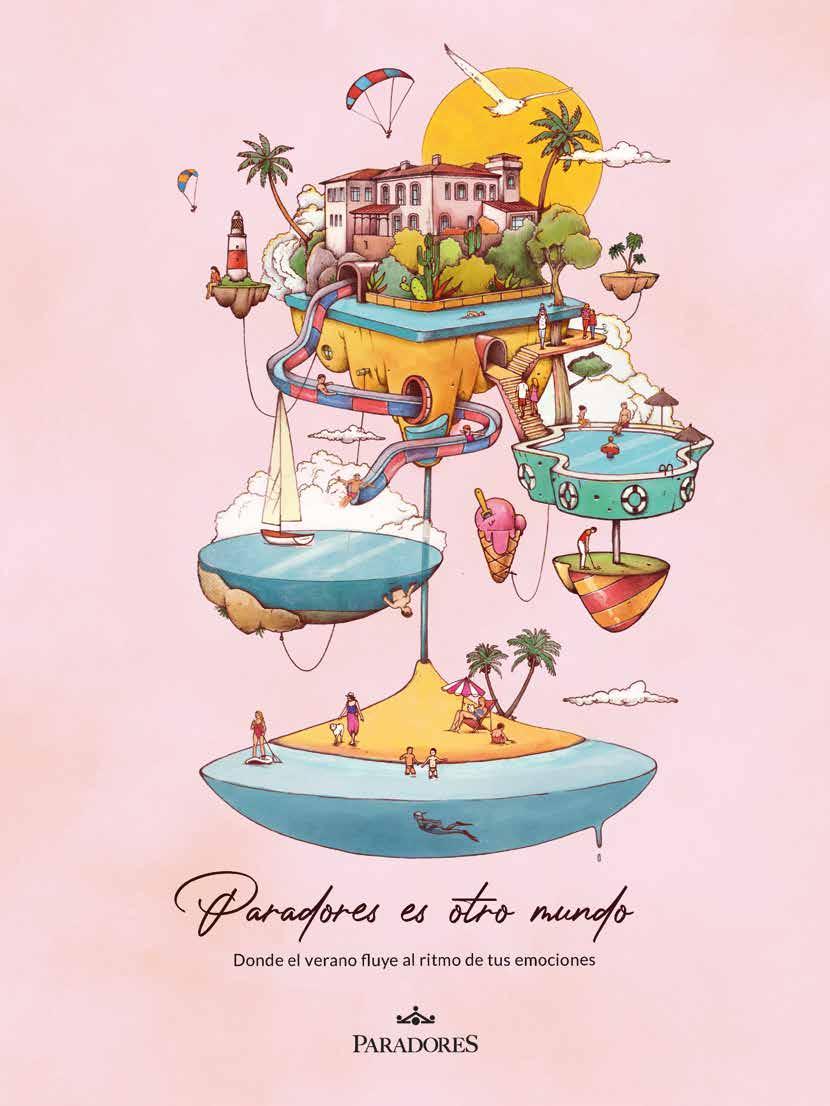
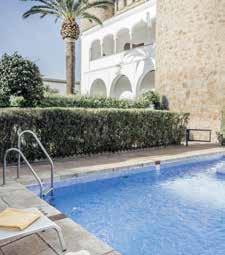
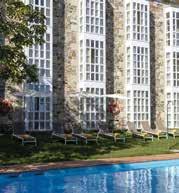
02
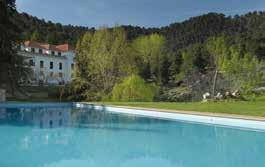
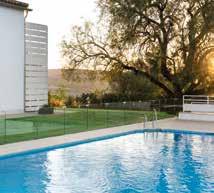
04 03
¡Atrévete y participa! Si conoces las respuestas, remite la solución al correo electrónico antes del 30 de septiembre de 2025: prensa@parador.es
No olvides aportar el nombre completo, DNI y un número de teléfono. Entre las respuestas acertadas, Paradores sorteará una estancia de dos noches para dos personas en habitación estándar y régimen de alojamiento y desayuno *
Dare to participate! if you know answers, forward the following email address before September 30, 2025: prensa@parador.es
Ganador/Winner:
Félix Senís Díaz
P. de Vic-Sau
P. de Olite
P. Santo Domingo de la Calzada
P. de Limpias
Encontrar rincones perfectos alejados del bullicio habitual de la costa, es más fácil con Paradores. ¿Dónde se ubican estas sugerentes piscinas?
Finding perfect corners away from the usual hustle and bustle of the coast is easier with Paradores. Where are these dreamy pools located?
Do not forget to provide your full name, identity card number and a telephone number. Among the correct answers, Paradores will ra e a two night stay for two people in a standard room, on bed and breakfast basis*.

